What Bad Writing Looks Like … and How to Fix It [With Detailed Examples]
29 Mar 2021 | Craft
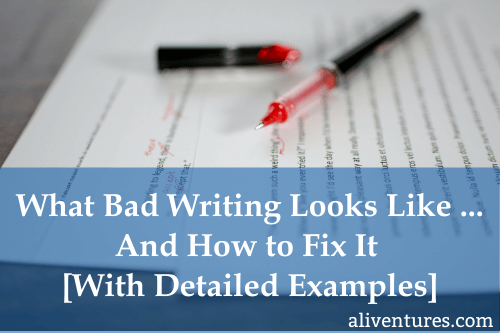
A lot of writers worry that they may not be good enough to be successful .
The truth is that however “good” or “bad” your writing is, you can improve with practice and with careful self-editing .
But how do you know if a particular piece of writing is any good? What exactly does “bad” writing look like … and how do you fix it?
That’s what we’re going to tackle today.

Is There Even Such a Thing As “Good” Writing?
Over many years of reading and writing, I’ve heard two different schools of thought about “good” writing.
“Lots of Popular Books Are Really Badly Written”
Some people, particularly journalists and literary critics, can be incredibly judgemental about popular books. The Twilight series, Dan Brown’s books, or Fifty Shades of Grey are ones that have come in for particular criticism.
These books might not be “good” in a literary sense – they’re unlikely to go down in history as great works of art – but they certainly do well commercially. Plenty of people enjoy them as entertainment or escapism.
There is nothing wrong with this.
Personally, I enjoy a lot of books that are considered literary fiction or classics – I studied English Literature as an undergraduate. But I also enjoy plenty of genre and commercial fiction, and I’ve read my share of fanfiction too. I’ve enjoyed all of it, in different ways.
Please don’t think that your writing is bad because it’s not literary, even if the people around you (in your family, your friendship group, or at school or university) only prize literary fiction.
“There’s No Such Thing as Good or Bad Writing”
At the opposite end of the spectrum, some people think there’s really no such thing as good or bad writing, only writing that’s inappropriate for its context.
For instance, a very clear, straightforward style might be right for a software tutorial but not for a literary novel. Rhyming verse might be perfect for a children’s book but not a romance novella.
However, some writing simply is bad, because it wouldn’t work well in any context.
Of course, this doesn’t mean it’s irredeemably bad. A poorly written first draft could, after some editing, become a really strong finished piece.
This type of “bad writing” is what we’re going to be looking at today: first or early draft writing that still needs quite a bit of work before a reader can enjoy it.
Here’s What Bad Writing Looks Like
Here’s a passage of bad writing that I’ve created, based on a lot of common drafting mistakes. I’ll split it into three parts, and go through the mistakes (and how to fix them) after each.
Bad Writing Example #1
“Hi James,” announced Jason, spotting him in the street. “It’s a while since I’ve seen you.” “Hi Jason,” exclaimed James with surprise. “You’re right. I haven’t seen you since Dave’s party. How are you?” “I’m fine, thank you,” smiled Jason. “How about you?” “I’m great, thanks,” James laughed. “In fact, I was just about to go and get a coffee. Do you want to come with me?” “That sounds good, thanks James. I’d love to catch up.” Jason looked around the street where lots of people were walking back and forth. He wasn’t sure where the nearest coffee shop was but perhaps his friend knew. His old confidence had lived here for years. Jason was just visiting the town because he had been picking up his new glasses from the opticians. “Where should we go for coffee?” Jason queried, waving his hand around to indicate that he was uncertain of the direction in which to go. “I know a great place,” James explained. “Just follow me.”
Let’s look at some of the positives of this short piece first. There’s always something good in any piece of writing.
For instance, the dialogue is correctly punctuated. Getting dialogue punctuation right can trip up newer writers, so if you need to brush up your skills in this area, check out this guide .
Theres’s also a fairly good mix of dialogue and action. There are rather a lot of dialogue tags though there is an action beat used in one instance (“Jason looked around the street”) as a good alternative to a dialogue tag.
Unfortunately, there are quite a few things that aren’t working well here. Let’s go through them one by one.
Overly Similar Names
Are you getting confused between Jason, the newcomer to town, and James, the friend who lives in the town? It’s a good idea to avoid having two characters with names starting with the same letter, especially if those names are (a) roughly the same length and/or (b) the same gender. A Jason and a Jennifer wouldn’t be nearly so confusing. I’m going to rename James as Dave in the next extract, because I’m getting so muddled myself!
Poor Dialogue Tags
Words like announced, exclaimed, smiled, laughed, queried, and explained draw attention to themselves – rather than to the actual dialogue. They sound like the author is trying too hard. The words “said” and “asked” would work fine instead. In particular, I’d avoid tags that are particularly unusual (like “queried”) and ones that are an action rather than a way of saying something (like “smiled” and “laughed”).
Using the Wrong Word
The word “confidence” (in “his old confidence”) should be confidant (someone trusted and confided in) . This sort of mistake is really easy to make, especially as sometimes auto-correct may change a correct but unusual word into an incorrect but more familiar one. It’s an easy thing to fix, but definitely something to watch out for when editing.
Potentially Confusing Phrasing
We’re told that “lots of people were walking back and forth” in the street. This seems to imply that the same people are walking one way then back the other, which is unlikely to be the case.
Irrelevant Details
The information about people walking in the street is hardly worth mentioning: we’d expect it (unless the scene is set very early or late in the day, when a crowded street would be more unusual and worth mentioning).
Over-Explaining by the Author
Jason asks where the coffee shop is, waves his hand around, then the author explains why he waves his hand around (“to indicate that he was uncertain of the direction in which to go”). The reader likely doesn’t need the gesture explained. Even if they didn’t understand it, they’d get it from the dialogue.
Bad Writing Example #2
(I’ve now renamed James, who lives in the town, as Dave. That way, the character names aren’t so easy to muddle up.)
Dave and Jason quickly walked down the street. Dave was wearing a black coat and a blue hat that he thought looked warm. It was a windy day and Jason was feeling a little bit cold. The tall man led him down the road and past some shops and then they crossed over the street at some traffic lights where the cars stopped obediently for them to cross at their leisure though Dave quickly strode across with long steps. Jason remembered how his former comrade had always won the 100 meter sprint at school, over 30 years ago. He wondered whether he too had happy memories of their days at school. For Jason, they had truly been some of the best days of his life. He could have gone to the reunion a few months ago but he had decided not to in the end because he was going on holiday with his sister and her kids, his niece and nephew, who were aged three and five years.
Again, there are some positive things here. There’s a growing sense of the relationship between the characters, with a sense that Jason admires Dave (with his recollection about the school days). We also get a bit more of Jason’s backstory, with a mention of holidaying with his sister and her kids – though this does seem like it’s been forced in a bit.
Here’s what’s not working:
Confusing Use of Pronouns
If you have two (or more) characters of the same gender in the same scene, you need to pay careful attention to pronouns. Here, the sentence “Dave was wearing a black coat and a blue hat that he thought looked warm” is confusing because the “he” seems like it would refer to Dave – but it’s actually referring to Jason, who’s looking at Dave.
Using Phrases Instead of Character Names
Like coming up with lots of alternatives for the perfectly good word “said”, using phrases instead of character names is a common mistake. Again, it’s a problem because it draws attention to the wrong thing: the strange phrase, rather than the action or dialogue taking place. Here, Dave is referred to as the tall man and [Jason’s] former comrade . It would be better to simply use his name.
Overly Long Paragraph
The second paragraph in this section is quite long. Its length might be normal and unexceptional in some types of fiction (e.g. literary or historical fiction). But compared with the other paragraphs in this passage, it seems a bit on the long side.
Too Much Irrelevant Information
As well as being rather long, that paragraph seems to contain a lot of information that isn’t particularly relevant. Some of this is stating the obvious (the cars “stopped obediently” at the traffic lights – which is exactly what you’d expect them to do) and some seems like a tangent from the scene (Jason’s memories about school and the fact that he didn’t go to the reunion). It’s possible that this information is important to the plot, but if so, it could be woven into the story more naturally.
Redundant Phrasing
We’re told that “Jason quickly strode across with long steps.” Just “Jason strode across” would convey the same meaning, without bogging down the action with unnecessary words.
Bad Writing Example #3
At long last Dave shouted “Here we are!” and they went into the coffee shop. There was a display of cakes and biscuits behind a glass panel at the counter. Jason thought about getting one of these rich tempting delights. But he was trying to cut back on sugar so he decided to give it a miss. “Shall I buy the coffees, Jason?” enquired his friend. “Thank you, Dave. That’s very kind of you. But I insist that I buy them,” Jason insisted. “Definitely not,” exclaimed Dave, wanting to pay as Jason was visiting his town. “It’s my treat.” After a short period of deliberation, they decided to each have a latte. They stood and waited patiently for the barista making the coffees and to bring them over. Dave paid with a ten pound note, as he wanted some change, and put his change in his right trouser pocket. Once the coffees were ready, Jason and his former schoolmate went to find an unoccupied table at the back of the cafe.
Again, the dialogue is well punctuated and laid out, albeit with some rather attention-seeking dialogue tags.
But once again, there’s quite a bit of editing needed.
Here are some of the most obvious problems:
Blow by Blow Description of Mundane Event
Dave and Jason go into what we can only assume is a fairly conventional coffee shop, order lattes, and sit down. None of this is especially interesting. It certainly doesn’t need to be described in minute detail (with a fairly pointless back-and-forth conversation, the details about Dave paying and where he puts the change, and so on).
Detailed Description of What a Character DOESN’T Do
Jason looks at the cakes and biscuits but decides not to get one. Unless him cutting back on sugar is particularly important to the plot or his character arc, we could skip this entirely. Otherwise, something like “Jason resisted the temptation of the cake display” would tell us all we need to know. One of the great things about the novel form is the ability to dig into a character’s thoughts … but only when those thoughts are actually interesting.
Chit-Chat Dialogue
This has been a problem throughout the whole passage. Dave and Jason chat but without saying anything of meaning. This happens a lot in life – but it shouldn’t happen in your story! Unless the characters are about to have a row over who pays for the coffees, we don’t need the back-and-forth that happens here.
Stilted Dialogue
As well as being a bit chit-chatty, the dialogue is oddly stilted. The characters use one another’s names (which people don’t tend to do when there’s only two of them, as it’s obvious who they’re addressing) and the language like “that’s very kind of you” seems strangely formal.
Wavering Point of View
We’re told that Dave wanted to pay because Jason is visiting his town, and that he paid with a £10 note because he “wanted some change”. The rest of the passage has been from Jason’s point of view. Dipping into what Dave wants comes across as head-hopping.
In the whole passage, almost nothing has happened. Two old friends meet unexpectedly and decide to go for a coffee.
Turning Bad Writing Into Good Writing
As I said earlier, no writing is irredeemably bad … and everything you write can be (and probably should be!) redrafted.
As part of the rewrite, I’m going to assume that there are some key details we need to keep because they’ll become relevant to the plot later:
- Dave is wearing a hat
- Dave regularly won the 100 meter sprint at school
- Jason is in an area where he doesn’t live
- Jason didn’t attend the school reunion
I’m also going to keep the key plot events: the characters meet and they go to a coffee shop to talk further.
“Hi Jason!” It was Dave – Jason hadn’t seen him in years, and had forgotten he even lived around here. “Dave! It’s been a while.” Dave smiled. “Got time for a coffee? I know a place just up the road.” They strode down the street, Jason regretting that he hadn’t dressed more warmly, and feeling a little envious of Dave’s woolly hat. He had to half-run to keep up with Dave – but then, Dave had always been fast, winning the 100 meter sprint every year at school. “Did you go to the reunion?” Jason asked. “Nah, mate, did you?” “Nope,” Jason said. “I was on holiday with my sister and her kids.” They walked into the shop, Linda’s Coffee . Dave said, “What do you want? My treat.” “Oh, thanks. A latte, please.” It was a small cafe, without the glossy sheen of the chain coffee shops. It was deserted, too. The only other person there – presumably, Linda – handed them two generous lattes. Dave and Jason settled in battered leather armchairs. “So what brings you to this part of town?” Dave asked.
I wouldn’t claim this is the best piece of fiction I’ve ever written … but hopefully you can see it’s a huge improvement on the original.
If you’ve written a whole draft, whether that’s of a short story or a novel, then that’s a great achievement! Please don’t worry about your writing being “good enough” at that stage. You’ve got plenty of time to rewrite, to keep what’s working, and to cut out writing that was essentially you warming up to get into a scene.
In your own work, look out for any issues like the ones we’ve gone through here. You might also want to check out these lists of common mistakes (plus examples) for some more help:
- Ten Book-Level Mistakes to Watch Out for When Redrafting Your Fiction
- Ten Sentence-Level Mistakes to Watch Out for When Editing Your Fiction
For weekly blog posts and exclusive short articles about writing, make sure you join the Aliventures newsletter . You’ll get a free copy of my short ebook Time to Write: How to Fit More Writing Into Your Busy Life as soon as you sign up.
The Aliventures newsletter includes a short article on writing, and comes to your inbox every week.
When you join, you also get four free mini-ebooks.
(You can learn more about the newsletter here.)

I’m Ali Luke, and I live in Leeds in the UK with my husband and two children.
Aliventures is where I help you master the art, craft and business of writing.
If you're new, welcome! These posts are good ones to start with:
Can You Call Yourself a “Writer” if You’re Not Currently Writing?
The Three Stages of Editing (and Nine Handy Do-it-Yourself Tips)
What to Do When Your Writing Goals Seem a Long Way Off
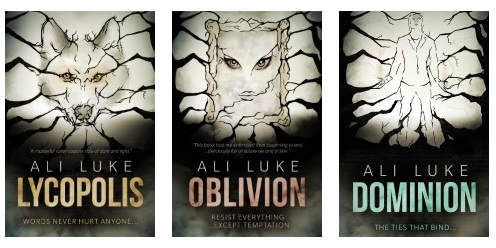
My contemporary fantasy trilogy is available from Amazon. The books follow on from one another, so read Lycopolis first.
You can buy them all from Amazon, or read them FREE in Kindle Unlimited.
I guess this article is meant for me…
im absolutely RATTLED over reading this and realizing why i dont like so much of my writing is because i do the whole ‘blow-by-blow of a mundane event’ section. this…this is gonna change me
It’s a really easy trap to fall into as a writer! I’m really glad this was helpful. Keep writing (and don’t forget to pay attention to the bits you DO like in your own writing … see what they have in common and how you can do more of that stuff). 🙂
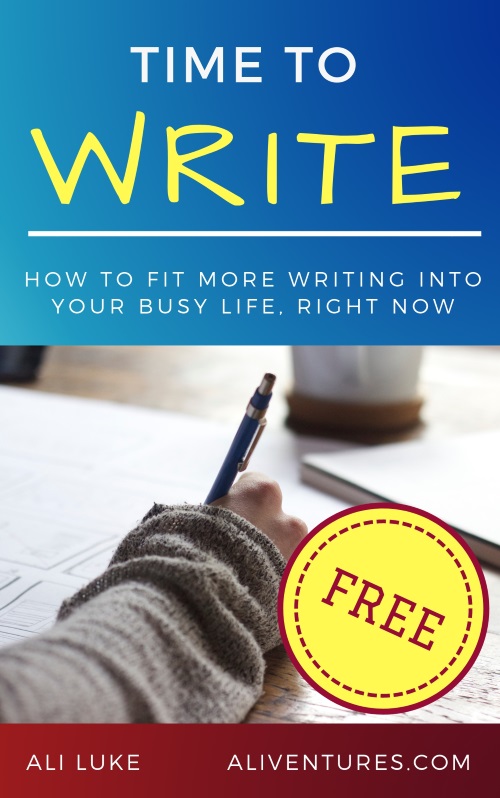
Time to Write (FREE ebook)
You won't simply find time to write.
You need to make time.
It's not always easy, I know! But Time to Write is a short ebook packed with ideas to help.
Pop in your email address to get Time to Write plus other free mini-ebooks. You'll also get my weekly blog posts (Thursdays) and short newsletters (Mondays) to help you make the most of your writing time, week after week.
Note: I will never spam you or pass on your email address to anyone else. You can leave the newsletter list at any time.
Thanks! Check your inbox: you'll have a message from me with a button to click to confirm your email address. Just click that button to get Time to Write.
- Human Editing
- Free AI Essay Writer
- AI Outline Generator
- AI Paragraph Generator
- Paragraph Expander
- Essay Expander
- Literature Review Generator
- Research Paper Generator
- Thesis Generator
- Paraphrasing tool
- AI Rewording Tool
- AI Sentence Rewriter
- AI Rephraser
- AI Paragraph Rewriter
- Summarizing Tool
- AI Content Shortener
- Plagiarism Checker
- AI Detector
- AI Essay Checker
- Citation Generator
- Reference Finder
- Book Citation Generator
- Legal Citation Generator
- Journal Citation Generator
- Reference Citation Generator
- Scientific Citation Generator
- Source Citation Generator
- Website Citation Generator
- URL Citation Generator
- Proofreading Service
- Editing Service
- AI Writing Guides
- AI Detection Guides
- Citation Guides
- Grammar Guides
- Paraphrasing Guides
- Plagiarism Guides
- Summary Writing Guides
- STEM Guides
- Humanities Guides
- Language Learning Guides
- Coding Guides
- Top Lists and Recommendations
- AI Detectors
- AI Writing Services
- Coding Homework Help
- Citation Generators
- Editing Websites
- Essay Writing Websites
- Language Learning Websites
- Math Solvers
- Paraphrasers
- Plagiarism Checkers
- Reference Finders
- Spell Checkers
- Summarizers
- Tutoring Websites
Most Popular
Ai or not ai a student suspects one of their peer reviewer was a bot.
13 days ago
Clark County Schools Introduce Cell Phone Pouches to Enhance Learning Focus
23 of 25 students admit chatgpt use after professor’s amnesty offer, teachers seek ai training – more than 70% had none, why congress cares about media literacy and you should too, really bad writing.

Welcome to the intriguing world of writing – a tantalizing tapestry of creativity, emotion, and intellectual exploration. Here, words aren’t merely vessels of communication; they’re mirrors, reflecting the vibrant mindscapes of their creators. While we often celebrate the artistry of good writing, we rarely venture into the intriguing shadows of its less glamorous counterpart – bad writing. It’s akin to exploring a secret attic, dusty and daunting, but filled with untold lessons. Let’s bravely pull back the curtain on bad writing, discover its quirks, understand its pitfalls, and learn how it can guide us on our journey to becoming stronger, more skilful writers. Buckle up, for we’re about to embark on a writing adventure like no other!
Examples of Bad Writing
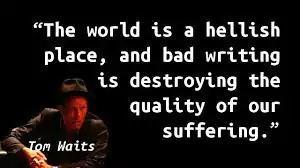
Below are sample excerpts from what I think is a really bad writing. These excerpts are collected from different stories, either written by me (sometimes, when you edit, you find monsters), or by other authors. I won’t disclose their names though. Read the following samples, guess what’s wrong with them, and never write like this.
1. Sunday was a marvelous, uplifting day, perfect for our usual slow and cozy strolls around the picturesque autumn park. It was late glorious October outside, and the whole town was covered with yellow, red, brown, and crimson crispy leaves. The blue sky with fluffy, curly white clouds in it looked light-minded as if all the gruesome and sad miseries of unhappy people living under it were none of its business but its own. I put on my beige warm sweater of large viscous, pushed an old ragged door of my tiny apartment, and went outside and went outside, oh, went outside.
I hope you noticed the enormous quantity of adjectives and epithets and the grammatical errors. Don’t repeat these mistakes.
2. Whenever I was feeling depressed, sad, or just out of place, I would pack my things into a small backpack, write a couple of short letters to my friends—just to prevent them from worrying about my whereabouts—and set off travelling around the state; it really did not matter for me where to go—in youth, I was fascinated with the aesthetics and nomadic romance of the beat generation, so usually I would buy a ticket on a bus (Greyhound Express, just like Jack Kerouac would like it, baby) driving to nowhere, sit, drink from my canteen, and watch the endless miles of the road pass by me outside of the window.
I almost fell asleep while I tried to read to the end of this super-long sentence. And this is not even the longest sentence I’ve encountered.
3. She looked as if she was struck by lightning: her eyes going to fall out of orbits, her mouth wide open, as if she was trying to swallow a train, her skin deadly pale. To me, seeing her in such a condition was heartbreaking, like eggs being cracked upon a stone.
Metaphors and comparisons can be okay if you use them once every few pages. But back to back, they can be annoying—especially poorly-used metaphors.
4. Emotional detachment between us during manifested harmony in relationships was causing a cognitive dissonance within me; my mind was wandering in Kafkian labyrinths of doubt, guilt, and sorrow, while my mouth almost subconsciously produced sparkling words that people usually associate with love.
Don’t try to sound smart. It destroys the magic of your text. If your reader has no idea about Kafkian labyrinths or cognitive dissonance, your effort will be in vain.
5. Electric compulsion of misery flowed through the night megalopolis, filling the veins of pragmatic reality with juices. Magnetic Adam of the new epoch, the innocent function of digital satori, who were you in this entropy?
WHAT?! This is too avant-garde, and in this case, it’s not a compliment.
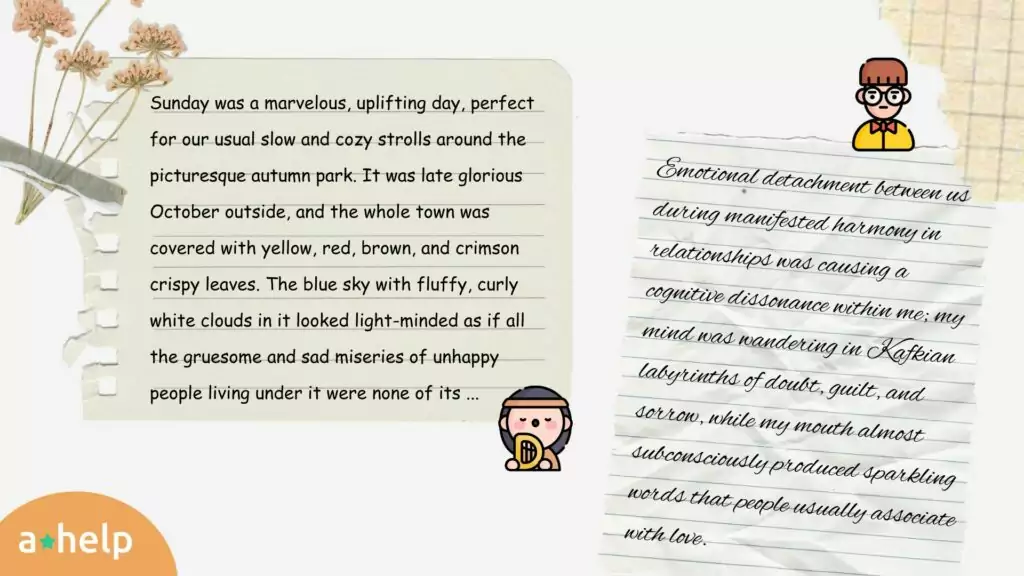
You seriously don’t want to stumble upon such authors. So, if you were planning on working with some writers, you better check their works beforehand. Consider checking out the best custom writing service reviews – maybe you can find true masters of the words there.
Top Writing Mistakes and How to Avoid Them: A Comprehensive Guide
The art of writing holds immense transformative power. But, as with any craft, it can also be filled with potential pitfalls. This article unveils some common writing mistakes and provides insightful strategies to improve your craft. Let’s dive in.
One common writing faux pas is ‘info-dumping’. Authors can fall into the trap of overloading the reader with a sudden onslaught of information to create context or background. Rather than risking the reader’s interest with a wall of text, try subtly sprinkling details throughout the story . As the old saying goes, a little can go a long way.
Next on our list is the pitfall of excessive descriptive language. While well-chosen adjectives can help transport readers to another world, their overuse can slow down the narrative and disengage readers. Remember, a well-crafted narrative strikes a balance between descriptive language and concise storytelling. To achieve this balance, consider using a free sentence rewriter to refine your prose and eliminate unnecessary verbosity.
Clichés are yet another common writing mistake. Overuse of these familiar phrases can make a story feel stale and predictable, suggesting a lack of original thought. Instead of resorting to clichés, try using fresh, original metaphors and descriptions to make your work truly stand out.
Our exploration into common writing errors would be incomplete without addressing ‘telling’ instead of ‘showing’. Instead of explicitly telling your readers that a character is scared, for example, show them descriptions of the character’s trembling hands, quickened breath, or the chill crawling up their spine. The art of storytelling lies in not just what information you convey, but how you convey it.
Another critical issue arises when dialogue feels unnatural or stilted. If characters speak like robots or philosophers in everyday conversation, it can create a disconnect for the reader. To prevent this, try incorporating authentic, real-world dialogue . Remember, your characters should feel like real people.
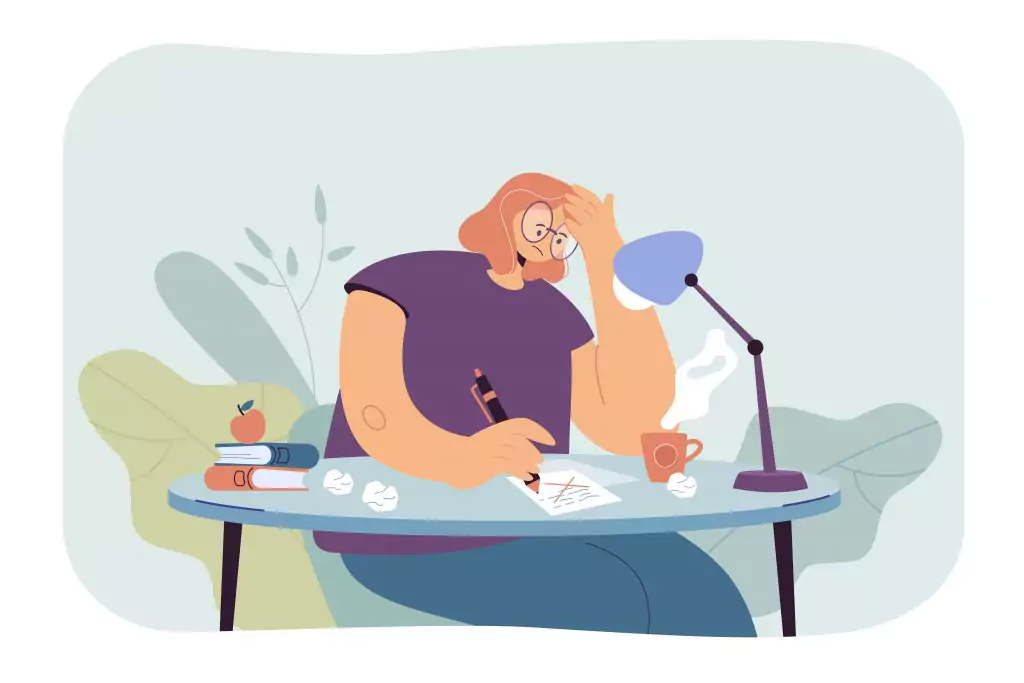
Lastly, we address the common writing mistake of overusing passive voice. Passive sentences tend to be wordy and less direct, which can make them feel awkward or weak. To enhance the energy of your writing, be bold, be direct, and let your active voice shine!
Let’s shift gears and explore some insights derived from personal experiences shared by writers.
Many writers initially struggle with ‘purple prose,’ a term for writing that’s overly ornate or flowery. Over time, they realize that simplicity often makes for more compelling reading. In the world of writing, less is indeed often more.
Overuse of adverbs is another pitfall writers often face in their early attempts at crafting a story. Learning to trust nouns and verbs to carry the scene can help writers overcome this habit and produce more impactful prose.
Creating two-dimensional characters is another common issue. Characters should feel like living, breathing beings with depth and motivation, rather than mere cardboard cutouts.
Inconsistent point-of-view is another challenge that writers often need to overcome. Maintaining a consistent narrative perspective can help to create a stronger narrative focus and engage readers more effectively.
Finally, writers new to poetry often struggle with forced rhymes and rhythms. With practice, they learn to let the words flow naturally, focusing on the message rather than the rhymes.
Exploring Examples of Bad Writing and How to Improve Them
Bad writing is something every writer wants to avoid. However, understanding what constitutes poor writing can be a useful tool in improving writing quality. To shed light on this, we’ll explore some examples of bad writing, commonly seen in popular books, both in literary fiction and commercial fiction.
Inappropriate Dialogue and Dialogue Tags
One common example of bad writing can be found in the execution of dialogue. Good writing involves creating conversations that sound natural and real. However, in some bestselling books, character conversations can feel forced or unnatural, leading to poor writing. For instance, using dialogue tags inappropriately can disrupt the flow of speaking parts. Tags like “he exclaimed” or “she bellowed” used excessively can distract the reader and detract from the narrative. Skilled writing involves using dialogue tags sparingly and effectively.
Another example of bad writing in dialogue is the use of unnatural language. Characters should speak like real people, their language reflecting their background, age, and personality. When character names start to spout jargon or use overly complex language without any contextual reasoning, it can feel jarring to the reader.
Ineffective Description
Description is a critical component of both literary novels and genre fiction. However, bad writing often includes detailed descriptions that don’t serve the story. For example, imagine a scene in a coffee shop where the author spends three paragraphs describing the intricate design of the espresso machine. Unless the coffeehouse or the machine plays a significant role in the narrative, such a vivid depiction is unnecessary and can slow down the pace of the story.
Good writing, on the other hand, incorporates descriptive writing that enhances the narrative and deepens the reader’s understanding of the characters or the setting. A quality description in a literary work or a popular novel should be concise, relevant, and evocative, creating a vivid picture in the reader’s mind without overburdening them with unnecessary details.
Confusing Point of View
A clear and consistent point of view is a hallmark of effective writing. However, in some highly read books, the author’s perspective or the narrative perspective can become muddled, leading to bad writing. For instance, if a story is told from a single character’s point of view, but suddenly includes information that this character couldn’t possibly know, it breaks the consistency of the storytelling angle and can confuse the reader.
The Power of Redrafting
Improving writing, particularly in commercial fiction and literary fiction, often involves significant rewriting, editing, or revising. Redrafting is a critical part of the writing process that allows authors to identify and correct instances of bad writing.
For instance, dialogue can be improved by removing unnecessary dialogue markers, making conversations more natural, and ensuring that character names and their speech reflect their personalities and backgrounds. Descriptions can be refined to ensure they serve the story and aren’t overly detailed. The point of view can be clarified and made consistent throughout the story.
Inconsistent Characterization
Characterization is a vital aspect of both literary works and mainstream novels. However, bad writing often manifests as inconsistent characterization, where the traits, actions, or reactions of the protagonist or other characters don’t align with what has been established earlier in the story. For instance, a character portrayed as shy and introverted suddenly becoming outgoing and gregarious without any plausible explanation or character development can confuse readers and weaken the narrative.
In good writing, characters evolve over time, but such changes are gradual and justified by the plot or their experiences. The names of the characters and their actions should align with their personalities, backgrounds, and the story’s overall context.
Misuse of Common Settings
Another area where bad writing can be evident is in the depiction of common settings, such as a coffee shop or a café. For example, if every significant conversation or revelation in the story occurs in an espresso bar without any compelling reason, it can strain the story’s credibility and become repetitive. Effective writing employs a variety of settings and ensures that the location matches the scene’s tone and significance.
Ineffective Use of Language
Poor writing often includes redundant phrases, incorrect word usage, and convoluted sentence structures, which can distract the reader and interrupt the narrative flow. An essential part of improving writing is honing language skills, choosing the right words for clarity and impact, and maintaining grammatical accuracy.
Overcoming Bad Writing through Redrafting
One of the most reliable ways to address bad writing is through redrafting, rewriting, or revising the text. This process involves examining every aspect of the story, from dialogue and description to character consistency and point of view, and making necessary changes to enhance the writing quality.
Redrafting can also involve replacing overused words with synonyms, improving sentence structure, and eliminating unnecessary details or repetitions. For instance, a dialogue tag like “he said” can often be removed entirely if it’s clear who’s speaking, leading to cleaner, more effective writing.
The Transformational Journey from Draft to Masterpiece
Few writers strike gold with their first drafts; the true magic happens during the revision phase. Revision, or redrafting, is a powerful tool that can elevate a good piece to greatness. It’s the process where we refine our thoughts, improve our arguments, and perfect our language to better connect with readers. An essential aspect of writing, revision can transform a raw manuscript into a polished masterpiece.
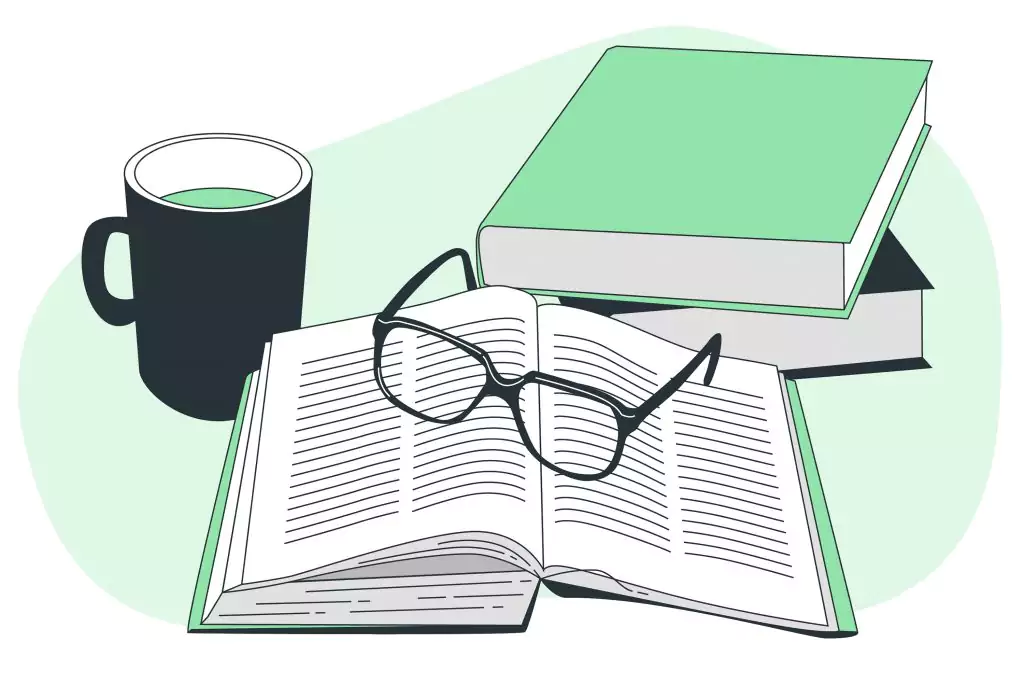
A Step-by-Step Guide to Organizing Effective Redrafting:
- Embrace the Pause: Once you’ve completed your initial draft, give yourself permission to take a break. This intentional distancing allows your mind to reset, and when you return, you’ll be equipped with fresh eyes, ready to identify any gaps in information, inconsistencies in the plot or argument, or any parts that may be unclear to your reader.
- Read Aloud:: When you read your work aloud, you engage another sense that helps you perceive your writing from a different perspective. You become the audience, able to pick up on awkward phrasing, clunky sentences, or tonal inconsistencies that might be overlooked when reading silently.
- Involve Others: Enlist the help of a trusted friend, mentor, or editor to review your work. They bring an outsider’s perspective, essential for pinpointing areas that might be confusing or lacking in explanation. This feedback provides a road map for your revisions.
- Revise in Stages: : Attempting to revise everything simultaneously can be daunting. Therefore, break your revision down into manageable stages. Start with the macro level by focusing on the overall content and structure. Once you’re satisfied, dive into the micro level, examining sentence structure, language use, and word choice. Lastly, focus on fine-tuning the grammar and punctuation.
- Sacrifice for the Greater Good: Writers often coin the term “kill your darlings” when talking about beloved but unnecessary portions of their work. It’s vital to stay objective and be willing to cut your favourite sentence or paragraph if it doesn’t contribute to the overall piece.
- Final Sweep – Proofreading: After all the conceptual and structural changes, meticulously scour your work for any overlooked typos, grammatical errors, or punctuation mishaps. These seemingly small mistakes can greatly affect the credibility and impact of your work.
- Iterate and Refine: Remember, good writing is the result of continuous refining. Don’t hesitate to undergo multiple rounds of revisions. With each round, your writing will become more refined, clear, and powerful. This process doesn’t necessarily get easier, but the rewards of a well-crafted piece are worth every revision.
The path to becoming a skilled writer is paved with lessons. Embrace the process of continual learning and improvement. Every story you write is a part of your unique narrative as a writer.
Stay updated for more!
Follow us on Reddit for more insights and updates.
Comments (0)
Welcome to A*Help comments!
We’re all about debate and discussion at A*Help.
We value the diverse opinions of users, so you may find points of view that you don’t agree with. And that’s cool. However, there are certain things we’re not OK with: attempts to manipulate our data in any way, for example, or the posting of discriminative, offensive, hateful, or disparaging material.
Cancel reply
Your email address will not be published. Required fields are marked *
Save my name, email, and website in this browser for the next time I comment.
More from Educational Trends, News and Tips
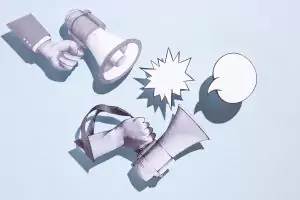
Jul 28 2023
Don’t Miss! Weekly Must-Read Articles: New School Gender Policies, The End of OpenAI Detection Tool & African-Led Copywriting Platform Debut

Jul 21 2023
Don’t Miss! Weekly Must-Read Articles: Growing pressure on colleges, Preply raises $70 million for AI, Tech giants search for next-gen talents & more

Jul 14 2023
Don’t Miss! Weekly Must-Read Articles: AI Guidelines, Difficulties with Self-Learning, Educational & Job Opportunities
Remember Me
Is English your native language ? Yes No
What is your profession ? Student Teacher Writer Other
Forgotten Password?
Username or Email

Choose Your Test
Sat / act prep online guides and tips, bad college essays: 10 mistakes you must avoid.
College Essays

Just as there are noteworthy examples of excellent college essays that admissions offices like to publish, so are there cringe-worthy examples of terrible college essays that end up being described by anonymous admissions officers on Reddit discussion boards.
While I won't guarantee that your essay will end up in the first category, I will say that you follow my advice in this article, your essay most assuredly won't end up in the second. How do you avoid writing a bad admissions essay? Read on to find out what makes an essay bad and to learn which college essay topics to avoid. I'll also explain how to recognize bad college essays—and what to do to if you end up creating one by accident.
What Makes Bad College Essays Bad
What exactly happens to turn a college essay terrible? Just as great personal statements combine an unexpected topic with superb execution, flawed personal statements compound problematic subject matter with poor execution.
Problems With the Topic
The primary way to screw up a college essay is to flub what the essay is about or how you've decided to discuss a particular experience. Badly chosen essay content can easily create an essay that is off-putting in one of a number of ways I'll discuss in the next section.
The essay is the place to let the admissions office of your target college get to know your personality, character, and the talents and skills that aren't on your transcript. So if you start with a terrible topic, not only will you end up with a bad essay, but you risk ruining the good impression that the rest of your application makes.
Some bad topics show admissions officers that you don't have a good sense of judgment or maturity , which is a problem since they are building a class of college students who have to be able to handle independent life on campus.
Other bad topics suggest that you are a boring person , or someone who doesn't process your experience in a colorful or lively way, which is a problem since colleges want to create a dynamic and engaged cohort of students.
Still other bad topics indicate that you're unaware of or disconnected from the outside world and focused only on yourself , which is a problem since part of the point of college is to engage with new people and new ideas, and admissions officers are looking for people who can do that.
Problems With the Execution
Sometimes, even if the experiences you discuss could be the foundation of a great personal statement, the way you've structured and put together your essay sends up warning flags. This is because the admissions essay is also a place to show the admissions team the maturity and clarity of your writing style.
One way to get this part wrong is to exhibit very faulty writing mechanics , like unclear syntax or incorrectly used punctuation. This is a problem since college-ready writing is one of the things that's expected from a high school graduate.
Another way to mess this up is to ignore prompt instructions either for creative or careless reasons. This can show admissions officers that you're either someone who simply blows off directions and instructions or someone who can't understand how to follow them . Neither is a good thing, since they are looking for people who are open to receiving new information from professors and not just deciding they know everything already.

College Essay Topics To Avoid
Want to know why you're often advised to write about something mundane and everyday for your college essay? That's because the more out-there your topic, the more likely it is to stumble into one of these trouble categories.
Too Personal
The problem with the overly personal essay topic is that revealing something very private can show that you don't really understand boundaries . And knowing where appropriate boundaries are will be key for living on your own with a bunch of people not related to you.
Unfortunately, stumbling into the TMI zone of essay topics is more common than you think. One quick test for checking your privacy-breaking level: if it's not something you'd tell a friendly stranger sitting next to you on the plane, maybe don't tell it to the admissions office.
- Describing losing your virginity, or anything about your sex life really. This doesn't mean you can't write about your sexual orientation—just leave out the actual physical act.
- Writing in too much detail about your illness, disability, any other bodily functions. Detailed meaningful discussion of what this physical condition has meant to you and your life is a great thing to write about. But stay away from body horror and graphic descriptions that are simply there for gratuitous shock value.
- Waxing poetic about your love for your significant other. Your relationship is adorable to the people currently involved in it, but those who don't know you aren't invested in this aspect of your life.
- Confessing to odd and unusual desires of the sexual or illegal variety. Your obsession with cultivating cacti is wonderful topic, while your obsession with researching explosives is a terrible one.

Too Revealing of Bad Judgment
Generally speaking, leave past illegal or immoral actions out of your essay . It's simply a bad idea to give admissions officers ammunition to dislike you.
Some exceptions might be if you did something in a very, very different mindset from the one you're in now (in the midst of escaping from danger, under severe coercion, or when you were very young, for example). Or if your essay is about explaining how you've turned over a new leaf and you have the transcript to back you up.
- Writing about committing crime as something fun or exciting. Unless it's on your permanent record, and you'd like a chance to explain how you've learned your lesson and changed, don't put this in your essay.
- Describing drug use or the experience of being drunk or high. Even if you're in a state where some recreational drugs are legal, you're a high school student. Your only exposure to mind-altering substances should be caffeine.
- Making up fictional stories about yourself as though they are true. You're unlikely to be a good enough fantasist to pull this off, and there's no reason to roll the dice on being discovered to be a liar.
- Detailing your personality flaws. Unless you have a great story of coping with one of these, leave deal-breakers like pathological narcissism out of your personal statement.

Too Overconfident
While it's great to have faith in your abilities, no one likes a relentless show-off. No matter how magnificent your accomplishments, if you decide to focus your essay on them, it's better to describe a setback or a moment of doubt rather that simply praising yourself to the skies.
- Bragging and making yourself the flawless hero of your essay. This goes double if you're writing about not particularly exciting achievements like scoring the winning goal or getting the lead in the play.
- Having no awareness of the actual scope of your accomplishments. It's lovely that you take time to help others, but volunteer-tutoring a couple of hours a week doesn't make you a saintly figure.

Too Clichéd or Boring
Remember your reader. In this case, you're trying to make yourself memorable to an admissions officer who has been reading thousands of other essays . If your essay makes the mistake of being boring or trite, it just won't register in that person's mind as anything worth paying attention to.
- Transcribing your resume into sentence form or writing about the main activity on your transcript. The application already includes your resume, or a detailed list of your various activities. Unless the prompt specifically asks you to write about your main activity, the essay needs to be about a facet of your interests and personality that doesn't come through the other parts of the application.
- Writing about sports. Every athlete tries to write this essay. Unless you have a completely off-the-wall story or unusual achievement, leave this overdone topic be.
- Being moved by your community service trip to a third-world country. Were you were impressed at how happy the people seemed despite being poor? Did you learn a valuable lesson about how privileged you are? Unfortunately, so has every other teenager who traveled on one of these trips. Writing about this tends to simultaneously make you sound unempathetic, clueless about the world, way over-privileged, and condescending. Unless you have a highly specific, totally unusual story to tell, don't do it.
- Reacting with sadness to a sad, but very common experience. Unfortunately, many of the hard, formative events in your life are fairly universal. So, if you're going to write about death or divorce, make sure to focus on how you dealt with this event, so the essay is something only you could possibly have written. Only detailed, idiosyncratic description can save this topic.
- Going meta. Don't write about the fact that you're writing the essay as we speak, and now the reader is reading it, and look, the essay is right here in the reader's hand. It's a technique that seems clever, but has already been done many times in many different ways.
- Offering your ideas on how to fix the world. This is especially true if your solution is an easy fix, if only everyone would just listen to you. Trust me, there's just no way you are being realistically appreciative of the level of complexity inherent in the problem you're describing.
- Starting with a famous quotation. There usually is no need to shore up your own words by bringing in someone else's. Of course, if you are writing about a particular phrase that you've adopted as a life motto, feel free to include it. But even then, having it be the first line in your essay feels like you're handing the keys over to that author and asking them to drive.
- Using an everyday object as a metaphor for your life/personality. "Shoes. They are like this, and like that, and people love them for all of these reasons. And guess what? They are just like me."

Too Off-Topic
Unlike the essays you've been writing in school where the idea is to analyze something outside of yourself, the main subject of your college essay should be you, your background, your makeup, and your future . Writing about someone or something else might well make a great essay, but not for this context.
- Paying tribute to someone very important to you. Everyone would love to meet your grandma, but this isn't the time to focus on her amazing coming of age story. If you do want to talk about a person who is important to your life, dwell on the ways you've been impacted by them, and how you will incorporate this impact into your future.
- Documenting how well other people do things, say things, are active, while you remain passive and inactive in the essay. Being in the orbit of someone else's important lab work, or complex stage production, or meaningful political activism is a fantastic learning moment. But if you decide to write about, your essay should be about your learning and how you've been influenced, not about the other person's achievements.
- Concentrating on a work of art that deeply moved you. Watch out for the pitfall of writing an analytical essay about that work, and not at all about your reaction to it or how you've been affected since. Check out our explanation of how to answer Topic D of the ApplyTexas application to get some advice on writing about someone else's work while making sure your essay still points back at you.

(Image: Pieter Christoffel Wonder [Public domain] , via Wikimedia Commons)

Too Offensive
With this potential mistake, you run the risk of showing a lack of self-awareness or the ability to be open to new ideas . Remember, no reader wants to be lectured at. If that's what your essay does, you are demonstrating an inability to communicate successfully with others.
Also, remember that no college is eager to admit someone who is too close-minded to benefit from being taught by others. A long, one-sided essay about a hot-button issue will suggest that you are exactly that.
- Ranting at length about political, religious, or other contentious topics. You simply don't know where the admissions officer who reads your essay stands on any of these issues. It's better to avoid upsetting or angering that person.
- Writing a one-sided diatribe about guns, abortion, the death penalty, immigration, or anything else in the news. Even if you can marshal facts in your argument, this essay is simply the wrong place to take a narrow, unempathetic side in an ongoing debate.
- Mentioning anything negative about the school you're applying to. Again, your reader is someone who works there and presumably is proud of the place. This is not the time to question the admissions officer's opinions or life choices.

College Essay Execution Problems To Avoid
Bad college essays aren't only caused by bad topics. Sometimes, even if you're writing about an interesting, relevant topic, you can still seem immature or unready for college life because of the way you present that topic—the way you actually write your personal statement. Check to make sure you haven't made any of the common mistakes on this list.
Tone-Deafness
Admissions officers are looking for resourcefulness, the ability to be resilient, and an active and optimistic approach to life —these are all qualities that create a thriving college student. Essays that don't show these qualities are usually suffering from tone-deafness.
- Being whiny or complaining about problems in your life. Is the essay about everyone doing things to/against you? About things happening to you, rather than you doing anything about them? That perspective is a definite turn-off.
- Trying and failing to use humor. You may be very funny in real life, but it's hard to be successfully funny in this context, especially when writing for a reader who doesn't know you. If you do want to use humor, I'd recommend the simplest and most straightforward version: being self-deprecating and low-key.
- Talking down to the reader, or alternately being self-aggrandizing. No one enjoys being condescended to. In this case, much of the function of your essay is to charm and make yourself likable, which is unlikely to happen if you adopt this tone.
- Being pessimistic, cynical, and generally depressive. You are applying to college because you are looking forward to a future of learning, achievement, and self-actualization. This is not the time to bust out your existential ennui and your jaded, been-there-done-that attitude toward life.
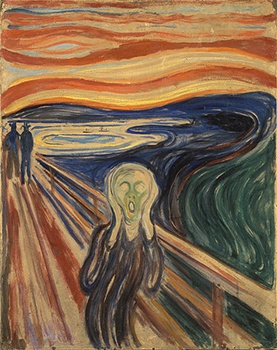
(Image: Eduard Munch [Public Domain] , via Wikimedia Commons)
Lack of Personality
One good question to ask yourself is: could anyone else have written this essay ? If the answer is yes, then you aren't doing a good job of representing your unique perspective on the world. It's very important to demonstrate your ability to be a detailed observer of the world, since that will be one of your main jobs as a college student.
- Avoiding any emotions, and appearing robot-like and cold in the essay. Unlike essays that you've been writing for class, this essay is meant to be a showcase of your authorial voice and personality. It may seem strange to shift gears after learning how to take yourself out of your writing, but this is the place where you have to put as much as yourself in as possible.
- Skipping over description and specific details in favor of writing only in vague generalities. Does your narrative feel like a newspaper horoscope, which could apply to every other person who was there that day? Then you're doing it wrong and need to refocus on your reaction, feelings, understanding, and transformation.

Off-Kilter Style
There's some room for creativity here, yes, but a college essay isn't a free-for-all postmodern art class . True, there are prompts that specifically call for your most out-of-left-field submission, or allow you to submit a portfolio or some other work sample instead of a traditional essay. But on a standard application, it's better to stick to traditional prose, split into paragraphs, further split into sentences.
- Submitting anything other than just the materials asked for on your application. Don't send food to the admissions office, don't write your essay on clothing or shoes, don't create a YouTube channel about your undying commitment to the school. I know there are a lot of urban legends about "that one time this crazy thing worked," but they are either not true or about something that will not work a second time.
- Writing your essay in verse, in the form of a play, in bullet points, as an acrostic, or any other non-prose form. Unless you really have a way with poetry or playwriting, and you are very confident that you can meet the demands of the prompt and explain yourself well in this form, don't discard prose simply for the sake of being different.
- Using as many "fancy" words as possible and getting very far away from sounding like yourself. Admissions officers are unanimous in wanting to hear your not fully formed teenage voice in your essay. This means that you should write at the top of your vocabulary range and syntax complexity, but don't trade every word up for a thesaurus synonym. Your essay will suffer for it.
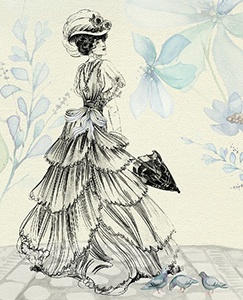
Failure to Proofread
Most people have a hard time checking over their own work. This is why you have to make sure that someone else proofreads your writing . This is the one place where you can, should—and really must—get someone who knows all about grammar, punctuation and has a good eye for detail to take a red pencil to your final draft.
Otherwise, you look like you either don't know the basic rules or writing (in which case, are you really ready for college work?) or don't care enough to present yourself well (in which case, why would the admissions people care about admitting you?).
- Typos, grammatical mistakes, punctuation flubs, weird font/paragraph spacing issues. It's true that these are often unintentional mistakes. But caring about getting it right is a way to demonstrate your work ethic and dedication to the task at hand.
- Going over the word limit. Part of showing your brilliance is being able to work within arbitrary rules and limitations. Going over the word count points to a lack of self-control, which is not a very attractive feature in a college applicant.
- Repeating the same word(s) or sentence structure over and over again. This makes your prose monotonous and hard to read.

Bad College Essay Examples—And How to Fix Them
The beauty of writing is that you get to rewrite. So if you think of your essay as a draft waiting to be revised into a better version rather than as a precious jewel that can't bear being touched, you'll be in far better shape to correct the issues that always crop up!
Now let's take a look at some actual college essay drafts to see where the writer is going wrong and how the issue could be fixed.
Essay #1: The "I Am Writing This Essay as We Speak" Meta-Narrative
Was your childhood home destroyed by a landspout tornado? Yeah, neither was mine. I know that intro might have given the impression that this college essay will be about withstanding disasters, but the truth is that it isn't about that at all.
In my junior year, I always had in mind an image of myself finishing the college essay months before the deadline. But as the weeks dragged on and the deadline drew near, it soon became clear that at the rate things are going I would probably have to make new plans for my October, November and December.
Falling into my personal wormhole, I sat down with my mom to talk about colleges. "Maybe you should write about Star Trek ," she suggested, "you know how you've always been obsessed with Captain Picard, calling him your dream mentor. Unique hobbies make good topics, right? You'll sound creative!" I played with the thought in my mind, tapping my imaginary communicator pin and whispering "Computer. Tea. Earl Grey. Hot. And then an Essay." Nothing happened. Instead, I sat quietly in my room wrote the old-fashioned way. Days later I emerged from my room disheveled, but to my dismay, this college essay made me sound like just a guy who can't get over the fact that he'll never take the Starfleet Academy entrance exam. So, I tossed my essay away without even getting to disintegrate it with a phaser set on stun.
I fell into a state of panic. My college essay. My image of myself in senior year. Almost out of nowhere, Robert Jameson Smith offered his words of advice. Perfect! He suggested students begin their college essay by listing their achievements and letting their essay materialize from there. My heart lifted, I took his advice and listed three of my greatest achievements - mastering my backgammon strategy, being a part of TREE in my sophomore year, and performing "I Am the Very Model of a Modern Major-General" from The Pirates of Penzance in public. And sure enough, I felt inspiration hit me and began to type away furiously into the keyboard about my experience in TREE, or Trees Require Engaged Environmentalists. I reflected on the current state of deforestation, and described the dichotomy of it being both understandable why farmers cut down forests for farmland, and how dangerous this is to our planet. Finally, I added my personal epiphany to the end of my college essay as the cherry on the vanilla sundae, as the overused saying goes.
After 3 weeks of figuring myself out, I have converted myself into a piece of writing. As far as achievements go, this was definitely an amazing one. The ability to transform a human being into 603 words surely deserves a gold medal. Yet in this essay, I was still being nagged by a voice that couldn't be ignored. Eventually, I submitted to that yelling inner voice and decided that this was not the right essay either.
In the middle of a hike through Philadelphia's Fairmount Park, I realized that the college essay was nothing more than an embodiment of my character. The two essays I have written were not right because they have failed to become more than just words on recycled paper. The subject failed to come alive. Certainly my keen interest in Star Trek and my enthusiasm for TREE are a great part of who I am, but there were other qualities essential in my character that did not come across in the essays.
With this realization, I turned around as quickly as I could without crashing into a tree.
What Essay #1 Does Well
Here are all things that are working on all cylinders for this personal statement as is.
Killer First Sentence
Was your childhood home destroyed by a landspout tornado? Yeah, neither was mine.
- A strange fact. There are different kinds of tornadoes? What is a "landspout tornado" anyway?
- A late-night-deep-thoughts hypothetical. What would it be like to be a kid whose house was destroyed in this unusual way?
- Direct engagement with the reader. Instead of asking "what would it be like to have a tornado destroy a house" it asks "was your house ever destroyed."

Gentle, Self-Deprecating Humor That Lands Well
I played with the thought in my mind, tapping my imaginary communicator pin and whispering "Computer. Tea. Earl Grey. Hot. And then an Essay." Nothing happened. Instead, I sat quietly in my room wrote the old-fashioned way. Days later I emerged from my room disheveled, but to my dismay, this college essay made me sound like just a guy who can't get over the fact that he'll never take the Starfleet Academy entrance exam. So, I tossed my essay away without even getting to disintegrate it with a phaser set on stun.
The author has his cake and eats it too here: both making fun of himself for being super into the Star Trek mythos, but also showing himself being committed enough to try whispering a command to the Enterprise computer alone in his room. You know, just in case.
A Solid Point That Is Made Paragraph by Paragraph
The meat of the essay is that the two versions of himself that the author thought about portraying each fails in some way to describe the real him. Neither an essay focusing on his off-beat interests, nor an essay devoted to his serious activism could capture everything about a well-rounded person in 600 words.
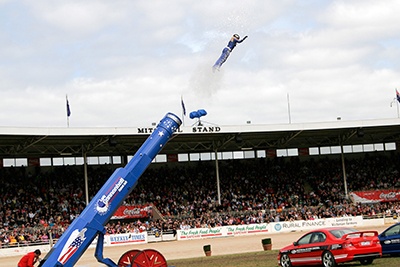
(Image: fir0002 via Wikimedia Commons .)
Where Essay #1 Needs Revision
Rewriting these flawed parts will make the essay shine.
Spending Way Too Long on the Metanarrative
I know that intro might have given the impression that this college essay will be about withstanding disasters, but the truth is that it isn't about that at all.
After 3 weeks of figuring myself out, I have converted myself into a piece of writing. As far as achievements go, this was definitely an amazing one. The ability to transform a human being into 603 words surely deserves a gold medal.
Look at how long and draggy these paragraphs are, especially after that zippy opening. Is it at all interesting to read about how someone else found the process of writing hard? Not really, because this is a very common experience.
In the rewrite, I'd advise condensing all of this to maybe a sentence to get to the meat of the actual essay .
Letting Other People Do All the Doing
I sat down with my mom to talk about colleges. "Maybe you should write about Star Trek ," she suggested, "you know how you've always been obsessed with Captain Picard, calling him your dream mentor. Unique hobbies make good topics, right? You'll sound creative!"
Almost out of nowhere, Robert Jameson Smith offered his words of advice. Perfect! He suggested students begin their college essay by listing their achievements and letting their essay materialize from there.
Twice in the essay, the author lets someone else tell him what to do. Not only that, but it sounds like both of the "incomplete" essays were dictated by the thoughts of other people and had little to do with his own ideas, experiences, or initiative.
In the rewrite, it would be better to recast both the Star Trek and the TREE versions of the essay as the author's own thoughts rather than someone else's suggestions . This way, the point of the essay—taking apart the idea that a college essay could summarize life experience—is earned by the author's two failed attempts to write that other kind of essay.

Leaving the Insight and Meaning Out of His Experiences
Both the Star Trek fandom and the TREE activism were obviously important life experiences for this author—important enough to be potential college essay topic candidates. But there is no description of what the author did with either one, nor any explanation of why these were so meaningful to his life.
It's fine to say that none of your achievements individually define you, but in order for that to work, you have to really sell the achievements themselves.
In the rewrite, it would be good to explore what he learned about himself and the world by pursuing these interests . How did they change him or seen him into the person he is today?
Not Adding New Shades and Facets of Himself Into the Mix
So, I tossed my essay away without even getting to disintegrate it with a phaser set on stun.
Yet in this essay, I was still being nagged by a voice that couldn't be ignored. Eventually, I submitted to that yelling inner voice and decided that this was not the right essay either.
In both of these passages, there is the perfect opportunity to point out what exactly these failed versions of the essay didn't capture about the author . In the next essay draft, I would suggest subtly making a point about his other qualities.
For example, after the Star Trek paragraph, he could talk about other culture he likes to consume, especially if he can discuss art forms he is interested in that would not be expected from someone who loves Star Trek .
Or, after the TREE paragraph, the author could explain why this second essay was no better at capturing him than the first. What was missing? Why is the self in the essay shouting—is it because this version paints him as an overly aggressive activist?

Essay #2: The "I Once Saw Poor People" Service Trip Essay
Unlike other teenagers, I'm not concerned about money, or partying, or what others think of me. Unlike other eighteen year-olds, I think about my future, and haven't become totally materialistic and acquisitive. My whole outlook on life changed after I realized that my life was just being handed to me on a silver spoon, and yet there were those in the world who didn't have enough food to eat or place to live. I realized that the one thing that this world needed more than anything was compassion; compassion for those less fortunate than us.
During the summer of 2006, I went on a community service trip to rural Peru to help build an elementary school for kids there. I expected harsh conditions, but what I encountered was far worse. It was one thing to watch commercials asking for donations to help the unfortunate people in less developed countries, yet it was a whole different story to actually live it. Even after all this time, I can still hear babies crying from hunger; I can still see the filthy rags that they wore; I can still smell the stench of misery and hopelessness. But my most vivid memory was the moment I first got to the farming town. The conditions of it hit me by surprise; it looked much worse in real life than compared to the what our group leader had told us. Poverty to me and everyone else I knew was a foreign concept that people hear about on the news or see in documentaries. But this abject poverty was their life, their reality. And for the brief ten days I was there, it would be mine too. As all of this realization came at once, I felt overwhelmed by the weight of what was to come. Would I be able to live in the same conditions as these people? Would I catch a disease that no longer existed in the first world, or maybe die from drinking contaminated water? As these questions rolled around my already dazed mind, I heard a soft voice asking me in Spanish, "Are you okay? Is there anything I can do to make you feel better?" I looked down to see a small boy, around nine years of age, who looked starved, and cold, wearing tattered clothing, comforting me. These people who have so little were able to forget their own needs, and put those much more fortunate ahead of themselves. It was at that moment that I saw how selfish I had been. How many people suffered like this in the world, while I went about life concerned about nothing at all?
Thinking back on the trip, maybe I made a difference, maybe not. But I gained something much more important. I gained the desire to make the world a better place for others. It was in a small, poverty-stricken village in Peru that I finally realized that there was more to life than just being alive.
What Essay #2 Does Well
Let's first point out what this draft has going for it.
Clear Chronology
This is an essay that tries to explain a shift in perspective. There are different ways to structure this overarching idea, but a chronological approach that starts with an earlier opinion, describes a mind changing event, and ends with the transformed point of view is an easy and clear way to lay this potentially complex subject out.

(Image: User:Lite via Wikimedia Commons)
Where Essay #2 Needs Revision
Now let's see what needs to be changed in order for this essay to pass muster.
Condescending, Obnoxious Tone
Unlike other teenagers, I'm not concerned about money, or partying, or what others think of me. Unlike other eighteen year-olds, I think about my future, and haven't become totally materialistic and acquisitive.
This is a very broad generalization, which doesn't tend to be the best way to formulate an argument—or to start an essay. It just makes this author sound dismissive of a huge swath of the population.
In the rewrite, this author would be way better off just concentrate on what she want to say about herself, not pass judgment on "other teenagers," most of whom she doesn't know and will never meet.
I realized that the one thing that this world needed more than anything was compassion; compassion for those less fortunate than us.
Coming from someone who hasn't earned her place in the world through anything but the luck of being born, the word "compassion" sounds really condescending. Calling others "less fortunate" when you're a senior in high school has a dehumanizing quality to it.
These people who have so little were able to forget their own needs, and put those much more fortunate in front of themselves.
Again, this comes across as very patronizing. Not only that, but to this little boy the author was clearly not looking all that "fortunate"—instead, she looked pathetic enough to need comforting.
In the next draft, a better hook could be making the essay about the many different kinds of shifting perspectives the author encountered on that trip . A more meaningful essay would compare and contrast the points of view of the TV commercials, to what the group leader said, to the author's own expectations, and finally to this child's point of view.

Vague, Unobservant Description
During the summer of 2006, I went on a community service trip to rural Peru to help build an elementary school for kids there. I expected harsh conditions, but what I encountered was far worse. It was one thing to watch commercials asking for donations to help the unfortunate people in less developed countries, yet it was a whole different story to actually live it. Even after all this time, I can still hear babies crying from hunger; I can still see the filthy rags that they wore; I can still smell the stench of misery and hopelessness.
Phrases like "cries of the small children from not having enough to eat" and "dirt stained rags" seem like descriptions, but they're really closer to incurious and completely hackneyed generalizations. Why were the kids were crying? How many kids? All the kids? One specific really loud kid?
The same goes for "filthy rags," which is both an incredibly insensitive way to talk about the clothing of these villagers, and again shows a total lack of interest in their life. Why were their clothes dirty? Were they workers or farmers so their clothes showing marks of labor? Did they have Sunday clothes? Traditional clothes they would put on for special occasions? Did they make their own clothes? That would be a good reason to keep wearing clothing even if it had "stains" on it.
The rewrite should either make this section more specific and less reliant on cliches, or should discard it altogether .
The conditions of it hit me by surprise; it looked much worse in real life than compared to the what our group leader had told us. Poverty to me and everyone else I knew was a foreign concept that people hear about on the news or see in documentaries. But this abject poverty was their life, their reality.
If this is the "most vivid memory," then I would expect to read all the details that have been seared into the author's brain. What did their leader tell them? What was different in real life? What was the light like? What did the houses/roads/grass/fields/trees/animals/cars look like? What time of day was it? Did they get there by bus, train, or plane? Was there an airport/train station/bus terminal? A city center? Shops? A marketplace?
There are any number of details to include here when doing another drafting pass.

Lack of Insight or Maturity
But this abject poverty was their life, their reality. And for the brief ten days I was there, it would be mine too. As all of this realization came at once, I felt overwhelmed by the weight of what was to come. Would I be able to live in the same conditions as these people? Would I catch a disease that no longer existed in the first world, or maybe die from drinking contaminated water?
Without a framing device explaining that this initial panic was an overreaction, this section just makes the author sound whiny, entitled, melodramatic, and immature . After all, this isn't a a solo wilderness trek—the author is there with a paid guided program. Just how much mortality is typically associated with these very standard college-application-boosting service trips?
In a rewrite, I would suggest including more perspective on the author's outsized and overprivileged response here. This would fit well with a new focus on the different points of view on this village the author encountered.
Unearned, Clichéd "Deep Thoughts"
But I gained something much more important. I gained the desire to make the world a better place for others. It was in a small, poverty-stricken village in Peru that I finally realized that there was more to life than just being alive.
Is it really believable that this is what the author learned? There is maybe some evidence to suggest that the author was shaken somewhat out of a comfortable, materialistic existence. But what does "there is more to life than just being alive" even really mean? This conclusion is rather vague, and seems mostly a non sequitur.
In a rewrite, the essay should be completely reoriented to discuss how differently others see us than we see ourselves, pivoting on the experience of being pitied by someone who you thought was pitiable. Then, the new version can end by on a note of being better able to understand different points of view and other people's perspectives .
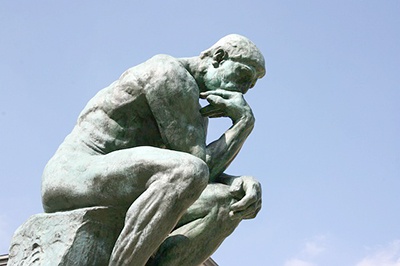
The Bottom Line
- Bad college essays have problems either with their topics or their execution.
- The essay is how admissions officers learn about your personality, point of view, and maturity level, so getting the topic right is a key factor in letting them see you as an aware, self-directed, open-minded applicant who is going to thrive in an environment of independence.
- The essay is also how admissions officers learn that you are writing at a ready-for-college level, so screwing up the execution shows that you either don't know how to write, or don't care enough to do it well.
- The main ways college essay topics go wrong is bad taste, bad judgment, and lack of self-awareness.
- The main ways college essays fail in their execution have to do with ignoring format, syntax, and genre expectations.
What's Next?
Want to read some excellent college essays now that you've seen some examples of flawed one? Take a look through our roundup of college essay examples published by colleges and then get help with brainstorming your perfect college essay topic .
Need some guidance on other parts of the application process? Check out our detailed, step-by-step guide to college applications for advice.
Are you considering taking the SAT or ACT again before you submit your application? Read about our famous test prep guides for hints and strategies for a better score.

Anna scored in the 99th percentile on her SATs in high school, and went on to major in English at Princeton and to get her doctorate in English Literature at Columbia. She is passionate about improving student access to higher education.
Student and Parent Forum
Our new student and parent forum, at ExpertHub.PrepScholar.com , allow you to interact with your peers and the PrepScholar staff. See how other students and parents are navigating high school, college, and the college admissions process. Ask questions; get answers.

Ask a Question Below
Have any questions about this article or other topics? Ask below and we'll reply!
Improve With Our Famous Guides
- For All Students
The 5 Strategies You Must Be Using to Improve 160+ SAT Points
How to Get a Perfect 1600, by a Perfect Scorer
Series: How to Get 800 on Each SAT Section:
Score 800 on SAT Math
Score 800 on SAT Reading
Score 800 on SAT Writing
Series: How to Get to 600 on Each SAT Section:
Score 600 on SAT Math
Score 600 on SAT Reading
Score 600 on SAT Writing
Free Complete Official SAT Practice Tests
What SAT Target Score Should You Be Aiming For?
15 Strategies to Improve Your SAT Essay
The 5 Strategies You Must Be Using to Improve 4+ ACT Points
How to Get a Perfect 36 ACT, by a Perfect Scorer
Series: How to Get 36 on Each ACT Section:
36 on ACT English
36 on ACT Math
36 on ACT Reading
36 on ACT Science
Series: How to Get to 24 on Each ACT Section:
24 on ACT English
24 on ACT Math
24 on ACT Reading
24 on ACT Science
What ACT target score should you be aiming for?
ACT Vocabulary You Must Know
ACT Writing: 15 Tips to Raise Your Essay Score
How to Get Into Harvard and the Ivy League
How to Get a Perfect 4.0 GPA
How to Write an Amazing College Essay
What Exactly Are Colleges Looking For?
Is the ACT easier than the SAT? A Comprehensive Guide
Should you retake your SAT or ACT?
When should you take the SAT or ACT?
Stay Informed
Get the latest articles and test prep tips!
Looking for Graduate School Test Prep?
Check out our top-rated graduate blogs here:
GRE Online Prep Blog
GMAT Online Prep Blog
TOEFL Online Prep Blog
Holly R. "I am absolutely overjoyed and cannot thank you enough for helping me!”
- Affiliate Program

- UNITED STATES
- 台灣 (TAIWAN)
- TÜRKIYE (TURKEY)
- Academic Editing Services
- - Research Paper
- - Journal Manuscript
- - Dissertation
- - College & University Assignments
- Admissions Editing Services
- - Application Essay
- - Personal Statement
- - Recommendation Letter
- - Cover Letter
- - CV/Resume
- Business Editing Services
- - Business Documents
- - Report & Brochure
- - Website & Blog
- Writer Editing Services
- - Script & Screenplay
- Our Editors
- Client Reviews
- Editing & Proofreading Prices
- Wordvice Points
- Partner Discount
- Plagiarism Checker
- APA Citation Generator
- MLA Citation Generator
- Chicago Citation Generator
- Vancouver Citation Generator
- - APA Style
- - MLA Style
- - Chicago Style
- - Vancouver Style
- Writing & Editing Guide
- Academic Resources
- Admissions Resources
Bad College Essay Examples: 5 Essay Mistakes To Avoid
Grades, GPA, and transcripts are important components when applying to college. But numbers only tell part of the story. The college admissions essay plays a much more powerful role in telling your personal story to college admissions officers. So while university admissions departments may set initial cut-offs based on numbers, they make their final decision based on your college personal statement essay.
At Wordvice, we know college admissions essays. Every year, we receive tens of millions of words to edit from students applying to college. Therefore, we know what good college essays, bad college essays, and great college essays look like–and what students should do in their essays to get the attention of admissions officers.
Here we will cover how to write a good college personal statement by looking at some common college admission essay mistakes to avoid and discuss ways to improve your college application essays.
What does a good college application essay look like?
Before looking at some essay mistakes to avoid (or “bad college essays” to be a bit more blunt), let’s discuss what a good admissions essay does. Effective college personal statements give broad, comprehensive insights into your personal and academic background, provide college admissions counselors with an overview of your goals, and answer the college prompt directly and clearly.
One of the best ways to learn how to write a good college application essay is to look at what successful students wrote.
Check out a few powerful examples of successful personal statements so you can recognize what a great college application essay looks like. Reading examples of college essays can help you to understand exactly what college admissions officers are looking for.

Useful Tips on How to Write a College Admissions Essay
Once you take a look at what some successful college essay examples look like, the second step should be looking at some useful tips and checklists. This will help organize your college essay writing process, so look at these tips before you start writing and check them off as you go.
- Quick Tips to Conquer the College Application Essay
- Six Tips for Proofreading your College Admissions Essay
Why it’s Important to Avoid Mistakes in Your College Essay
Even if you include all of the above positive tips in your college application essay, you still need to be aware of and avoid common college application essay mistakes. The importance of this cannot be understated.
Negativity bias is the concept in psychology that people will remember, dwell on, and act upon unpleasant thoughts and emotions as compared to positive or correct ones. Therefore, applicants should focus on the positive and productive elements of their personal narrative in the essay, even if this story includes some negative events or circumstances.
What does this mean for your college application essay?
Your personal statement is not only scanned by AI-powered grammar and spell checker apps to weed out simple mistakes outright, they are also read, interpreted, and graded by real human college admissions officers. These are seasoned professionals who will reject your college essay for any reason they deem fit.
Randi Heathman, an independent education consultant, gives a clear summary of why application essays are rejected :
Weak essays get skimmed. If a student’s essay isn’t great OR good, the admission officer will probably just skim past the essay and move right on to your transcript and your test scores to evaluate your candidacy for admission. Bad essays don’t get read. Period. A bad essay will prompt an admission officer to assume one of two things: 1) either you don’t care enough about your future at their school to take the time to write a good essay or 2) you aren’t academically up to attending their college or university. Neither of those assumptions will help you get admitted.
Do you see a theme here? Your college admissions essay needs to not only engage in and answer the prompt but also not give admissions officers any reasons to discard it.
For this reason, students must actively avoid the following college admissions essay mistakes.
Common College Essay Mistakes To Avoid
Below is a list and analysis of the types of mistakes to avoid on your college personal statement and avoid writing a bad college essay that will likely NOT get you into your program of choice.

Your Application Essay Repeats the Essay Prompt
Many universities have strict word counts that are designed to make the admissions process more efficient but also force you to write concisely.
For example, Villanova University has two application essays . The free choice essay is limited to 250 words while its “Why Nova?” essay is limited to just 100 words!
So if you really want to ruin your chances of admission, repeat the essay prompt. Veteran college admissions officers will instantly trash your essay. It shows laziness and is interpreted as you not respecting their time. You need every opportunity to show who you are, your goals, and how you align with your target university. The best students have plenty to write about, and so should you.
Your Application Essay Uses Cliches
One of the biggest mistakes to avoid in your college admissions essay would be including tired clichés that don’t add interesting points or content. Don’t try to sound profound, exclusive, or postmodern in your writing. This will be obvious to the reader, and you probably will also not be the best writer or candidate on paper they have seen. What’s actually important is to demonstrate your self-awareness, your self-confidence, and your priorities and goals.
Trying desperately to sound special will make you end up sounding like every other applicant, and admissions officers are experts at spotting fakes. You have plenty of resources to work with. Make sure your ideas are your own.
Example of clichés in an essay
When explaining a personal setback or a difficult decision, instead of writing, “This event was a disparate result antithetical to my character,” show some personal ownership and be straightforward. Here is a better way to phrase this sentiment: “This is a decision I am not proud of, but it helped me learn a valuable lesson and put me in a better place today. Without this formative experience, I wouldn’t be the kind of person who applies myself in every challenging circumstance.”
Need extra help improving your essay writing? Check out these 14 tricks to make your writing clearer and more engaging :

Your Admissions Essay Shares Too Much Personal Information
You have probably read everywhere that your personal statement should be, well, personal. Colleges want to get to know not just your academic background but also your personal worldview and interactions with successful people.
This doesn’t mean you should discuss deeply personal issues at length or in too great of detail. Even controversial topics such as religion and politics are often welcomed if your perspective is well reasoned and fair. However, you must be able to demonstrate you can respect, recognize, and maintain personal boundaries. That is a key life skill that college admissions committees are looking for.
Examples of sharing too much personal information
- Don’t discuss your sexual experiences. Your sexual orientation may be a key part of your overall identity. However, limit this by keeping out details of personal activities. Use common sense and understand that most admissions officers are members of the general public who might not respond favorably to explicit details of your personal life.
- Don’t confess to strange, illegal, or immoral behaviors or beliefs. If you have a strange obsession, keep it to yourself. Only include unique aspects about your character or preferences if are key parts of how you view the world or your success as a student.
- Don’t insult subgroups of people . You never know who your college admissions officer will be. You want to show you know how to interface with the world, and your college application is a big first step to showing your maturity and inclusive views.
Your Admissions Essay is a Sympathy Essay
This essay mistake is very similar to oversharing personal information. These types of essays are usually a long list of all the terrible things that have happened to you with the hope that the admissions committee will take pity because they feel bad for you.
Newsflash: the “sympathy approach” likely is not going to work. A lot of prospective students have gone through the divorce of their parents, the death of a friend or family member, medical issues, disabilities, mental health issues, accidents, etc.
If you do want to include these life-changing or identity-forming events, they must be used to explain how they shaped you as a person, what you learned, and how you handled adversity. Show how you grew as a person or how your worldview and character were altered to make you into the excellent college candidate you are today.
Examples of “sympathy essays”
- “Everyone around me kept me from succeeding.” Like the lyrics of an early-2000’s rock song, some application essays foreground their experiences on a canvas of pain and oppression by all the people around them. This is just self-defeating. Even if something happened that changed your plans, upset you, or harmed you in some way, reframe your story to show how you were able to shift your priorities and succeed after you learned what you were unable to do.
- “Becoming injured my senior year ruined my plans.” If you are an athlete and suffered a career or scholarship-ending injury, that is a big deal. But your potential doesn’t just disappear because of a setback. Whatever events and influences made you who you were before are still more important than a single unfortunate occurrence in your past.

Your Application Essay Gives You All the Credit
While you may have top SAT scores, a high GPA, and lots of awards, don’t forget this one simple truth: there are always bigger fish in the sea. No matter how good of an applicant you are, there will be someone better based on whatever metric you are proud of.
So what should you write about in your college application essay to stand out from the many overachievers?
Try humility and perspective. Don’t forget to give credit where credit is due. No person is an island, so in your essay you can give recognition to those who helped you along the way. Try not to belittle or minimize the contribution of your high school teachers or mentors. Admissions counselors, as educational professionals, will be looking to see if you are ready to interact with the next level of academic educators. So including friends, family members, and mentors who helped you grow and develop could be a good topic for your college personal statement.
Examples of “giving yourself all the credit” in an essay
- “I was valedictorian and did it all by myself.” You should be proud of your academic achievements, as they are important for your college application among other goals. However, give credit to someone who helped you learn. You didn’t teach yourself!
- “In the end, I found the only person I could rely on was myself.” Some students come from very tough backgrounds, and so it can be tempting for these students to stress this in their essay. But remember that college admissions offices want you to add value to the university community as a college student at their school. Even the smartest students cannot do this if they fail to acknowledge the contributions of others.
Your Personal Statement Has Not Received Proofreading or Editing
A sure way to get your college essay thrown aside is to have it full of grammar and spelling mistakes. The college admissions process is very competitive, and you need every edge you can get. You should spend a substantial portion of your essay preparation editing and proofreading after writing your personal statement.
Start by reviewing and revising the essay yourself. Read it aloud. Run it through a couple of online spelling and grammar checkers. And start early on each college application–at least two weeks before the application deadline. You should also consider giving your admissions essay to a friend, parent, or teacher to review. This can help you improve your essay in many ways because other people can give quite different perspectives.
Check out the Benefits of Peer Review vs Self-Editing .
Finally, you should look into using an application essay proofreading and editing service to revise and improve your application essay. Just as peer review is superior to self-editing alone, professional proofreading services and application essay editing services are superior to peer review. The hard truth is that too many other students (your competition) are going above and beyond in preparing these important essays. Being short on time and expertise makes using an editing and proofreading service a good solution.
How Does Wordvice Improve Your College Application Essay?
Wordvice editors are required to have graduate or postgraduate degrees. This means you are getting guaranteed expertise compared to other services, which typically only require editors to hold a bachelor’s degree. Wordvice is also among the top-rated essay editing services and personal statement editing services by Wired.com. We achieved this recognition by following the Wordvice Customer Promise . That means providing value to every student and every personal statement we edit.
Additional Admissions Essay Steps to Take
We hope you learned a lot from these examples of successful college personal statements. So what’s next?
I want to learn more about the college admissions process
Interested in learning more tips from experts about the college admissions process, personal statements, or letters of recommendation? Check out the Wordvice Admissions Resource blog .
I am interested in professional editing for my personal statement
We also got you covered! Check out our English editing services to get started on improving your college essays. Or jump straight in and use our editing price calculator to get an editing price quote and start the ordering process.
Places on our 2024 summer school are filling fast. Don’t miss out. Enrol now to avoid disappointment
- 9 Essay Pitfalls and How to Avoid Them

Writing essays is a mainstay of education from secondary school through to university, and no matter how well you know the subject in question, if you can’t write a good essay, your marks will suffer. Different academic traditions approach essays in different ways, so in this article we’re going to focus on the kind of essay expected in British schools and universities; the kind you’d be taught how to write, for instance, at our Oxford summer school . That kind of essay should put forward an argument, develop it through several different points, and conclude in a way that marries the points together and reinforces your original argument. It sounds straightforward, but as anyone who’s ever had to write an essay knows, it isn’t always so simple. Here are the types of error people make when writing essays, and how you can avoid them.
1. The list
Perhaps the most common type of bad essay is the list. This can be a result of bad essay writing, but bad question-setting also plays a role. Take the classic essay topic of the causes of the First World War . One way of phrasing a question on this could be simply, “What were the causes of the First World War?” It naturally lends itself to a list; you could almost answer in bullet point. To avoid the list, you’d have to distort the question. Another question could explore the same area of knowledge, but encourage a better-structured essay, such as “Was the First World War inevitable?” or “Was imperialism responsible for the First World War?” You’ll know if you’ve fallen into the trap of writing a list if words like “moreover”, “furthermore” and “additionally” are creeping into your essay more than “therefore” and “however”. To avoid just writing a list, first see if the question invites a list, and if so, reframe it in your head in order to construct an argument. In the First World War example, you could say, “It is popularly believed that the chief cause of the First World War was… but the causes of war in fact went much deeper…” – and then you’re arguing, rather than listing, right away. Consider also which items on your list are more important or less important, and how they interact with each other, and make sure that you come to a firm conclusion that picks a stance and doesn’t settle for “there were many causes, all important” or related waffle.
2. The weighing scales

The “weighing scales” approach to writing an essay is when you have a choice of two options, and you come down firmly on the fence. This is particularly common in essays on a difficult or controversial topic, such as, “Would justice be better served if criminals were given longer prison sentences?” The weighing scales approach would say, “on the one hand, some criminals are treated too leniently… on the other hand, longer prison sentences can increase recidivism… then again, longer sentences may act as more of a deterrent… but they also cost the state a lot of money.” The essay then concludes that there are strong arguments in favour of both sides, and perhaps that more research is needed (even when there has been plenty of research on the topic). In some academic disciplines and some cultures, the “weighing scales” approach to an essay is considered actively desirable. But that’s not the case for British universities. While it’s important to mention both sides (more on that in a moment), an essay should advance an argument. If you conclude that both sides have merit, your argument should at least propose a way of navigating between them. Make sure that by the end of your essay, your reader knows what your opinion is.
3. The polemic
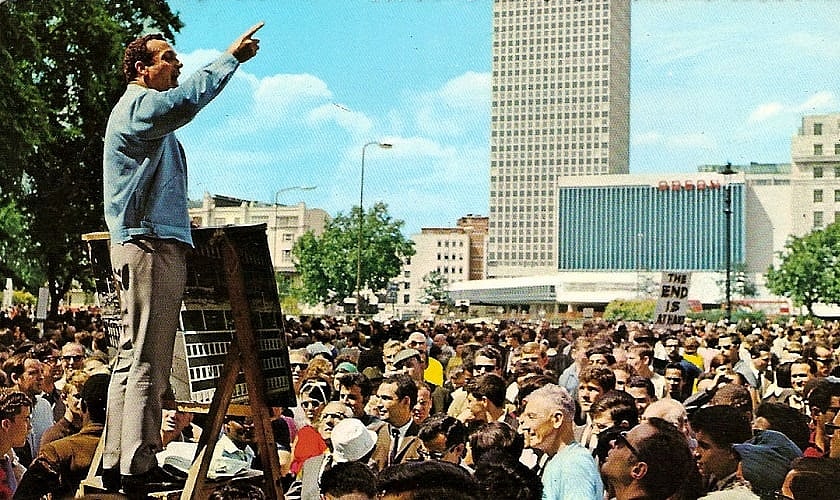
The direct opposite of the “weighing scales” approach is the polemic. In this kind of essay, your reader is in no doubt at all about what your point of view is; unfortunately, they’ve heard rather too much of it and rather too little of anything else. Continuing on the same example as above, in the polemic, you might argue that prison is wholly negative, based on punishment not rehabilitation, leading to worse outcomes for prisoners than alternatives like community service, and introducing ‘new’ criminals to experienced ones so that they end up learning not how to avoid crime, but how to become better at it. While all those points are reasonable, the issue is that the other side is altogether missing. In a “polemic”-style essay, the writer rejects the other side so much that they won’t even discuss their ideas. That’s not persuasive; you also need to spend time acknowledging and refuting the alternative point of view. You don’t need to accept it, only explain where it comes from, and why it’s mistaken.
4. The literature review
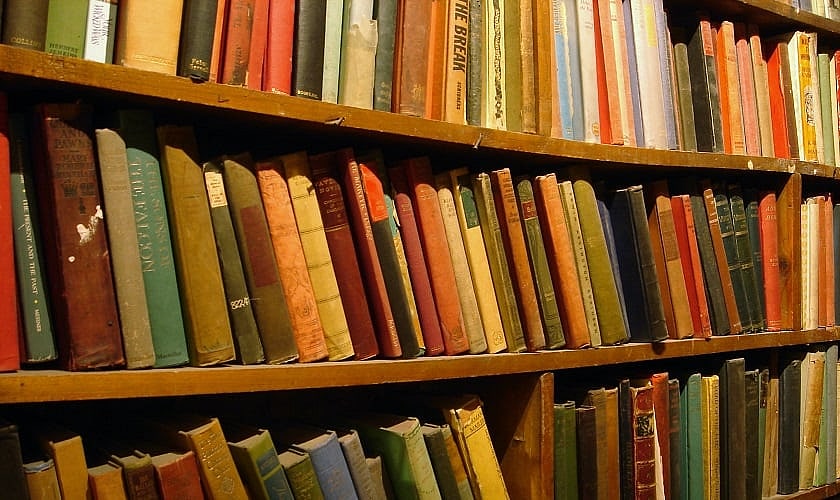
A literature review is a perfectly valid piece of writing: it’s where you look at everything that’s been written on a particular topic, and compare, contrast and analyse the writers’ stances without interjecting too much of your own views. It’s a standard part of theses and dissertations, allowing you to establish the thoughts of the major authorities in the field so that you can refer to them later in the piece without the need for a lengthy introduction. But if you’re not supposed to be writing a literature review, then your essay shouldn’t resemble one. After all, it’s about assessing your knowledge, ideas and opinions, not everyone else’s. When a subject has been written about extensively, it can feel impossible to produce an original thought on it. You can end up attributing every point you want to make to another writer, because otherwise it can feel like plagiarism. But while every point might have been said before, your route through them and your reasoning will still be original. Make sure your own point of view is established, without relying too heavily on the literature.
5. The plagiarist
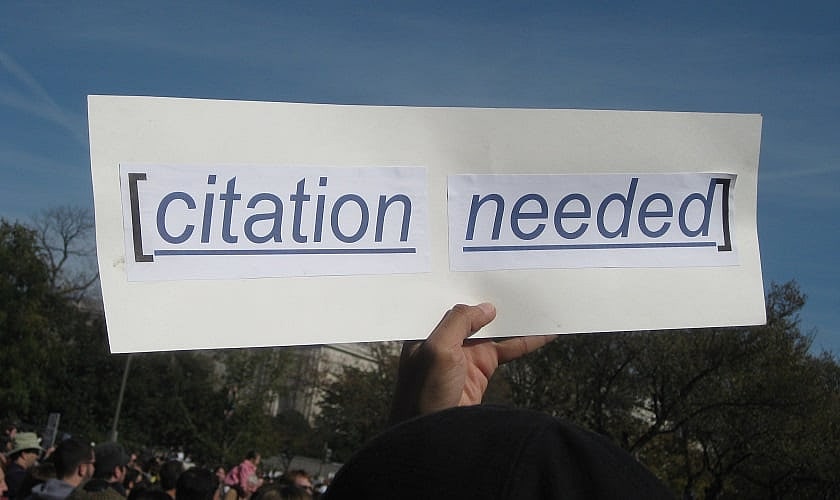
The opposite of the literature review, the “plagiarist” is the essay that passes off a little too much as your own work when it really ought to be credited to someone else. To be clear, we’re not talking about genuine copy-and-paste plagiarism (or the same thing with a couple of words tweaked and examples changed, which is no better) – that’s not a pitfall, that’s grounds for expulsion. This is instead where you’ve maybe read an idea, forgotten which article or book you read it in – or even that it wasn’t your idea in the first place – and put it in an essay without a citation. But even if you didn’t do it deliberately, it’s likely to be frowned on by your teachers. The only way to avoid the “plagiarist” essay is to take more thorough notes when you’re working on an essay. If you read something interesting, even if you don’t think it’s relevant, make a note of where you found it in case you do want to refer back to it. If you’re feeling really lazy, just take a photo of the details on your phone. Then you can make sure you’re not taking credit for ideas that aren’t your own.
6. The long introduction
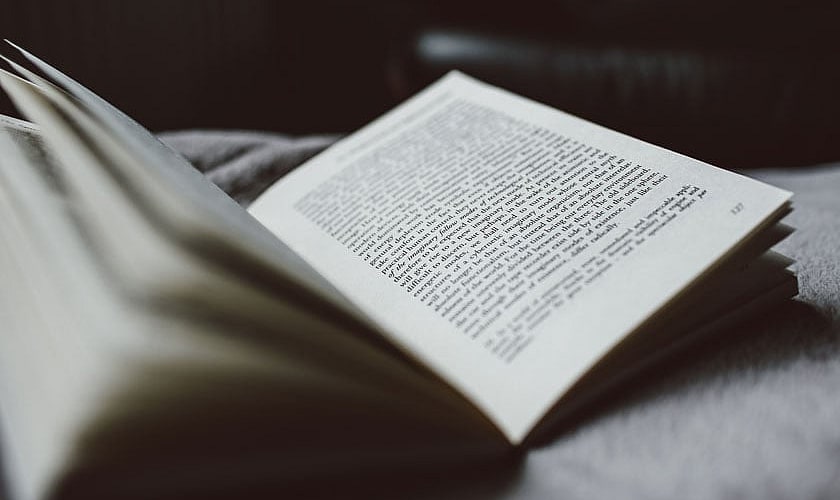
This one is reasonably self-explanatory – it’s when it feel like the majority of the essay is introduction or scene-setting, and you never really get to the point. To go back to the earlier example of an essay on the causes of the First World War, a “long introduction” essay would spend paragraphs describing the context, the different countries and personalities involved, not to mention their histories – and then, running out of word count, would cram in a paragraph or two at the end about how all of this resulted in war. A “long introduction” essay can be the result of misjudging the word count (and more on that later) but it can also be the result of knowing a great deal about a topic and not wanting to commit to an argument. Avoid the long introduction by making sure your argument is clear from your introduction onwards. Sometimes students also structure an essay by starting with their weaker points and leading to their best point, as a kind of rhetorical crescendo. This can be effective if done well, but it can also lead to a “long introduction” essay as your reader has to sit through paragraphs of muddle waiting for you to get to your real knock-out idea.
7. The textbook

Another perfectly valid piece of writing that nonetheless makes for a poor essay is the “textbook” approach. Instead of writing an essay – with points, examples, explanations and an argument running through it all like a stick of rock – you write an explainer on the topic. This is akin to the list, but typically better written and structured. A “textbook” essay is not necessarily a bad piece of work; it’s just not what’s being asked of you when you write an essay. Sometimes, when students are shy about expressing their opinion, a “textbook”-style essay is the end result. They outline all the examples and explanations that they might have included without committing to the points. The end result is an essay where the student’s point of view could perhaps be inferred from the approach taken, but where it isn’t made explicit. If this is you, try to express your opinion more assertively; you might be avoiding saying things like “I believe” (as usually essays shouldn’t contain the first person) but try phrases like “it is clear that” or that such and such an alternative argument “is flawed”.
8. The revision notes

The “revision notes” essay is not an essay that resembles revision notes; instead, it’s an essay that’s so painfully light on detail that it reads like you used revision notes rather than doing the reading or research that you were supposed to. It skims over dates; it focuses only on the main characters of a novel; where a reader might expect it to cite another theorist, it avoids it with vague statements such as “many people have argued that…”. Assertions go unexplained and unproven. Typically the reason a student writes an essay like this is because they’re out of their depth; they haven’t done the work or understood the topic well enough to go into any more detail. If you’re finding that you’re writing this sort of essay even when you do know your topic, go through and see where more detail could be added. Even something like adding dates for events in brackets can give the sense that you know what you’re talking about. Similarly, try to use examples that aren’t the most obvious or default choice for the point that you’re making. It might feel unnecessary when you know the person marking your essay knows these details already, but you have to prove that you know the details as well.
9. The word count challenge
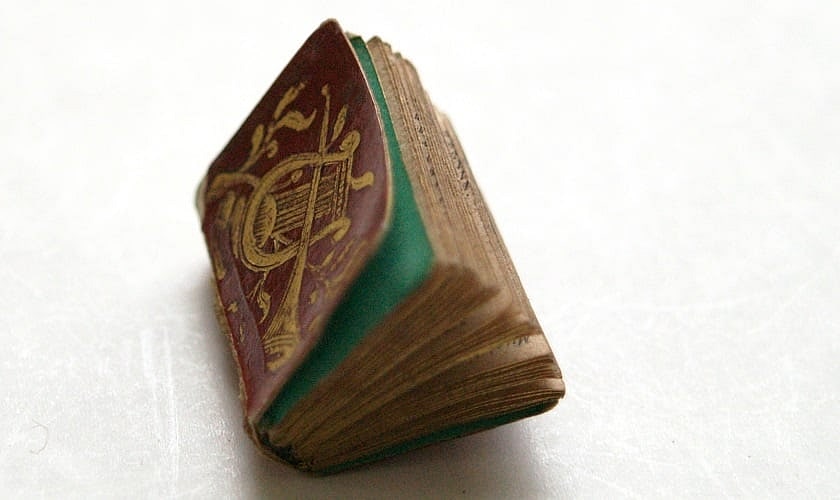
This goes in both directions – the essays where you’re restricted to 2,000 words and you feel like you could write a novel on the subject, and the ones where you have to write 2,000 words and you feel like you could barely manage a paragraph. Every student will have developed some tricks for getting round this, such as changing the margins or font size, or adding or removing contractions and adjectives. Of course, your teachers are wise to this. It’s much better to write an essay that’s appropriate for the length set in the first place, which means planning it out carefully. If you have what feels like too few points for the word count, can you go into more detail on those points? And if you have too much to say, can your points be grouped together for more of an overview that skips out the finer detail? Or perhaps your approach is too broad, and you can stick more closely to the question asked to condense what you want to say. This is particularly relevant for exams, where realising that you have more to say than time to say it in can be disastrous; the way to avoid it is practising until you have a better sense for how much content you need for a certain exam duration or word count.
Image credits: writing an essay ; list ; scales ; speaker ; books ; citation ; long book ; textbooks ; post-it note ; miniature book .
6 Tips To Fix Bad Writing
by Kellie McGann | 41 comments
Some of the most common feedback I get, besides my ridiculous comma usage, is that much of the writing sounds awkward. It can be a few words, a sentence, or even a whole paragraph. This bad writing is confusing to read and the sentences “just don't sound quite right.” How can I fix it to make my writing better? Let's take a look.
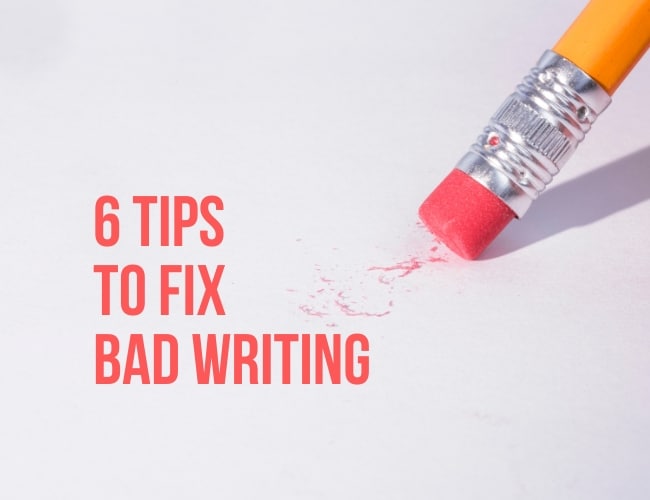
Writing skill sometimes comes naturally, but far more often, it is the product of hard work, feedback, and revision. Beginner writers who avoid revision or feedback are destined to be stuck in poor sentence structure, unclear paragraphs, or grammar errors until they commit to change.
The first thing to realize is that you aren't alone. bad writing does not mean you are a bad writer—it means you are still in revision. Awkward writing is common, and I believe that it's actually a good sign. Awkward writing means that you are writing and have begun to silence your inner critic.
6 Tips to Fix Bad Writing
As I've worked to develop a working writing style , it's taken me a lot of awkward sentences, phrases, and words, but after editing (and many writing lectures from Joe), I've developed a few tips to avoid the bad writing. Here are six tips that helped make my writing better (hopefully they help you, too!).
1. Read Out Loud
This is the first step to checking your piece for awkward writing: read it out loud . I wrote a post about this a while back, and it's still your best bet to check for awkward writing.
When you read something out loud, you catch common errors. When you read silently, your brain skips over errors, repeated words, and odd phrasing. Reading aloud reveals confusing word order that might cause your reader trouble.
How do you know if something is awkward? When you have to stop to reread. Don't make the mistake of thinking, “Oh, I just misread that…” no. If you have to stop and restart a sentence, it means something disrupted the flow of the grammar that your brain expected.
If you have to re-read your writing, your reader will have to, too. It interrupts the flow and distracts your reader.
Bonus tip: if you need help developing an ear for language that will translate into stronger writing skills, practice reading all kinds of writing aloud. Your favorite authors in your genre, short stories , and the most overlooked ear training: poetry.
2. Shorten Your Sentences
The next way to avoid awkward writing is to take out every unnecessary word , phrase, and sentence. As writers, we like to use words. But when we're trying to explain something, less really is more.
Which sentence is clearer?
When we make up reasons and explanations to avoid doing hard things, we are creating obstacles in the way of our success.
Excuses are enemies to our success.
The first sentence is awkward and confusing, while the second sentence is clear, straight to the point, and less than half the length.
You can also use a writing app like Hemingway to increase readability and identify places where your sentences might be too long and rambling.
And while Jane Austen may have written grammatically correct, beautiful sentences that stretched for entire pages, you'll likely find that readers today don't have much patience for it. Know what your genre's audience expects and deliver.
3. Be Specific
Often when our writing is awkward, it's because we are being vague.
Here's a recent example from a book I'm working on:
We can never know the things that hold us back if we do not receive input from other people.
The sentence doesn't tell us what is holding us back or whom we need input from. It is awkward and leaves the reader confused. My editor commented on the sentence, “ What does that even mean?”
So let's be specific. How's this:
We are unable to see what past circumstances hold us back unless we allow input from trusted mentors or friends.
The second example is more specific and easier for readers to understand.
Fixing awkward sentences involves a lot of re-wording. Almost every sentence can be worded a hundred different ways, but as writers, our job is to find the best, yet simplest, wording.
When re-wording, avoid the passive voice and any repetitive words or themes. For example:
He was passed by the green car with a driver who held a cell phone in one hand, a sandwich in the other, and screamed as he flew by.
That sentence has a lot of information, is repetitive, and is written in the passive voice .
Let's re-word it:
The driver of the green car had his cell phone in one hand and a sandwich in the other as he flew by screaming.
This second sentence is now in active voice and less awkward after some re-wording.
The way you build your sentences will depend largely on your writing style and genre, but make sure they remain clear and effective for the pace and tone of the piece of writing .
5. Tighten Bad Writing
Awkward writing meanders without purpose. Sometimes it's plagued with strings of verbs stacked on top of each other, other times it's repetitious. This isn't something you can do well in a first draft: you tighten and polish in the second or third pass.
It is the difference between having a bunch of mediocre sentences and sentences that build upon each other to illustrate exactly what the author intends.
A great example of a tight writer is Stephen King. He does this by creating a build-up and flow in each sentence he writes. As he says in On Writing:
I got a scribbled comment that changed the way I rewrote my fiction once and forever. Jotted below the machine-generated signature of the editor was this mot: ‘Not bad, but PUFFY. You need to revise for length. Formula: 2nd Draft = 1st Draft – 10%. Good luck.’
For example, here's a sentence that's stacking verb phrases unnecessarily:
In order to find out the suspects who might have committed the crime, Detective Harriday was planning on going to try to find and to search the town hall records for buyers interested in the property.
To tighten, ask yourself WHO is DOING what? And get that subject verb combo together.
Revised: Detective Harriday searched the town hall records for interested buyers.
Notice how the long verb strong, “ was planning on going to try to find and to search” could really be one word: searched. That's tightening your writing, and verbs are a great place to begin.
Check out our new post on strong verbs here to help!
Although I'm an optimist, sometimes, there's just no hope for an awkward phrase. When you've stared at it for hours and tried re-writing it twelve times, it's time to ask yourself, “ Is this necessary? ” If it's not necessary, you don't need it.
There is freedom in the delete button. Hemingway famously took out sentences in his drafts. He wanted his readers to feel the space, and he trusted them to fill in the blanks. It kept him from overwriting.
Make your writing better with these tips
Over the last few weeks, these tips have helped me fix my own bad writing, and I'm able to share it with clients now too.
Do you have any tips to fix bad writing? Let us know your most helpful tip in the comments below.
Take fifteen minutes and look at an old piece and search for any awkward writing. Try fixing it with one of the tips above and share it in the Pro Practice Workshop here!
Kellie McGann
Kellie McGann is the founder of Write a Better Book . She partners with leaders to help tell their stories in book form.
On the weekends, she writes poetry and prose.
She contributes to The Write Practice every other Wednesday.
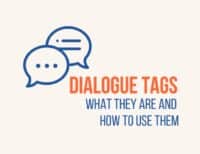
41 Comments
Ha! I agree with every word, yet every time I rewrite, I seem to add about 20%! It’s not that your tips are not valid: every one is important and useful, however, not every rewritten story will end up 10% less…
Not that my writing doesn’t need pruning, it’s just that when I get the story down, I tend to write a lot of the action and dialog and omit a lot of details (setting, description, etc). When I rewrite, I go over awkward wording, tighten sentences, add sentences to improve the flow AND fill in the missing settings and description. It always ends up clearer, richer, and longer.
Bottom line: we each write differently and should make the effort to learn our own writing style and how to work with it in rewrites.
Oh, and one more point that I look for in rewrites: filtering phrases. e.g. “I saw him walk the dog every evening” would be stronger as “He walked the dog every evening.” If you want to make a point of the character seeing him do it can add, something like “drawing me to the window to watch him as he passed.” Loads of words/phrases like that that I’m constantly pruning.
I like that advice! It makes our writing a lot stronger! Thanks for sharing!
Reading out loud has really improved my writing. nice post.
Reading out loud is the greatest! Glad you liked the post!
Good tips, Kellie!
Thanks Seth! You’ve definitely helped me figure out some of these tips! 🙂
An excellent article, Kellie. I believe that reading out loud will catch mistakes and awkard writing. I have learned to cut out useless words, and shorten sentences, which definitely improve my manuscript. At times I feel as if my writing is too simple. Any tips on how to make it more sophisticated or classy without using ‘flowery’ adjectives? Thanks so much.
Reading out loud can definitely help you identify if something doesn’t sound quite right.
Sometimes writing simple is a good thing, because it isn’t bogged down by flowery adjectives, like you mentioned. I really admire writers who are direct and clear with their words. But if you do want to make it more sophisticated or classy, maybe try reading some of your favorite authors and see how they do it, and if you like it, you could take bits and pieces of their styles to create your own. I’d love to read some of your work some time. : )
I totally agree that reading out loud helps. I am also an avid users of flowery adjectives and it is a hamper to the telling of a story. I get too caught up in description, making sure the readers sees, that I am causing the reader to oversee one scene, but not really see the big picture. How can I stop this?
I often find myself changing/tweaking words when I read my work aloud; that is my first clue. Most of the bestsellers I’ve read don’t use challenging language (words you have to go look up in the dictionary). Sophisticated prose is overrated, just keep the story moving. One of my instructors told us you can’t overuse the word “said” in dialogue, apparently other more colorful verbs distract the reader.
I have heard the word ‘said’ being described as an ‘invisible word’ in that it is completely unobtrusive yet helps a story along.
Great tips! And I’m glad I’m not the only writer out there with “ridiculous comma usage” 🙂
I might want to check with a doctor for breathing problems, cuz I have commas in everything. hehe
Debra, yeah, might want to get that checked. What would we do without our beloved commas though?
huff and puff and have a lot of run on sentences and and and and *bends over gasping for breath*
Haha, you are not alone. It can get out of control. I just love commas! 🙂
All of these are excellent advice! Thank you! 😉 <3
It's very important to delete any writing that is not necessary to the story! If you hate "killing your babies," as I believe Hemingway called it, save them in a file for a future piece. Peace, Sherrie Sherrie Miranda's historically based, coming of age, Adventure novel “Secrets & Lies in El Salvador” is about an American girl in war-torn El Salvador: http://tinyurl.com/klxbt4y Her husband made a video for her novel. He wrote the song too: https://www.youtube.com/watch?v=P11Ch5chkAc
My kids get confused because of all the grammar rules. Me, too! I try to teach us that simple sentences are best. I like commas. I hope I am using them correctly.
I love commas. Commas, commas, and more commas. My editor loves it too 😉 Keeps them in business.
Great post! These tips are really helpful as I continue to refine my writing for my new blog and my ongoing novel writing. Thanks for sharing!
Glad the post helped! I still have to remind myself of these every day! 🙂
‘The Elements of Style’ by Will Strunk appeared in 1935. Regrettably, every computer owner appears determined to re-invent the wheel.
Omit needless words. Make every word tell. Obey the rules. Simple!
That’s great. I’ll have to check that out! It seems so simple, but I find I need to be reminded constantly in order to remember!
Looking at your title, I first wondered which “six tips to avoid”?
Good point! I can see how you could read it that way. Ahh, always so much to learn 🙂
Thanks, Kellie! I needed this today, as I am the Queen of the run-on, never ending sentence! LOL!
Felicia, I hear you. I am learning this lesson the hard way! I like my words and often want to keep them all! My editor keeps yelling at me though. 😉
I do a lot of rewording and especially eliminating passive voice. But I must be wordy because in Point #2 I find the first sentence says something the shorter second one doesn’t. I find it an interesting thought that excuses actually put obstacles in the way of success. Or how about a colloquial version: When we wriggle out of doing hard things, we’re actually piling rocks on our path to success.
When it comes to being specific, and for the sake of clarity, avoid It-itis. For example: If it’s not necessary and plain confusing, it’s okay to delete it. In your little quote we’re all on the same page as to what you’re referring to, but in some books I’ve seen a lot of its wreaking havoc with clarity.
Shorten sentences, tighten, re-word…all great advice. I try to replace adjectives with a more descriptive verbs on the first round of edits as well.
Jason, that’s good advice! I’ll try that next time! Glad the advice resonated with you!
I try and avoid awkward writing, by continuously correcting (read fixing) as I go along. The real danger there is the breaks in the flow of thoughts. Your 6 tips are a far better alternative. Thanks
I too am constantly rewriting and rewriting. I am never satisfied with a sentence. I am constantly asking myself, “Did I tell too much and not leave enough to the reader’s imagination?” So in comes the overwhelming flowery adjectives and with the constant rewriting, I lose my flow and it gets harder to connect scene to scene until finally, I have to start all over and then basically almost end up with what I started it. Sometimes I feel like a hamster traveling on his wheel. Do you think another pair of eyes would help me get off this viscous cycle and help advance my writing?
Parker, that’s the bane of a perfectionist…a tendency to overthink things. If you keep questioning your thoughts as you write, they will hold you to an answer, thus creating breaks in your writing. The fact that you commenced writing shows that you are convinced about what you want to write. So, believe in your self and let the thoughts flow.
Thanks, words of encouragement are always needed and much appreciated.
All my writings, old or new, are made to go through an axe. They are filtered & re-filtered often with the way you write it too. The struggle with words, phrases, commas, length is a never ending end. This is something, even if ever, claim yourself to be the best, will end up perfecting through. Reading your article, was a check up list, If following the same pattern though. Each one of us, bestowed with weak spots. I find myself often stuck in the rut of long sentences & similar words. That does not mean, I’m a scorer on other fronts.
A regular submitter on your site, offers everyday the privilege of De-Awkwardifying. The momentum has to go on, even if you know, you are far from being right….
All very true….especially about 2nd draft = 1st draft – 10%
Dan, yes! I’m working on a second draft now and it’s partially painful cutting it down, but so necessary.
This is brilliant, especially: there is freedom in the delete button! I hunt out redundant modifiers such as ‘final outcome’ or ‘important essentials’. This always improves my writing.
Thanks for the article, Kellie – sharing.
I’m focusing on finishing a short story that surrounds around a young teenage girl who trying to cope with being diagnosed as depressed. After some more rewriting here it is.
I had just turned sixteen, the year of driver license, college campus tours, and the peak of teenage angst, but the typical path to that was halted when my school’s guidance counselor requested for my mom and dad to to be brought in for what she described as a “heart to heart” confrontation. She wanted to discuss about my lack of socializing in school and the dark “troubling” poetry I had turned in for English class, previous weeks before. So as we all sat in the cramped off white office, crowded with cheap knick knacks and positivity posters you only ever see hanging up on a cubicle wall, she discussed that my best option for mental improvement would be enlisting the knowledge of a professional therapist since she feared I was at risk for being diagnosed as depressed, which would explain my anti-social behavior and troubling writing, because Lord knows you have to have an explanation to everything in life.
That’s how I found myself sitting, in the crappy conference room of the local library, on a cheap metal folding chair, listening half heartedly, to the supposedly uplifting speech spewing out of the leader of this so called group. Tom. We had all heard the speech at least a dozen times from Tom. After discovering in a pamphlet, while waiting in his local Wallgreens physician’s office for his annual flu shot, that 30.7 percent of Americans lived with a mental illness. I’m sure he also learned from the pamphlet almost half of Americans don’t get the needed amount of Vitamin D.
Sprinkle in some courageous words and throw in a couple overused quotes from a Hallmark card and you basically got the whole speech. Tom stated many, many, many times before, that he wanted to be a “guidance angel” for those diagnosed and thus Youth Mental Awareness or Y.M.A was formed. Y.M.A is for people thirteen to nineteen to talk about their illness.
I mainly showed up for the food.
This is how it went every Thursday night for the past six months, I would make up some weak excuses like a stomach ache, which would never work and then I would reluctantly drive to the Library and for the next hour and a half, listen to depressing stories from people I don’t know. Thus letting me let go of any frustration about my illness and letting the positivity engulf me.
It’s a real lifesaver.
The meeting goes like this, We introduce ourselves by stating our names, age, and illness. I usually go first since we start youngest to oldest, so I stand up, fiddling with my sleeves and start talking “Spencer, sixteen, depression.” Tom would try to coax me into talking a little bit more which I will answer with “I’ll pass” and then sit down again which by now, I’m greeted by a feeble round of applause and we continue going around till everyone has introduced themselves.
So in our group we have twelve people, that means if you do the math correctly, four depressions (one of those being me) four anxiety, three bipolar, and finally, four OCD. That probably sounds harsh, but it’s true, and the truth hurts, like a mother. Then after listening to someone’s story about their trials they passed or struggles they overcame, we all grip each others hand to recite the Y.M.A motto which is “United through others, we are stronger than those who are not.” Long, stupid, and cliche. Very fitting. It’s also very hard to focus on reciting it when a stranger’s sweaty hands are clutching yours. After that, I’m finally granted my rightly given freedom and the meeting disperses.
I walk through the double sided exit doors and strolled out to my car. I fumbled for my car keys while I called mom, finally starting the engine when she picks up on the third ring. “Hey mom” “Hey Honey, how was your meeting?” I buckled my seat belt and switch on the radio. “Same old same old, I just wanted to let you know I’m leaving now so I’ll be home in ten.” “Alright drive safe.”
She clicked off and I turned onto the road to home. After a few minutes I turned onto my street and drove pass a manicured lawn after manicured lawn until I pulled into the driveway, greeted by red shutters and lawn gnomes, everything about the house screamed “upper class suburban white family” but it was home. I locked my car and walked onto the porch. Opening the front door, the tangy smell of Chinese take out wafted through the air, I closed the door and tossed my purse in the hall closet before walking into the kitchen where I found mom setting takeout cartons on the kitchen table. ‘Hey mom.” “Hey Spence.” She gave me a quick kiss on the cheek.” “Wash your hands and then sit down to eat.” I turned on the kitchen faucet and scrubbed my hands. “Where’s dad?” “Speak of the devil.” He walked in and popped a sweet and sour chicken in his mouth. “Sit and eat.” Mom firmly instructed. I took a seat as mom passed plates, loading up our plates as we discussed our day, just like we always have done, ever since I can remember.
“You have your appointment with Mrs. Lark tomorrow at 10:00.” She gingerly included in the conversation, like she was defusing a bomb. I still don’t think she’s entirely comfortable with knowing I have Depression, but who can blame her, what’s the first thing that pops into your mind when you hear the word Depression? “I know” I swallowed a bite of food. “I can go with you if you want.” “I’ll be fine.” I grabbed the empty plates and took them over to the sink to wash them. “Are you sure?” “Yes, I’m sixteen, I got to spread my wings a little, learn to fly.” She still seemed slightly unsure so I tried to put her at ease. “I’ll be fine, I promise.” She hesitated for a moment before finally agreeing. “Okay.”
After dinner we sat in the living room to watch a stupid 80‘s movie, filled with cheesy one liners and cheap special effects. “Alright troops.” Mom got up to stretch. “I’m headed to bed.” Dad got up as well before saying “I think I’ll join you. “ I kissed them both Goodnight before they trudging upstairs, and I dug out a pint of Ben and Jerry, switching the TV channel onto a Real Housewives of Beverly Hills marathon. Nothing boosts my self esteem like watching plastic surgery induced women fight over overpriced shoes, which I watched till their diamond started to blur together.
I turned off the TV and walked upstairs to my bedroom. I pulled my pajamas and slid into bed, snuggling into my blanket. I tried to fall asleep, but it seemed it was going to be one of those nights where all you can do is think. About your future, your past, and your present. The gears just start turning and you can’t stop them no matter what, which usually leads to some sort of life crisis at One o’clock in the morning, but for now all you can do is think. Everything you put off thinking about comes back to haunt you at night, when the air is still and the only thing keeping your company is the rhythm of your breathing.
I guess I finally fell asleep because the next thing I knew I was goggling reaching to turn off the annoying beeping of my alarm clock. I stumbled downstairs after trudging out of bed and jumping in the shower. I found mom eating breakfast and reading the newspaper. I grabbed the orange juice out of the fridge and poured myself a glass.
“Morning honey.” “Hey mom.” I took a swig of OJ. “I’ve got to swing by the office today for a few hours so I won’t be back before you.” “Okay.” She picked up her paperwork and stuck it in her briefcase, quickly kissing the top of my forehead before grabbing her car keys. “I love you kiddo.” “I love you too.” She swept out the front door, but not before saying “If there’s any issues just call me.” then she left. After breakfast, I worked on catching up on Real Housewives of Beverly Hills till I had to leave . I grabbed my car keys, left for my appointment and drove to the building lot where Mrs.Larks therapist office was located.
I walked in and signed in, I took a seat in the waiting room before Mrs. Lark walked out of her office, comforting a hysterical woman and a grim faced face man who I assumed was her husband. “Hey Spencer.”
She motioned for me to walk into her office. I sat down on the familiar lumpy beige couch and examined the plain colored walls framed with cheap knockoff artwork of the Italian riverside, facing wall to wall bookshelves that housed degrees and diplomas.
Mrs.Lark tucked a piece of blonde hair behind her ear before grabbing her notebook and pen off of the side table. “How have you been?” She asked. “Alright.” “Any issues with your medicine?” “None so far.” She scribbled on her clipboard. “Okay well, I thought we could try something new this session.” “And that would be?” “Let’s discuss your fears, what’s the first thing that pops into your mind when you then ask yourself what you fear?” I thought or a moment. “I really don’t know.” “Just anything heights, snakes, storms?” “I don’t really fear those things, I mean that’s just common sense.” “What do you mean?” “I don’t fear skyscrapers but I’m not going to jump off of one.” “So you are saying you don’t fear anything?” “I wouldn’t say that, I just don’t know what I fear.” “Interesting.” She scribbled on her clipboard.
We talked some more about the typical shrink stuff like my feelings and crap like that, then the session was over. I thanked her and walked out to my car and drove to the nearest Starbucks. After ordering my latte I walked over to Williams Deans Park, which was basically just a plot of land with a ratty playground and ran rusty bench. If I had a park named after me when I bit the dust I would like something a little nicer than a run down playground. I took a sip of coffee and started to think about the fear exercise. I wanted to know what I feared, not just some stupid life metaphor that sound like it should be plastered on a daytime drama.
I don’t even fear death, I’ve pretty much just accepted death as just something we all have to face in order to make room for others in life. I thought harder. What about how I felt last night, the terrifying feeling of knowing that there are going to be times where I will not know what to do in my life, or feel that sadness in the very bottom of my bones that creeps like a forgotten nightmare. The undeniable fact that I will, I’ll let myself down, or the unforgivable pressure to carry on even if it’s the last thing I want to do. Then it it me. I fear life.
Outstanding advice! Thanks for sharing, Kellie!
The power of re-wording is incredible! Sometimes it helps to change the whole reader’s perception and attitude to your writing. Besides, it’s reasonable to use a plagiarism checker to make sure that your writing has no similarities with already published works.
Trackbacks/Pingbacks
- 6 Tips To Avoid and Fix Bad Writing - I'm a Writer! - […] Source: 6 Tips To Avoid and Fix Bad Writing […]
- Tips To Avoid and Fix Bad Writing - I'm a Writer! - […] Source: The Write Practice […]
- Sunday Shareworthy Reading and Writing Links and Sundry | Live to Write – Write to Live - […] 6 Tips to Avoid and Fix Bad Writing by @McgannKellie via @write_practice […]
- Tips to Avoid and Fix Bad Writing - Sulis International - […] Read the full post, with descriptions and examples. Thanks, Kellie! […]
- Words on a page - […] 6 tips that can help you avoid and fix bad writing […]
Submit a Comment Cancel reply
Your email address will not be published. Required fields are marked *
Submit Comment
Join over 450,000 readers who are saying YES to practice. You’ll also get a free copy of our eBook 14 Prompts :
Popular Resources
Book Writing Tips & Guides Creativity & Inspiration Tips Writing Prompts Grammar & Vocab Resources Best Book Writing Software ProWritingAid Review Writing Teacher Resources Publisher Rocket Review Scrivener Review Gifts for Writers
Books By Our Writers

You've got it! Just us where to send your guide.
Enter your email to get our free 10-step guide to becoming a writer.
You've got it! Just us where to send your book.
Enter your first name and email to get our free book, 14 Prompts.
Want to Get Published?
Enter your email to get our free interactive checklist to writing and publishing a book.
Top 20 Errors in Undergraduate Writing
Main navigation.
The Top Twenty: A Quick Guide to Troubleshooting Your Writing
Readers judge your writing by your control of certain conventions, which may change depending on your audience, purpose, and writing situation. For example, your instructor may or may not mark errors in your paper if he’s more concerned with its argument or structure than he is with sentence-level correctness; he could also decide an error is not serious. Some instructors may even see the errors listed below as stylistic options. However, a large-scale study by Andrea Lunsford and Karen Lunsford (2008) found that these errors are the most likely to attract readers’ negative attention. Before handing in your papers, proofread them carefully for these errors, which are illustrated below in the sentences in italics.
THE TOP TWENTY
1. wrong word.
Wrong word errors take a number of forms. They may convey a slightly different meaning than you intend ( compose instead of comprise ) or a completely wrong meaning ( prevaricate instead of procrastinate ). They may also be as simple as a wrong preposition or other type of wrong word in an idiom.
Use your thesaurus and spell checker with care. If you select a word from a thesaurus without knowing its precise meaning or allow a spell checker to correct spelling automatically, you may make wrong-word errors. If prepositions and idioms are tricky for you, look up the standard usage.
Here are a couple of wrong word examples:
Did you catch my illusion to the Bible?
Illusion means “an erroneous perception of reality.” In the context of this sentence, allusion was needed because it means "reference.”
Edmund Spenser’s The Faerie Queene is a magnificent sixteenth-century allergy.
A spell checker replaced allegory with allergy.
2. Missing Comma after an Introductory Element
Use a comma after every introductory element—whether word, phrase or clause—to clarify where it ends and the rest of the sentence begins. When the introductory element is very short, you can skip the comma, but including it is never wrong.
Without a comma after the introductory element, it’s hard to see the location of the subject (“they”) in this sentence:
Determined to make their flight on time they rose at dawn.
3. Incomplete or Missing Documentation
Documentation practices vary from discipline to discipline. But in academic and research writing, it’s a good idea to always cite your sources: omitting documentation can result in charges of plagiarism.
The examples below follow MLA style. In this example, the page number of the print source for this quotation must be included.
The Social Media Bible defines social media as the “activities, practices, and behaviors among communities of people who gather online to share information, knowledge, and opinions using conversational media.”
And here, the source mentioned should be identified because it makes a specific, arguable claim:
According to one source, it costs almost twice an employee’s salary to recruit and train a replacement.
Cite each source you refer to in the text, following the guidelines of the documentation style you are using.
4. Vague Pronoun Reference
A pronoun (e.g., he, this, it) should refer clearly to the noun it replaces (called the antecedent). If more than one word could be the antecedent, or if no specific antecedent is present, edit to make the meaning clear.
In this sentence, it possibly refers to more than one word:
If you put this handout in your binder, it may remind you of important tutoring strategies .
In some pronoun usage, the reference is implied but not stated. Here, for example, you might wonder what which refers to:
The authoritarian school changed its cell phone policy, which many students resisted.
To improve this sentence, the writer needs to make explicit what students resisted.
5. Spelling
Even though technology now reviews much of our spelling for us, one of the top 20 most common errors is a spelling error. That’s because spell checkers cannot identify many misspellings, and are most likely to miss homonyms (e.g., presence/presents), compound words incorrectly spelled as separate words, and proper nouns, particularly names. After you run the spell checker, proofread carefully for errors such as these:
Vladmir Putin is the controversial leader of Russia.
Every where she walked, she was reminded of him.
6. Mechanical Error with a Quotation
When we quote other writers, we bring their voices into our arguments. Quotation marks crucially show where their words end and our own begin.
Quotation marks come in pairs; don’t forget to open and close your quotations. In most documentation styles (e.g., MLA Style), block quotations do not need quotations marks. Consult your professor’s preferred style manual to learn how to present block quotations.
Follow conventions when using quotation marks with other punctuation. Here, the comma should be placed inside the quotation marks:
"A woman must have money and a room of her own if she is to write fiction", Virginia Woolf argues.
7. Unnecessary Comma
We often have a choice about whether or not to use a comma. But if we add them to our sentences when and where they are not needed, then we may obscure rather than clarify our meaning.
Do not use commas to set off restrictive elements that are necessary to the meaning of the words they modify. Here, for example, no comma is needed to set off the restrictive phrase of working parents , which is necessary to indicate which parents the sentence is talking about.
Many children, of working parents, walk home from school by themselves.
Do not use a comma before a coordinating conjunction (and, but, for, nor, or, so, yet) when the conjunction does not join parts of a compound sentence. In this example, no comma is needed before the word and because it joins two phrases that modify the same verb, applies.
This social scourge can be seen in urban centers, and in rural outposts.
Do not use a comma before the first or after the last item in a series.
The students asked their TAs to review, the assignment rubric, a sample paper and their comments, before the end of the quarter.
Do not use a comma between a subject and verb.
Happily, the waiters, sat down during a break.
Do not use a comma between a verb and its object or complement.
On her way home from work, she bought, a book at the bookstore.
Do not use a comma between a preposition and its object.
On her way home from work, she bought a book at, the bookstore.
8. Unnecessary or Missing Capitalization
Capitalize proper nouns and proper adjectives, the first words of sentences, and important words in titles, along with certain words indicating directions and family relationships. Do not capitalize most other words. When in doubt, check a dictionary.
Financial Aid is a pressing concern for many University Students.
9. Missing Word
If you read your work outloud before submittingit, you are more likely to notice omitted words. Be particularly careful not to omit words from quotations.
Soccer fans the globe rejoiced when the striker scored the second goal.
10. Faulty Sentence Structure
If a sentence starts out with one kind of structure and then changes to another kind, it will confuse readers.
The information that families have access to is what financial aid is available and thinking about the classes available, and how to register.
Maintain the grammatical pattern within a sentence. Each sentence must have a subject and a verb, and the subjects and predicates must make sense together. In the example above, thinking about the classes available does not help the reader understand the information families have access to. Parallel structures can help your reader see the relationships among your ideas. Here’s the sentence revised:
Families have access to information about financial aid, class availability, and registration.
11. Missing Comma with a Nonrestrictive Element
A nonrestrictive phrase or clause provides additional information that is not essential to the basic meaning of the sentence. Use commas to set off a nonrestrictive element.
David who loved to read history was the first to head to the British Library.
The clause who loved to read history does not affect the basic meaning of the sentence. The clause could be taken out and the reader would still understand that David was the first to head to the British Library.
12. Unnecessary Shift in Verb Tense
Verbs that shift from one tense to another with no clear reason can confuse readers.
Martin searched for a great horned owl. He takes photographs of all the birds he sights.
13. Missing Comma in a Compound Sentence
A compound sentence consists of two or more independent clauses. When the clauses are joined by a coordinating conjunction (for, and, nor, but, or, yet, so), use a comma before the conjunction to indicate a pause between the two thoughts.
Miranda drove her brother and her mother waited at home.
Without the comma, a reader may think at first that Miranda drove both her brother and her mother.
14. Unnecessary or Missing Apostrophe (including its/it's)
To make a noun possessive, add either an apostrophe and an s (Ed's phone) or an apostrophe alone (the girls’ bathroom). Do not use an apostrophe in the possessive pronouns ours, yours, and hers. Use its to mean belong to it; use it's only when you mean it is or it has.
Repeated viral infections compromise doctors immune systems.
The chef lifted the skillet off it’s hook. Its a fourteen-inch, copper skillet.
15. Fused (run-on) Sentence
A fused sentence (also called a run-on) joins clauses that could each stand alone as a sentence with no punctuation or words to link them. Fused sentences must be either divided into separate sentences or joined by adding words or punctuation.
The house was flooded with light, the moon rose above the horizon.
He wondered what the decision meant he thought about it all night.
16. Comma Splice
A comma splice occurs when only a comma separates clauses that could each stand alone as a sentence. To correct a comma splice, you can insert a semicolon or period, connect the clauses with a word such as and/or/because, or restructure the sentence.
The students rushed the field, they tore down the goalposts.
17. Lack of pronoun/antecedent agreement
Pronouns typically must agree with their antecedents in gender (male or female, if appropriate) and in number (singular or plural). Many indefinite pronouns, such as everyone and each, are always singular. However, they can be used to agree with a singular antecedent in order to use inclusive or gender-neutral language. When antecedents are joined by or or nor, the pronoun must agree with the closer antecedent. A collection noun such as team can be either singular or plural, depending on whether the members are seen as a group or individuals.
Every guest left their shoes at the door.
18. Poorly Integrated Quotation
Quotations should be logically and smoothly integrated with the writing around them, the grammar of the quotation complementing the grammar of the neighboring prose. They usually need to be introduced (with a signal phrase) rather than dropped abruptly into the writing.
An award-winning 2009 study of friendship "understanding social networks allows us to understand how indeed, in the case of humans, the whole comes to be greater than the sum of its parts" (Christakis and Fowler 26).
"Social networks are intricate things of beauty" (Christakis and Fowler xiii). Maintaining close friendships is good for your health.
19. Missing or Unnecessary Hyphen
A compound adjective requires a hyphen when it modifies a noun that follows it.
This article describes eighteenth century theater.
A two-word verb should not be hyphenated.
The dealers want to buy-back the computers and refurbish them.
20. Sentence Fragment
A sentence fragment is part of a sentence that is presented as if it were a complete sentence. The following illustrate the ways sentence fragments can be created:
Without a subject
The American colonists resisted British taxation. And started the American Revolution.
No complete verb
The pink geranium blooming in its pot.
Beginning with a subordinating word
We visited the park. Where we threw the Frisbee.
These 20 most common errors can be avoided in your writing if you reserve time to proofread your final draft before submission.
Works Cited
Lunsford, Andrea A. and Karen J. Lunsford. “Mistakes are a Fact of Life: A National Comparative Study.” CCC 59 (2008) 781-806.
Think you can get into a top-10 school? Take our chance-me calculator... if you dare. 🔥
Last updated March 5, 2024
Every piece we write is researched and vetted by a former admissions officer. Read about our mission to pull back the admissions curtain.
Blog > Common App , Essay Examples , Personal Statement > 20 College Essay Examples (Graded by Former Admissions Officers)
20 College Essay Examples (Graded by Former Admissions Officers)
Admissions officer reviewed by Ben Bousquet, M.Ed Former Vanderbilt University
Written by Alex McNeil, MA Admissions Consultant
Key Takeaway
Have you ever wondered what goes through an admissions officer’s mind as they read college essays?
Now’s your chance.
This post takes you behind that dark, mysterious admissions curtain to show you what exceptional, good, and “bad” college essays look like. And we don’t just show them to you.
We’ve asked our team of former admissions officers to read through the essays, analyze them, offer editing ideas, and assign them grades.
So join us on this college essay example journey so you know what to do (and what not to do) as you write all your college essays this fall.
Let’s get started.
How to Use College Essay Examples
Here’s the thing. People in college admissions have lots of different opinions about whether students should read example essays. But we believe that reading example essays is a crucial step in the college essay writing process.
If you don’t know what a college essay looks like, then how should you expect yourself to write one?
So reading examples is important.
However! There’s a caveat. The point of reading college essay examples isn’t to copy them or even to get inspiration from them. It’s to analyze them and apply what you’ve learned to your own college essay.
To help you do that, our team of former admissions officers has taken this super-comprehensive compilation of college essay examples and pointed out exactly what you need to know before you start writing.
Let me break down how this post works:
Categories:
We’ve put together a great variety of college essay examples and sorted them into three categories, including…
- Best college essay examples: these examples are the creme-de-la-creme. They’re written by a small percentage of students who are exceptional writers.
- Good college essay examples: these examples are solid. They do exactly what they need to do on the admissions committee floor. You’re aiming to write a good college essay.
- “Bad” college essay examples: these examples illustrate a few of the most common college essay mistakes we see.
Our former admissions officers have assigned each essay a letter grade to help you understand where it falls on the scale of “bad” college essays to exceptional college essays.
Alongside our categorization and grades, our former admissions officers have also annotated the essays and provided concrete feedback about what works and what could be improved.
The majority of essays you’ll see here are written in response to the Common Application personal statement prompts. We’ve also included a few stellar supplemental essays at the end of the post.
How an Admissions Officer Reads College Essays
All admissions officers are different. And all institutions ask their admissions officers to read in different ways.
But there are a few strategies that shape how the majority of admissions officers read college essays. (If you want a look behind the mysterious admissions curtain, read our post about how admissions offices read tens of thousands of applications every year .)
First, we need to talk about application reading as a whole.
Remember that admissions officers are reading your college essays in the context of your entire application. It’s likely that by the time they get to your essay, they’ve already glanced at your background information, activities , and transcript . They may have even looked at your letters of recommendation or additional information.
Why is this detail important? It matters because your college essays need to be in conversation with the rest of your application. We refer to this strategy as adopting a “ cohesive application narrative .” Your unique personal brand—who you are, what you’re good at, what you value—should emerge across all of your application materials.
To summarize: your college essays don’t exist in a vacuum. Your admissions officers learn about who you are from your entire application, and your college essays are the place where you get to tell them exactly what you want them to know. You should write them in a way that creates balance among the other parts of your application.
So once your admissions officers get to your college essays, what are they looking for?
They’re looking for several things. Each of your essays doesn’t have to address all of these points, but they are a great place to start:
- Personal narrative that explains who you are and where you come from
- Details about specific activities, accomplishments, or inclinations
- Personality traits that make you who you are
- Lessons you’ve learned throughout your life
- Values that you hold dear
- Information about how you interact with the world around you
- Highlights about what makes you special, strong, interesting, or unique
What do all of these points have in common? They revolve around your core strengths . We’ve written more extensively about core strengths in our college essay writing guide . But for now, just know this: your college essays should tell admissions officers something positive about yourself. They want to know who you are, what motivates you, and why you would be an active contributor to their campus.
As we go through the following example essays, remember: college essays are read alongside the rest of your application, and college admissions officers read your essays to learn about your core strengths.
Okay, let’s get to it. Ready? Buckle up.
The Best College Essay Examples
As an admissions officer, every so often you come across an essay that blows you away. It stops you in your tracks, makes you laugh or cry, or resonates deeply with you. When exceptional essays come through your application bin, you’re reminded what an honor it is to get these fleeting glimpses into incredible students’ lives.
As an applicant, you may be wondering how to write this kind of exceptional college essay. Unfortunately, there’s no simple formula. You can’t “hack” your way into it. You have to write vulnerable, authentically, and beautifully—which is much easier said than done. We have a whole guide on how to write a personal statement that stands out, so we recommend that you start there.
For now, let’s take a look at some of our favorites.
College Essay Example #1: The Gospel of Steve
The first college essay we'll look at got an A+ grade and is about the writer's experience with depression and... Steve Irwin. It's a common application essay. Check it out:
" In sophomore year, I struggled with depression((While this is a fantastic essay, this hook could definitely be stronger.)) . I felt like I was constantly battling against the darkness that seemed to be closing in on me. Until, that is, I found solace in the teachings of Steve Irwin.((This unusual last sentence drew me in when I read this for the first time.))
When I first discovered Steve Irwin and his show "The Crocodile Hunter," I was captivated by his passion for wildlife. He was fearless, jumping into danger without hesitation to save an animal in need. But it was more than just his bravery that inspired me; it was his infectious energy and love for life. Watching him on TV, I couldn't help but feel a little bit better about my own struggles.((This explicit reflection does a fantastic job connecting the writer’s experiences to this Steve Irwin reference.))
But it wasn't until I read his biography that I truly felt the impact Steve had on my life. In the book, he talked openly about his own struggles with depression. He talked about the dark moments in his life, when he felt like he was drowning in despair. But he also talked about how he fought back against the darkness, how he refused to let it consume him, and how he turned his depression into a career that allowed him to follow his biggest passions.
Reading Steve's words, I felt like he was speaking directly to me.((Another beautiful transition)) I wasn't alone in my struggles if someone as brave and fearless as Steve had faced similar challenges. And that gave me the courage to keep going. I started visiting a therapist, exercising regularly, and practicing mindfulness meditation. Day by day, I lifted myself out of my depression–all with a healthy dose of “Crocodile Hunter” each evening after I finished my homework((The writer does a great job focusing on action steps here.)) .
One of the things that I admired most about Steve was his ability to find joy and laughter in the most unlikely places. He was always cracking jokes, even in the face of danger. He taught me that laughter and humor can be a powerful tool in the fight against depression. I went looking for the humor in my own struggles. I started learning about how stand-up comedy works, and wrote my own five-minute skit finding the humor and silver lining((The writer expands their connection to Steve Irwin even more through this comedy thread.)) in my depression. I wasn’t a great comic, let me tell you. But being able to channel my experience into something positive—something that helped others laugh—was extremely gratifying to me.
Depression((The reflection in this paragraph is exactly what writers need to tie all the information together before reaching the conclusion.)) is a bizarre thing. One day, you’re besieged by it from every side and it looks like there’s no way out. Then, two months later, if you’re diligent, you look around the world and wonder what you ever had to be upset about. You find goodness and light in the things around you—your friends, your family, your habits, and your hobbies. These forces act as buttresses to keep you standing up and moving forward.
As silly as it may sound, I credit Steve Irwin with that first buttress. His experience and outlook on life gave me the push I needed to cultivate bravery and resilience in the face of my struggle with mental health. My eternal goal is now to practice the gospel of Steve—to always pass along humor, passion, and encouragement to others, especially to those who seem down and out. Thank you, Steve."
Word Count: 525
Admissions Officer Notes on The Gospel of Steve
This essay captured my attention because of its unique pairing of a tough subject—depression—with a light-hearted and endearing topic—Steve Irwin.
The writer doesn’t dwell in the experience of depression but instead finds hope and light by focusing on how their favorite TV star changed their perspective. Why this essay stands out:
- Great organization and sign-posting . The essay clearly progresses through each part of the writer’s journey. The first sentence of each paragraph signals to the reader what that paragraph will be about.
- Focus on action steps. It’s very apparent that this writer is a do-er. The focus of the essay is on the way they emerged from their depression, not on the depression itself.
- Meaningful reflection. Especially in the second-to-last paragraph and conclusion, the writer beautifully reflects on what depression and hope mean to them.
- Core strengths. From this essay alone, I gather that the writer is a sage archetype . They clearly show their wisdom and ability to persist through challenges.
Most importantly, they’ve written the essay around communicating their core strengths.
College Essay Example #2: The Embroidery Scientist
This essay is about a writer's Etsy store and the connection she draws between fashion and science.
I stretch the thin fabric over my hoop and pull it tight, wedging the nested rings between my legs to secure them shut with my other hand((This hook is compelling. It makes us ask, “What in the world is the writer doing?” We are compelled to read on to find out.)) .
Next I get out the thread. Each color is wound tightly around a paper spool and stored in a container whose original purpose was to store fishing tackle.
I look at the pre-printed design on the fabric and decide what colors to select. Orange, red, pink, yellow–this design will be as bright and happy as I can make it.
Embroidery is where the STEM and creative parts of my identity converge((Here we get a clear, explicit statement of the writer’s main point. This isn’t always necessary, but it can help your reader navigate your essay more easily if you have a lot going on.)) . My STEM side is calculated. She meticulously plans the designs, mocks them up in photoshop, and painstakingly transfers them onto the fabric. She organizes each thread color by its place in ROYGBIV and cuts every piece to an identical length of 18”. Her favorite stitch is the French Knot, with its methodical “one, two” wrap sequence. For her, art is about precision.
My creative side, on the other hand, is messy. She throws thread scraps on the floor without hesitation, and she haphazardly adds design elements in pen. She does a Lazy Daisy stitch very lazily while adding an indescribable flourish to a simple backstitch. Her methods are indeed madness: she’ll border a design with glitter glue, hang a finished project upside down, or stitch a big red X over a perfectly good embroidery. For her, art is about meaning.
While these two sides of myself may seem at odds((Seamless transition to talking about Etsy accomplishment)) , they actually complement each other perfectly. At least, that’s what 3,000 of my Etsy customers think. From three-inch hoops to massive wall hangings, my Etsy shop is a compilation of the best embroidery I’ve ever done. My precision and meaning have earned me hundreds of five-star reviews from customers whose lives I’ve impacted with my art. And none of that art would have been possible without STEM me and creative me.
My STEM and creative side complement each other in more than my embroidery life too. What began as a creative side hustle has actually made me a better scientist((Another good transition to discussing passion and talent for science)) .
Before I started embroidering, I approached the lab bench with an eye like a ruler. Poured a millimeter too much liquid? Better get a pipette. Went a degree over boiling? Time to start over. My lab reports demonstrated my knowledge, skill, and care, but they didn’t show any innovation or ingenuity. My precision led me to be a good scientist but not an exceptional one.
I realized that to be exceptional, I needed to think like a real scientist. While scientists are careful and precise, they are also interrogators. They constantly question the world around them, identifying previously unseen problems and finding creative solutions. To become the scientist I wanted to be, I needed to allow myself to be more creative((This is a good example of what reflection throughout the essay should look like.)) .
When I had this realization, I had just begun my embroidery business. I didn’t understand that my creativity could also be so useful in the lab. I set out on a new path to use more creativity in the pursuit of science.
To inspire myself, I brought an embroidery project to the lab. On it, I stitched a compound microscope and a quote from one of my favorite scientists, Marie Curie. It reads, “ I am among those who think that science has great beauty.”
In the lab now, I’m not afraid to take risks and try new things((Here we see clear personal growth.)) . When I boil my mixture too long, I still start over. But occasionally, when my teacher permits, I do a second experiment on the rejected liquid just to see what will happen. Sometimes nothing happens. Sometimes it results in utter failure. But other times, my mistakes create blue, green, and purple mixtures, mixtures that bubble and burst and fizz. All of these experiments are stitches in my quest to become a cancer researcher. They are messy, but they are beautiful((The conclusion ties beautifully back to the beginning, and we also learn what the writer is interested in pursuing in the future.)) .
Admissions Officer Notes on "Embroidery Scientist"
This writer has done an excellent job talking about two very different aspects of their identity. What I love about this essay is that the structure of the essay itself shows the writer’s creativity and precision. The essay is well-organized and precise, but the writing has a unique and creative flair. It demonstrates the writer’s point exactly. I also appreciate how the writer doesn’t just talk about these parts of their identity. They explicitly connect their creativity and precision to their future goals as a scientist.
Why this essay stands out:
- Creative approach: The writer doesn’t just say, “I have two identities: creative and logical.” Instead, they illustrate that point through the wonderful example of embroidery. Connecting embroidery with science also shows this creativity.
- Attention-grabbing hook : The introductory paragraphs place readers immediately into the essay. We’re drawn in because we’re curious what the writer is doing and how it will evolve into a more meaningful message.
- Connection between personal and academic interests: The writer makes it clear why this story matters for their life in college. The creative and precise personalities aren’t inconsequential—they have a real effect on who this person wants to be.
- Forward-looking conclusion: The writer ends by subtly telling admissions officers what they’re interested in doing during and after college.
College Essay Example #4: Poetry Slam
When I first met Simon, he was neither speaking nor singing. He was doing something in between(( This hook is a good “statement” hook that raises more questions than it answers.)) . With words that flowed together like an ancient tributary, he spoke music. His hands grasping a microphone, he swayed slowly from side to side. He was a poet. But unlike that of Yeats or Dickenson, Simon’s poetry wasn’t meant to be read on a page—it was meant to be experienced like an aural work of art. And I had never experienced anything more beautiful. Disheartened, I realized that my words would never sound like Simon’s(( These two sentences are essential because otherwise the introduction would be all about Simon, not the writer.)) .
I sat in my on-deck seat. Forgetting that I was up next, I admired his craft. The crescendos and decrescendos that mirrored his pacing, the quick staccatos that punctuated each stanza, the rhymes so subtle they almost disappeared—every second of his spoken word pulled me further from reality. I listened to his words like a devout in church(( This is good sentence pacing. A long, winding sentence is followed by a short one that keeps our attention and propels us forward.)) . Closing my eyes, I joined my hands together to count the syllables. From the outside, it probably looked like I was praying. And maybe I was. When Simon’s poem ended, the audience, though betrayed by the silence, erupted into applause.
It was my turn. I had spent an entire year perfecting my poem. My sister had grown accustomed to kicking me under the dinner table when someone asked me a question. She knew that my mind was in my beloved poetry notebook, mentally analyzing my latest draft. I’ve never been one for living in the moment. My report cards usually feature comments like, “She’s a good student but has trouble paying attention.” I’m always the first one out in dodgeball because my mind is completely absent from the school gym. But what seems like inattention to my teachers is actually a kind of profound focus(( This reflection widens the essay’s scope and reveals more about who the writer is as a person.)) .
When writing slam poetry, I become completely consumed. I like to start with the words. The rhythm and intonation come with time. For me, it’s about translating a feeling into language. It’s no easy task, but it feels like an obligation. Once the words come into being, they’re like a twister in my mind(( Good (and sparing) use of figurative language.)) . They spin and spin, destroying every other thought in their path. I can’t focus on anything else because, in the aftermath of a twister, nothing else exists.
And there on the stage, nothing else existed besides me and my poem. I spoke it into existence. Like Simon, I wrapped my hands around the microphone, willing my poem to be heard. The twister exited my mind and entered the world.
A few weeks ago(( Excellent signposting)) , I watched the recording of my first poetry slam, that slam two years ago when I saw Simon perform for the first time. I saw myself climb on stage from the dark abyss of the audience. I looked small, all alone on that big stage. My voice shook as I began. But soon, my poem rendered the stage smaller and smaller. I filled the darkness with words.
As I watched myself on my computer, I thought about how I felt that day, awe-struck in the audience by Simon’s work. I felt like I’d never be able to sound like him. And I was right. My poem didn’t sound like Simon’s, and none of my poems ever would. But in this moment, I realized that they were just as beautiful. My words sounded like me(( Beautiful conclusion that really drives home just how much this person has grown. They don’t need to sound like Simon. They need to sound like themself.)) .
Word Count: 552
Admissions Officer Notes on Poetry Slam
We would call this essay a “sacred practice” essay. It’s clear that slam poetry is deeply meaningful to the writer. They even call it “an obligation.” It’s a beautiful essay that also reflects the writer’s interest in poetry. They have some nice figurative language that adds interest to the story—it’s almost like the essay is in some ways a poem itself. And the story is a good one: it demonstrates the writer’s fears, strengths, and growth.
- Deeply meaningful: We say it all the time because it’s true: college essays should be vulnerable and deeply meaningful. This essay oozes meaning. The writer even connects their love of slam poetry to who they are as a person.
- Good organization and signposting: The narrative in this essay is a little complicated as the writer switches between the slam poetry event, reflection on past events, and reflection during current day. But because each paragraph is about a single topic, and because they use very clear topic sentences and transitions, it’s easy to follow the narrative thread.
- Theme: The main theme in this essay is that the writer found their own voice through slam poetry. They had to experience growth to come to this realization. The very last sentence of the essay wonderfully ties back to the introduction and wraps up the entire essay.
College Essay Example #4: The Muscle Show
My parents are the scrapbooking type(( I’m intrigued by this hook! It makes me ask, “Where is this essay going?”)) . The crafty, crazy-cut scissors and construction paper, okay-everyone-make-a-silly-face-for-this-picture type.
Every summer, my entire family rents a small house in Wildwood, New Jersey for a week to catch up and enjoy the beach and good company. My favorite part is spending time with my cousin Steven, who is one year older than me. To us, there is nothing better than two pockets full of quarters, strolling down the boardwalk headed to an arcade, licking an ice cream cone, and laughing at all the novelty t-shirts for sale(( This sentence beautifully gives us a sense of place. It evokes a sense of nostalgia, too.)) .
We have a “down the shore” scrapbook proudly displayed on our coffee table that holds memories from each of our family vacations. The scrapbook(( Ah-ha. A quick answer to our scrapbooking question.)) is such a fixture in our house that it blends in with its surroundings and I fully forgot it existed until this past March. I happened to pick it up and look at pictures from the first year we went. I was four, Steven was five, and there we were, shirtless in the living room, proudly displaying our kid “muscles” in front of a handmade sign that said “WELCOME 2 THE MUSLE SHOW”.
I cried when I saw it.
No, not because we spelled muscle wrong. The four-year-old in that picture had such a small and fragile frame. I was the kind of child who almost looked like they had six-pack abs because they are so slim. There was so much naivety in that picture that no longer exists(( With this sentence, our writer begins to embark on their journey.)) .
I started gaining weight–a lot of weight–around the fifth grade. My parents are wonderful role models in the way they treat others, but they aren’t exactly paragons of healthy eating. Looking through the scrapbook, none of the adults in my family were particularly healthy. I distinctly remember my dad saying to me sometime in elementary school, “what do these people go to the gym for, anyway? What are you going to do with all those muscles?” I spent elementary and middle school on a steady diet of McDonald’s, Doritos, and video games.
I hit 200 pounds at age 14. One day in my least favorite class, PE, we had to do a push-up competition. Not only could I not do one, I was out of breath just getting up and down from the floor. Something had to change(( And here is our inciting incident in this narrative arc)) .
I turned to one thing I was good at to figure out a solution: reading. I read books like “Why We Get Fat” by Gary Taubes and started to learn the science behind calories, carbs, insulin, and soon, exercise. Even though neither of my parents had ever been inside a gym, I convinced them to buy me some training sessions and a membership that Christmas.
It’s remarkable what happens when you suddenly stop consuming fried chicken and soda, go for a daily 20-minute power walk, and exercise a few times a week. Progress in losing weight actually came sooner than I expected. By sophomore year, I was lifting weights four times a week after school and felt more comfortable in the gym than anywhere else.
I also noticed my attitude towards schoolwork was changing(( This is a good transition to widen the scope of the essay and talk about the broader implications of this journey on the writer’s life.)) . I felt like I had control in my life for the first time. I had spent countless hours trying to “level up” fake characters in video games (OK, I still do that…). But leveling up myself–my own body and mind–was life changing. So much in life is out of our control, but realizing that, at least to an extent, my own health is within my control brought a new sense of purpose, responsibility, and pride.
Today, I’m at a healthy weight, my grades have improved, and I have even taken several of my friends to the gym for their first time. I look forward to continuing my healthy trend in college and beyond.
I’ll see Steven again at this summer’s beach trip. We have decided to recreate the “musle show” picture–this time with better spelling and in better health(( This short conclusion wraps everything up and has a great callback to the beginning of the essay.)) .
Admissions Officer Notes on The Muscle Show
What I like about this essay is how it weaves together multiple parts of this writer’s life. We get their family background, their sense of self, and their values, interests, and goals. The writer takes us on a journey with them. We see their determination in finding solutions to the problems they’re facing, and we also clearly see their personality and voice.
- Upward-trending growth structure : This writer nails this essay structure. We clearly see that they begin at a “point A” where things aren’t so great, and they steadily make their way to “point B.” By the end, we truly get a sense of how they’ve grown through the journey.
- Connections: This essay isn’t just about the writer’s health journey. It’s also about their “sense of purpose, responsibility, and pride.” Their changes expanded to even more parts of their life, and we can see that they are a person who takes initiative and gets creative with solutions.
- Conclusion: I especially love the way this conclusion brings everything full-circle. The “musle show” reference at the end ties the journey nicely together with a bow and ends with a sense of forward movement.
College Essay Example #5: The Stop Sign
While some high schoolers get in trouble for skipping class, I get in trouble for arguing with my local government officials on Twitter. But when lives are at stake, I can take the heat(( Very catchy, humorous, and personality-filled hook)) .
I live at the intersection of 33rd and Spruce. The intersection itself sits between a large bend and a bundle of white oak trees—a recipe for obstructed views. Drivers careen around the corner, Indy 500-style, and are abruptly met with oncoming traffic. Neither can see the other through the oaks. What is otherwise a beautiful intersection makes for awfully dangerous driving conditions.
Living by this intersection my whole life, I’ve heard countless crashes and collisions. The screeching tires and cacophony of crushing car parts is seared in my mind. As neighbors, we are often the first on the scene. Cell phone in hand, I’ve run out to help several motorists who didn’t know what was coming. After the most recent crash, where a car flipped into the ditch, I knew that something had to change(( The writer has set the scene with a vivid description, and these sentences draw our attention to what’s at stake. They need a stop sign, and it’s clear that the writer is on a mission to get one.)) . We needed a stop sign.
I began with a google search, which led me to my local Stop Sign Request Form. According to the form, a government official would reach out to me. If they deemed it appropriate, we’d work together to assess whether the intersection qualified for a stop sign.
Their response took months. While I waited, I began collecting evidence on my own(( The writer’s initiative shines through.)) . After noticing that the security camera on my house pointed toward the intersection, I decided to put the skills I’d been developing in AP Computer Science to work. I wrote a simple code that tabulated the number of cars that passed through the intersection each day(( Here we see the technical skills the writer is developing.)) . Briefly reviewing the footage each night also helped me determine how many cars were likely going over the posted speed limit of forty miles per hour. Alongside these statistics, I went back into our cloud history to find footage of the crashes that had occurred.
When I finally heard back from the city, I was ready to make my case. My confidence deflated as soon as I opened the email(( Oh no! There’s a roadblock. Things aren’t progressing as the writer hoped.)) : Thank you for filling out a Stop Sign Request Form , the email read. At this time, we do not have reason to believe that the intersection of 33rd Street and Spruce Street meets the criteria for a two-way stop sign. The city had disagreed with my recommendation and denied my request.
I took a moment to collect myself. How could the city not care about the safety of its citizens? Were human lives not worth looking into a simple stop sign? I took to Twitter, posting statistics from my research, photos of the obstructed view, and a security camera compilation of cars speeding by. I tagged my local representatives, and I asked for help(( But the writer doesn’t focus on the problem. They continue to focus on their action steps and solutions. That’s exactly how you talk about a personal challenge in a college essay.)) .
While not all of them were receptive to my post, one particularly helpful representative connected me with my city’s City Engineer. The representative instructed me to send the City Engineer all of the evidence I had collected along with another copy of my Stop Sign Request Form.
The engineer was impressed with the code I wrote and the tracking system I’d put together, and she agreed to meet me at my house to do an inspection of the intersection. I accompanied her on the inspection so I could watch what she did. After working so hard to advocate for my community, it felt good to have my opinions heard.
In the end, I got my stop sign(( The writer emphasizes that it wasn’t just about winning the stop sign debate. It was about the community impact. And what do admissions officers want to see? Yep, community impact.)) . Drivers still occasionally speed, but I was astounded by the outpouring of thanks I received after my neighborhood was alerted of the change. My foray into local government was an eventful but rewarding one. And even though I’ve secured my stop sign, I’ll still be doing stop sign research this summer— this time as an intern at the City Engineer’s office(( And the writer pops in this awesome opportunity they’ve earned as a result. As an AO, I would see that they are continuing to prepare for college as their high school career is coming to a close.)) .
Word Count: 641
Admissions Officer Notes on The Stop Sign
This essay combines a story of personal strengths with an impactful accomplishment. It’s not necessary to write about one of your accomplishments in your college essays, but if that’s the route you want to go down, then this approach is a good one. Notice how it focuses on concrete action steps, emphasizes the skills the writer learned and used, and highlights how their actions impacted their community. A stop sign may seem small in the grand scheme of things, but the writer shows just how important this effort was.
- Community impact: The accomplishment this writer chose to write about is an impressive one. Admissions officers are always looking at how applicants interact with their communities , so this story showcases the writer’s willingness to help and engage with those around them.
- Strengths: Above all, we see that the writer is solutions-oriented. They are a “founder” or “builder” archetype and aren’t afraid to tackle hard problems. The writer also explicitly shows how they solved the problem using impressive skills.
- Narrative momentum : This essay is easy to read because we’re always wondering what’s going to happen next. The hook is very catchy, the ups and downs of the writer’s struggle to solve this problem are clear, and the conclusion points to the overall significance of the story and looks toward its future impact.
College Essay Example #6: Fran’s Flower Farm
Surrounded(( The hook is interesting and vivid.)) by carnations, dahlias, and marigolds, I laid down on the hard dirt, sweating from the midday sun. While my garden was a labor of love, it was still a labor. I’d spent months during the beginning of the pandemic researching how to set up beds correctly, choose seeds and fertilizers, and run a small business(( We get plopped right into the story without wasting any time.)) . A year later, this summer would be the second harvest of Fran’s Flower Farm.
As I prepared the yield for my small table at that week’s farmers market, I reflected on how far I had come(( This transitional phrase is a quick and convenient way to incorporate reflection.)) . Prior to the pandemic, I had never even dug in the dirt. I didn’t know anything about seed germination or nitrogen levels. I had my own Instagram, but I had never had to market anything or think about overhead costs. I was a total and complete newb.
But my life, like everyone’s, changed in spring of 2020. Lockdown rendered me depressed and hopeless until one day when my mom ordered me a bouquet of flowers along with our grocery delivery. The bouquet was a simple grocery store arrangement of sunflowers. A few petals were wilting at the ends, and the stems were smashed from the flour that had been in the same plastic bag. But they were perfect. Such a small and thoughtful gesture, that bouquet inspired me to get to work(( Nice—here we learn about the “inciting incident” that compelled the writer to get started on their flower farm.)) .
Lucky enough to have space for flower beds, I mapped out four different six-foot beds in my backyard. Garden tools stolen from my mom and borrowed from socially-distanced neighbors in hand, I added compost, arranged my seeds, watered, and mulched. I laid protective plastic over my beds, tucking them in like a child, and wrapped the garden in decade-old chickenwire I found in our barn. My garden was imperfect–compost trailed between beds, my hose wrapped around my shovel in a heap on the ground, and the chickenwire was dented and rusty. But it was all mine, and it was alive(( I like this paragraph because we really see the writer’s personality. They are determined, innovative, and grateful.)) .
As the pandemic waged on, I tended to my flowers. Each morning, I’d peek under the plastic to see how they had fared throughout the night. They gave me routine and purpose when the days seemed droning and neverending. The longer I kept them alive, the more their sprouts brought me life, too(( This is a very nice and poetic point.)) . In a world that seemed to come to a halt, my flowers showed me that growth wasn’t just possible–it was happening right in front of me.
The business side came soon after(( The transition here could be a touch smoother.)) . Later that summer, once my first crop had bloomed, I set up a roadside stand outside of my house. At that point, I had to put my flower buckets across the driveway from my stand to keep everyone safe. But my flowers brightened the days of hundreds of passing motorists. With growing confidence, I secured a spot at the farmer’s market by July, my business boomed(( I’d like to see some specific details here about how well the business was doing.)) . Returning all profits to my garden, I’ve expanded my operations to include two more flower beds this year.
I’m proud of how far my gardening and business skills have come, but what has been most fulfilling about Fran’s Flower Farm have been the connections I’ve made. The pandemic was difficult for everyone, but it was especially difficult for healthcare workers. As the child of a healthcare worker myself, these challenges have been close to home. Knowing how greatly that bouquet of sunflowers affected me, I make sure to donate flowers(( And this sweet gesture shows another one of the writer’s strengths.)) to my local hospital in thanks every week.
Three years ago, I would never have guessed that I’d own my own flower farm. It’s brought me so many joys, challenges, and friends. I know I won’t be able to bring my flower farm with me to college. But the heart of the farm is more than the flowers(( Here, the writer wraps up the main theme of the essay and makes sure the reader really understands the point.)) . It’s about me learning and using my skills to help others. Wherever I’m planted, I know that I will bloom(( This phrasing is cliche. The writer could re-write the idea in their own words.)) .
Word Count: 643
AO Notes on Fran’s Flower Farm Grade: A
I don’t know about you, but I’d love to buy a bouquet of flowers from this student! While the ending is a bit cliche, we really see how far this student has come in their journey as a farmer and a business person. We also see the magnitude of their impact. They not only grew a successful small business, but they also gave back to the healthcare workers in their community. The student is definitely one I could see thriving in a campus community.
- Topic and accomplishments : Like The Stop Sign, this essay conveys an impressive accomplishment. But the essay isn’t bragging about it or overstating its significance. It works well because the writer tells a genuine story about a passion they developed.
- Variety: The writer also manages to show us two distinct strengths in one essay. We see their strength as a DIY farmer and as a business person. They are clearly a founder archetype.
- Organization and style: The essay opens with a beautiful description, and we get a lot of good language throughout. The writer is able to go through a fairly complicated timeline in a concise and digestible way.
Good College Essay Examples
Not every student can write an exceptional college essay. And that’s okay. Sometimes it’s not one of your priorities or in your particular skill set.
Thankfully, college essays don’t have to be exceptional to earn admission. They can simply be good. You can still write a solid college essay that does everything you need it to do.
So what’s the difference between the best college essays and good college essays? Usually it’s writing style. Some writers have a gift for writing or have spent years practicing their craft, and those are usually the writers who produce essays that make admissions officers gasp.
But admissions officers recognize good, solid writing and storytelling, too.
So writing a good college essay should always be your main goal. Focus on the basics first before trying to level up to an exceptional essay.

College Essay Example #7: My Emotional Support Water Bottle
I had a stuffed animal named Elephant when I was a child(( This hook makes a statement that compels me to read on so I can figure out what they’re referring to.)) . I’ve long since outgrown Elephant, but now I have a new object that I keep around for comfort: my emotional support water bottle. A gray thirty-two-ounce wide-mouth Hydroflask, my emotional support water bottle accompanies me everywhere.
The water bottle was a gift last Christmas after I begged my mom for one. The brand had become extremely popular at my school, and I wanted in on the trend. When I opened the package that Christmas morning, I was elated. I felt an immediate attachment, and I was proud that I could finally fit in with the other kids at my school(( Here we learn about the connection between the waterbottle and the writer’s values)) .
I had always felt like an outsider(( In this paragraph, the writer zooms the focus out to their life in general. We need this reflection to understand why the topic matters so much to the writer.)) . Other students seemed to fit together like puzzle pieces. But as much as I tried, I couldn’t find a picture that matched my piece. I envied the tight-knit friendships I saw among my peers.
As soon as I unwrapped my water bottle, I decided that I needed stickers to match. The kids at my school always had stickers on theirs. I found the perfect pack. It had animated depictions of every famous literary character imaginable. Jane Austen characters, Jay Gatsby, Sherlock Holmes, Guy Montag, Jane Eyre, and more. I couldn’t believe my luck.
No matter how disconnected I felt from my classmates, I could always find a community on my bookshelf(( The writer introduces another topic, literature, that tells us more about who they are.)) . I sat in the courtroom with Atticus Finch, walked through the streets of Saint Petersburg with Raskolnikov, and watched the revolution unfold alongside Satrapi. My literary friends kept me optimistic through difficult times, and I was glad to see them every day on my beloved Hydroflask.
After winter break ended, I couldn’t wait to debut my new accessory. I placed it atop my desk in each class, angling my favorite stickers outward in hopes of connection. I was profoundly comforted by its presence—I could always take a sip of water when I felt thirsty or uncomfortable, and its stickers promised to draw people in.
To my dismay(( This paragraph serves an important plot function. We see that everything, in fact, did not work out perfectly. By highlighting this challenge, we really get a sense of the writer’s problem-solving and resilience.)) , weeks went by, and no one noticed my Hydroflask or stickers. The school was filled with dozens more Hydroflasks after the holidays, so mine didn’t seem so special. What had once filled me with so much hope and support transformed into a reminder of an unfulfilled promise of friendship.
I coped with the disappointment by re-reading one of my childhood favorites, Le Petit Prince . Near the end, when the little prince returns to water his flower, I had a realization. I couldn’t wait around for people to come to me(( Ding, ding, ding! Here we have it. The main lesson the writer has learned. What’s great, too, is that they’ve stated it so clearly.)) . I had to bring the water to them.
The next day at school, I held my Hydroflask close and gathered all my courage. I headed into the lunch room and spotted Jordan, one of the people I’d chatted with in class. She was sitting alone at a table, reading a book I couldn’t identify. I asked if I could join her. Nodding, she told me about her book, White Teeth . When I placed my Hydroflask on the lunch table, she noticed my stickers(( This sentence is crucial because it ties all these threads together: the waterbottle, stickers, literature, and friendship/fitting in.)) . Together, we went through every sticker and talked about the character’s book.
Jordan and I spent the next day’s lunch exchanging laughter and book recommendations. She had a water bottle of her own, too. It was a classic Nalgene without a single sticker. As our friendship grew stronger, I brought Jordan the last sticker from my collection(( With this small gesture, we see a) the writer’s kindness and b) the writer’s personal growth.)) , a rainbow bookmark that read, “BOOKWORM.”
I’ve always looked to the world around me for comfort instead of finding courage within myself. Elephant still sits on my shelf, I continue to be an avid reader, and I always carry my Hydroflask around for hydration. But this learning process has taught me the importance of having confidence and finding the ability to reach out to others. I can’t wait to carry this skill with me to college— after I get some more stickers(( The conclusion ties all these threads together beautifully, and this final statement adds some spunk and forward movement.)) .
Word Count: 648
Admissions Officer Notes on My Emotional Support Waterbottle
Ah, the emotional support water bottle. We’ve all had one! This writer does a wonderful job connecting an otherwise simple object to a larger story about an important part of their life. We also learn a lot about the student, their background, their goals, and their interests from this essay. I especially like how the essay shows the writer’s academic passion (literature) without being an explicitly academic-focused essay.
What makes this essay good:
- Storytelling: With their love of reading, it’s no wonder this writer is a good storyteller. As readers, we get a very clear sense of how the events progressed and changed the reader’s perspective.
- Compelling hook: This essay’s introduction is attention-grabbing and quirky. It compels readers to continue on in the essay to find out what, exactly the writer is talking about.
- Clean conclusion: The conclusion is a fantastic example of what college essay conclusions should do. It reflects back on the essay, ties up loose ends, and looks forward to how these lessons will apply to the writer’s future.
What the writer could do to level up:
- Core Strengths: While we learn a lot about the writer from the essay, there could be a stronger sense of core strengths. We see that they are a strong reader, but that strength doesn’t necessarily connect to their overall message. We also see that they are eager to connect and become a good friend with Jordan, but they don’t all connect seamlessly into a specific archetype or two. A good question to ask yourself is: how would the strengths I show in this essay convince an admissions officer that I will be a good addition to their campus?
College Essay Example #8: Party of One
The sun shone through my airplane window, hitting the tray table exactly right to reveal the greasy handprint of a child. Beside me, a woman cleared her throat as she rifled through her purse, and the tween next to her tapped away on an iPad. The knees of the tall man behind me pushed against the back of my chair. Together, we headed to Pennsylvania(( We open with clear scene-setting, and the final sentence jumps right to the point: we’re on a journey to PA.)) .
This wasn’t my first trip to Pennsylvania, and it wouldn’t be my last. But it was my first trip traveling as a party of one. Barely past the unaccompanied minor cutoff, I departed for a month-long and court-ordered trip to my dad’s house. I wasn’t eager to travel alone. I felt afraid, too young to do this by myself. I wanted to go back home. But I decided to embrace the journey as an adventure(( This explicit reflection helps us, the reader, understand what mindset the writer is at at the beginning of this journey.)) .
With the growing whirr of the engines, the plane ascended. All around me, my neighbors breathed sighs of relief when we reached cruising altitude. I tightened my seatbelt across my lap, steadying myself for the five-hour trip, and took in the scene. Always the quiet and careful observer(( And here we really learn about who the writer is)) , a full flight was my Sistine Chapel.
The woman to my right was wearing all black. She extracted her laptop from her bag the moment the flight attendants permitted, and she created a PowerPoint presentation from scratch before the drinks cart had even started down the aisle. She was all business. I imagined that she signed her emails with nothing but her name, that she read Keynes in her free time, and that people listened when she spoke. She was everything I longed to be(( While the majority of this paragraph is about the writer’s seat mate, this final sentence brings the focus back to the writer. We learn that the description, in fact, was about the writer themself—everything they “longed to be.”)) .
Next was the tween, only a few years younger than I was. Clearly afraid of flying, the tween reached across the aisle to a man who was presumably her father. I found it endearing that she reached out in fear. The dad’s reassurance didn’t just comfort the tween. It comforted me. So far from home, his quiet calm reminded me of the parent waiting to pick me up at the other end of this journey. I remembered reaching out for my own father’s hand when we flew to Pennsylvania for the first time(( Here we have more great reflection about the writer’s relationship with their dad. )) . Now, I watched the dad squeeze the tween’s hand. I felt guilty for the frustration I felt about the trip. I was excited to see my dad.
And finally, there was the man behind me. Aside from the brief glimpse I got during boarding, I didn’t know what he looked like. But there were two things I knew to be true. First, he was tall. The longer the flight went on, the more apologetically his knees bumped against my seat. Second, I felt emboldened by his ability to take up space. With each nudge forward, I spread myself a little bigger(( The writer’s encounter with this man nudged their growth forward. At the beginning, they felt small and timid. Now, they’re more able to take up space.)) , daring to exist in a world I normally wanted to hide from.
Four hours into the flight, turbulence hit. The long-legged man yelped as his knee hit the metal of the seat. Bigger now(( And that growth is solidified even more through this brief transition statement.)) , I was able to brace myself against the impact. I looked to the tween, who I expected to be a wreck. Instead, I saw a calm girl handing napkins to her dad, whose drink had spilled in the commotion. Her care for him mirrored the care he had shown for her. The woman next to me, who had seemed so steadfast, gasped when the plane shot downward. Her hand reached for her chest as she caught herself, surprised. I moved my arm from our shared armrest, giving her space(( This last part gives a very subtle look at the writer’s growth, too. We see that the person the writer admired isn’t as strong as she had seemed. In fact, the writer’s growth has enabled them to help the woman in her moment of weakness.)) . She smiled in appreciation.
After the turbulence had ended, I looked at myself. My hands were folded neatly in my lap. I realized that although I was flying solo, I was surrounded by strangers whose stories intersected with my own(( This point could be more specific.)) . When we landed, I ran into my dad’s arms. “ You’ve grown ,” he smiled.
Admissions Officer Notes on Party of One
This essay is an endearing story about the writer’s first solo plane ride. The narrative is what we would characterize as a “going on a journey” essay—both literally and figuratively. As the writer makes this cross-country trip, they also go through a long personal journey. I especially like the tie between the introduction and conclusion. Along the way, we also learn about the writer through their observations of the other people on the flight.
- Introduction: The first two paragraphs draw the reader in, descriptively set the scene, and establish what is at stake for the writer. We are dropped right into the journey alongside them.
- Vivid language: Throughout the essay, the writer uses interesting and vivid language that helps draw the reader in. The details aren’t overwhelming but add depth to the narrative.
- Reflection throughout: One of the most challenging parts of writing this kind of essay is figuring out how to incorporate your reflection throughout. Many writers mistakenly save it all to the end. But this writer does it the right way by adding reflection at each stop along their journey.
Focus on the self: As-is, this essay tells us a lot about the writer. But it’s nearing on committing one of the biggest college essay writing faux pas: focusing on people other than yourself. I think the writer is getting close to that line but doesn’t yet cross it because of the reflection throughout. But to make the essay even better, the writer could still draw more focus to their own experiences.
College Essay Example #9: My Greatest Talent
I’m a klutz(( Quirky but not too out-there hook that has a lot of personality)) —that’s it, that’s my greatest talent. I’ve honed my clumsiness to perfection, putting in more than my 10,000 hours over the last… 17 years of my life.
When I was six or seven, I was always the one tripping over my own feet, knocking things over. (“This is why we can’t have nice things!” my mom used to scream, half in jest and half in exasperation.) My parents used to joke that I was the only person who could trip on a flat surface. But unfortunately for me, despite doing my due diligence into flat-earth theory(( Here’s more humor that adds some interest and voice to the essay.)) , I found that there was a prevailingly devilish curve to everything around me. If it had a lip, an edge, or a slick spot, I found it.
As I got older(( Excellent signposting to guide the reader through the narrative)) , my talent for being a klutz grew. I managed to trip over my own backpack on a daily basis, and I once fell down a flight of stairs while holding a tray of cookies (I was trying to be a good hostess, but it didn't end well). My friends and family came to expect it, and after those first few years of irritated glances, they began to meet my clumsiness with a laugh and an extended hand.
Being a klutz isn't all bad(( Here, the writer flips our expectations on their head. We’re about to learn about how being clumsy is, in fact, a talent.)) . In fact, it has some pretty decent perks. For one thing, it’s helped me become more empathetic. I know what it feels like to stumble and fall (and stumble and fall, and stumble and fall, and…), and I’m always ready to offer a kind word and a hug to someone who’s having a tough time. I also have a great sense of humor(( We’ve already seen this strength in action at the beginning of the essay, so it’s another good one to highlight.)) —a defense mechanism thanks to all of the embarrassing moments that I’ve created for myself. And let's not forget the fact that I am never bored. There is always something to trip over or knock over. Neither I nor anyone around me ever lacks for entertainment.
One of the biggest benefits of being a klutz is the unexpected friendships(( Friendship is another good strength. But at this point, the essay is starting to feel somewhat list-like. It may have been better to delve more deeply into fewer strengths rather than try to cover so much at once.)) it has given me. For example(( This is a good concrete anecdote that demonstrates the point, though.)) , I once tripped and fell into a ditch while hiking with a group of near-strangers I had met at a trailhead. Surrounded by brambles and thorns, three of them jumped right down with me to hoist me out. My graceless tumble became an inside joke of the trip and we all ended up becoming good friends. I was still embarrassed, of course, but I’m grateful that my clumsiness opened up a new door for friendship that day.
Being a klutz has also taught me to be patient with myself(( Again, we have another good strength, but it’s a lot to cover in one short essay.)) , and to not take myself too seriously. It has taught me to always be prepared for the unexpected, and to always have a good sense of humor. And most importantly, it has taught me to be kind to others(( And yet another strength! Especially since these are related, combining them in a more substantial way may have been more effective.)) , especially when they are having a tough time.
So, if you are looking for someone who’s a little bit quirky and a lot of fun, I’m your girl. I may not be the most graceful person on the planet, or on your campus, but I am confident, kind, and always up for a good laugh. Anyway, where's the fun in being graceful? Just, please, if you do accept me—I’d really appreciate some foam bumpers on the sharp surfaces in my dorm(( More wonderful personality to wrap things up hete. It's approaching being too informal, though.)) .
Word Count: 548
Admissions Officer Notes on My Greatest Talent
This essay is kind of a goofy one. I’ve included it as an example because I want to show you that it’s okay for your college essay to have some personality! Your college essay doesn’t have to be a big, serious rumination on some deep topic. Especially if you’re a goofy person yourself, it’s completely okay for you to choose a more light-hearted topic that showcases your personality. If you do, just be sure to follow this writer’s lead and still write an essay that showcases your strengths.
- Topic choice and personal voice: When we read this essay, we get a crystal clear picture of who the student is because the topic allows them to really write in their own voice. I feel like I know the student after reading it.
- Strengths: All college essays should communicate a core strength to the reader. This essay does an exceptional job at transforming something most people would consider a weakness—being clumsy—into clear strengths—empathy, humor, friendship, patience. Overall, we see that the writer
- Writing style: The biggest tweak this writer could make would be leveling up the writing style. As it is now, it reads like a five-paragraph essay: first I did this, then this, and then this third thing. Changing up the organization and topic sentences could help the writing come across as more mature.
College Essay Example #10: Counting Cards
I am a psychic who thinks in terms of fours and threes(( This hook raises a lot of questions: What is the writer referring to? It does read, however, as a bit disingenuous and overly quirky.)) . Deal me any hand of Gin, and I can guarantee I’ll have you beat. I stare at the cards in my hand and see numbers moving in my mind. Like a mathemetician at a chalkboard, I plan out my next move. I use logic, memory, and a little bit of luck to guess exactly what your hand looks like. The possible combinations seem endless—four Kings and a run of three, three nines and four Queens, a run of four and three sevens, and many, many more. What I love most about playing Gin is the predictability. While I may not know what’s coming, I can use what I already know to strategize, adapt, and have fun along the way(( Here we have a clear gesture toward the essay’s overall theme.)) .
My Gin career began as a small child. My aunt taught me how to play the game while we were camping. My hands were so small that we had to use a chip clip to keep the cards in place(( These first three sentences are very choppy because they all have the same length and structure.)) . I was at first intimated by the “big kid game,” as I called it then, but soon I couldn’t get enough. I forced my entire family to play, and I even roped in the kids at the campsite next to us. My aunt, a mathematician, is a skilled Gin player. She passed her tips and tricks along to me. After a few years of playing, she was the only opponent I couldn’t beat.
Last summer was the first time it finally happened. I bested her. I had a hand with three Aces and a run of Spades. I needed another Ace or a three or seven of Spades. When I drew that final Ace from the deck, I could hardly believe it. I paused to count my cards again(( This description paints a wonderful picture of the writer, their aunt, and the relationship between them.)) . I drew my hands to my chest, looked up at my aunt slowly and triumphantly, and calmly declared, “Gin.” My aunt squealed and embraced me, proud of all the progress her protegee had made.
This win came from a year of hard work(( This is an effective transition that allows the writer to talk about all the work they put in.)) . I read every book on Gin I could find at the library, watched countless YouTube videos, and became an expert on Gin’s more lively counterpart, Gin Rummy. Learning and practicing drew me into a huge online community of Gin enthusiasts. I never thought that I’d meet some of my best friends through a card game, but I did. Every night, we’d compete against each other. And with each match, my skills would sharpen like a knife on a honing steel. When I finally beat my aunt, I hadn’t just won the game. I’d won lifelong friends and greater reasoning skills(( And here is a bit of reflection sprinkled in at the end. There definitely could be more reflection throughout.)) .
Gin players aren’t internationally recognized for their intellectual prowess like chess or Scrabble. I’ve learned other games and played them successfully, but nothing has come close to the joy and challenge I feel while playing Gin. I love predicting what your opponent holds and what you’ll draw next, betting on your perfect card being in the draw deck, chatting with your opponent as you deal the next round, and earning bragging rights after winning a match—all of it is the perfect mix of strategy and community. When I head off to college in the fall, the first thing I’ll pack will be a deck of cards(( This is a sweet ending that looks forward to the future. The conclusion could have touched more specifically on why all of this is so meaningful to the writer.)) .
Word Count: 549
Admissions Officer Notes on Counting Cards
This essay chronicles a writer’s journey learning how to play the card game Gin. I really like how much the writer and their personality shine through. Like the My Greatest Talent essay, Counting Cards is a great example of how to write a fun, light-hearted essay that still speaks to your strengths.
- Topic: Admissions officers see lots of essays about chess and sports. But it’s pretty rare to see one about Gin. The topic (and enthusiasm with which the student writes about the topic) give this essay a good personal voice.
- Connections: The writer also makes stellar connections between a simple game and the people who are most meaningful to them: their family and friends.
- Strengths: Even with a topic as simple as a card game, the writer manages to highlight their strengths of work ethic and camaraderie.
- Higher stakes: We see that the game of Gin is really important to the writer. We also see how the game is connected to their relationship with their aunt and to the new community they found online. But I’m left wanting a little bit more reflection and vulnerability about why Gin is so meaningful to this writer.
College Essay Example #11: Golden Hills Animal Clinic
On my best days at work, I’m surrounded by puppies, kittens, and rainbows(( This hook is interesting, but it's quite cliche.)) . On my worst, I watch people say tearful goodbyes to their best friends. Working at the front desk of Golden Hills Animal Clinic, I’ve seen it all. I’ve learned a lot about people through their pets. I’ve also learned a lot about myself(( Here, we get straight to the point of what this essay is going to be about.)) .
I began working in the clinic two summers ago. I’m known in my family as the “ Snow White(( What a sweet detail about this writer’s background)) ” because I’ve always had a special connection with animals. I had nearly started a new colony of stray cats in my backyard by the time I was nine. I’ve nursed more sick and injured birds than I can count. I’ve discovered all kinds of insects, snakes, and lizards in my neighborhood. Now, at the front desk, I get to welcome the animals and their humans. I share in their joys and console them at their lows.
After(( This topic sentence does a good job structuring the paragraph, but it could be clearer how this paragraph connects to the overall idea of the essay.)) watching thousands of animals struggle, you think you’d get used to the pain and suffering. But each hurt, injured, or elderly animal I check in stings just the same. When I’m in the back room helping prepare the animals for surgeries or procedures, I look into their eyes and desperately try to communicate that everything will be okay. The worst part is knowing that the animals can tell something is wrong but don’t understand what is happening. And when their owners walk past my front desk, I reassure them that we’re treating their pets as our own.
But with life’s hard moments also come the happiest ones. It’s easy to become dejected by the sad times, but working at the clinic has actually given me more hope(( Ah-ha! We learn that even though the writer witnesses a lot of sadness at the clinic, the experience has actually given them more hope.)) . There’s nothing like seeing small puppies, feet too big for their bodies, prance through the waiting room. I’ve witnessed children comfort cats through holes in carriers, and I’ve become inspired by the assertiveness with which our veterinarians make critical decisions to help animals. Through all this, I’ve learned that those little pockets of happiness, care, and determination are what make life worth living(( This sentence helps ground the reader in the writer’s theme.)) .
I’ve also learned that veterinary medicine is as much about the people as it is the pets. Sometimes owners have to be convinced about the best care plan for their pets. Sometimes others aren’t able to afford the care they desperately want to get. People come in worried about nothing or not worried enough. Part of managing the front desk is having the ability to read where a person is coming from the moment they start speaking. Seeing things from customers’ perspectives helps me provide better customer service to the people and the pets. If I sense that a customer is worried about cost, I can talk to them about payment plans. If someone seems overwhelmed by the options, I ask if they’d like to speak with the vet again. In all these cases, I feel proud to provide as much help as I can. Doing so makes sure that our animals receive the best care possible(( We get a good sense of the writer’s strengths in this paragraph, but by the end, it still doesn’t really connect back to the theme.)) .
Now, as an aspiring veterinarian myself(( And with this small note, we learn all that’s at stake: the writer wants to be a vet in the future, so all of these experiences are important preparation .)) , I know that the rest of my career will be filled with the happiest and saddest moments of people’s lives. My care for animals will turn tragedies into miracles. I’ll console owners of sick pets, and I’ll help bring new life into the world. Veterinary medicine is a lot like life in general. You can’t have the good without the bad. But I’ve never met a pet owner who wouldn’t trade the pain of animal loss for even one fleeting, happy moment with their furry friend. Animals make the world a better place. Like Snow White(( Clever call back to tie the essay together)) , I’ll continue listening to animals so I can make their world a little better too.
Word Count: 615
Admissions Officer Notes on Golden Hills Animal Clinic
This essay tells a good story about this writer’s time working at an animal clinic. What I like about this essay is that the writer doesn’t sugar coat things, but they also don’t dwell on the sadness that passes through the clinic. They are real about their experiences, and they draw valuable lessons from them. They also show the importance of this story by connecting it to their future goals.
- Strengths: We clearly see the strengths this writer brings to the clinic. They are understanding, patient, and positive. We also clearly see how these strengths will help the writer be a good veterinarian in the future.
- Topic sentences and transitions: Although the paragraphs get unwieldy at times, the writer’s clear topic sentences and transitions help us seamlessly progress through the narrative.
- Being more direct and concise: At times, it feels like the writer rambles instead of making clear, direct points. Rambling can distract the reader from the main point you’re trying to make, so it’s best to stay on track in each paragraph.
- Fewer cliches: Relying on cliches shows immaturity in your writing. Cliches like “puppies, kittens, and rainbows” and “with the bad comes the good” get in the way of the writer’s own voice.
College Essay Example #12: The Filmmaker
Eye to the lens, I feel in complete control. The old camera weighs heavy in my hands as I quietly point my leading actor to the other side of the frame. Taking a moment to look at the world through my own eyes rather than a lens, I make a decision. I back up, careful not to trip, and capture the wide, panning shot I had envisioned. Filmmaking allows me to show others exactly how I see the world. With an odd angle or lingering aside, I can take my audience on a journey through my eyes(( This introduction raises a lot of questions that propel us forward through the essay: what is the writer doing? What is it that they want to show the world? Why does this all matter?)) .
What’s beautiful about filmmaking is that there are several art forms occurring simultaneously(( We begin with a paragraph that dives deep into the writer’s interest.)) . At the foundation of a scene is the script. Words that draw a viewer in and keep them there, the script is an essential act of creative writing. Next there’s the acting. An art of performance, acting brings the script to life. A good actor will make an audience feel as if they are with the characters, feeling what they feel and doing what they do. Then there’s the direction and filmmaking. Choices about how to translate a three-dimensional world to pixels on a screen drastically affect the audience’s experience. And, finally, there’s the editing. Editing is where all of the other art forms converge, selected and chopped up and stitched back together to create something even better than the original.
I’ve never been one for writing or acting. But the latter two, filmmaking and editing, are where my passions lie(( And here we learn about the writer’s main passion, inspirations, and journey as a filmmaker.)) . Inspired by my favorite movie, ET , I began filmmaking in elementary school. Borrowing my mom’s Flip UltraHD camera, I’d run around my home, filming everything in sight. Soon after, I started gathering my neighborhood friends in my backyard and directing them in made-up film productions. Our films took us on journeys around the world. We were pirates in the Atlantic, merchants in Paris, and kangaroos in Australia. We learned how to tell stories and create and resolve conflicts. In the process, we learned about ourselves, each other, and the world around us.
My love for editing didn’t come until later(( This is an okay topic sentence that helps us understand where we’re at in the narrative, but the paragraph as a whole could more clearly relate to the writer’s overall theme.)) . When my family upgraded our ancient Gateway 2000 to a sleek iMac, I became an iMovie aficionado. I learned how to use all the features and enter in keyboard shortcuts. I became a sculptor. Instead of clay, my material was digital. I’d split clips in half, manually zoom in to my subject, and add filters that changed the whole tone of a shot. Shift + Command + F, and I’d play my clips in full screen, evaluating them with the eye of a film critic. Was my shot effective? Are the actors convincing? Is there anything odd in the background? If I had never seen this, what would I think and feel? Then I’d repeat the process, over and over again.
Some people might say that dedicating myself to filmmaking is frivolous in a world with more pressing problems. But filmmaking is a way to spread messages and give people hope. From the change wrought by An Inconvenient Truth to the laughter Mr. Bean has incited in millions, filmmaking is a way to bring art, truth, and laughter to everyone. More accessible than books or newspapers, film and TV couldn’t be more essential media to confront the problems of today. With the passion of my ten-year-old self, the films I’ll continue to make will have an impact(( We conclude by learning about the writer’s interest in using filmmaking to impact the world. The writer could dig a little deeper here—it stays mainly on the surface.)) .
Word Count: 563
Admissions Officer Notes on The Filmmaker
In this essay, we get a great sense of how excited the writer is about filmmaking. They take us on their journey learning about filmmaking, and they explain how their interest will serve them in the future. I especially enjoy how this essay oozes passion. By the end of the essay, we have no doubt about what this writer sees as their life’s calling.
- Organization: The introduction , background, explanation, and discussion of personal growth all cohere perfectly. The writer walks us through each step of their journey in a clear and logical way.
- Voice: Through all the rich descriptions of the writer’s childhood, we really see their personality and voice.
- Significance and meaning : While it’s clear that this topic is one the writer is passionate about, the essay could evoke more meaning. It’s not apparent what’s truly at stake. The writer should ask and answer the question: “So what?” In answering that question, they’ll be able to be more vulnerable throughout the essay.
“Bad” College Essay Examples
“Bad” is in quotation marks here because writing is always relative.
In the case of these examples, we have categorized them as “bad” because they don’t adequately meet the expectations of a college essay. That doesn’t mean that they’re objectively bad or that their writers are bad writers. It means that the essays need some more attention.
“Bad” essays can always become good essays. Sometimes they can even become the best essays. What matters most is identifying what’s not working and putting in a lot of effort to address the problems.
Across the thousands of college essays we read as admissions officers, there are several issues that arise again and again. Learning from these issues can help you avoid them.
We have a whole post about those biggest college essay mistakes. But the following examples commit three different writing faux pas:
- Too much metaphor and not enough substance
- No main point or clear organization
- About a topic that is important to the writer but not actually that high-stakes
With these mistakes in mind, let’s do some analysis.
College Essay Example #13: Lost in the Forest
I look into the forest, moss wet on my feet(( This is an intriguing hook.)) . There’s fog everywhere—I can barely see the glasses that sit on my nose. I feel a cool breeze rustle against my coat. I am cold and warm all at once. The sun shines through the fog, casting the shadow of a tree whose roots know no end. At the entrance to the forest, I stand frozen in time and space. I can’t see what’s ahead of me or behind me, only what is(( After this sentence, the metaphor becomes unclear.)) . And what is suddenly transforms into what could be. I see a fork in the pathway in front of me. The noise—the noise is so loud. Crickets and owls and tigers, oh my(( Avoid cliche phrases.)) . My thoughts scream even louder. I can’t hear myself think through the sounds of the forest of my mind. Off in the distance, I see a figure. It’s a shadow figure. It’s my mother. She’s walking towards me. I take a step into the forest, fearlessly ready to confront any overwhelming obstacle that comes my way(( This is a nice sentence that encapsulates the main theme of the essay.)) .
When I was a child, I used to play in the forest behind my house. Until one day when I caught my mom sneaking a cigarette outside. She tried to hide it behind her back, but I could see the smoke trailing over her head like a snail. I didn’t know what to do, so I ran farther into the forest. I am used to being disappointed by her. I ran and ran and ran until I tripped over a tree branch that fell in the storm the week before. I laid on the cold, hard ground. The back of me was soaked. Would I turn into my mom? After that, I decided to turn back. The cold was encroaching. I got home and saw my mom in the kitchen. We agreed not to speak of what I saw(( This paragraph could use some more details about what’s at stake: why does all of this matter? As readers, we need more information about the writer’s relationship with their mom to understand why this confrontation was so significant.)) .
While taking a history test, I looked around at my classmates. The gray desk was cold against my skin. I started counting the people around me, noting those who I knew well and those I had never really talked to. I looked at all the expensive backpacks and shoes. After our test, I asked the person next to me how she thought she did. She said it was a difficult test, and I agreed. Every class period, we’d talk more and more. We became friends. We started hanging out with another friend from biology class. We were inseparable, like three peas in a pod. We’d study together and hang out together and dance. They were the best friends I ever had. We liked to play soccer after school and sing loudly to music in my room. But one day it all stopped. They both stopped talking to me((It's not clear how this anecdote relates to the anecdote about the writer’s mother. The significance of the forest metaphor could also be drawn out more.)) . It was like I had been yanked out of the forest and thrown on to the forest floor. I became moss, the owls pecking at my spikey green tendrils. They found two other friends, and I sat alone at my desk in history again. It was like another test, but this time a history of my own.
Things went on like this for years. Over and over again I got put back into the forest. My friends who I thought were my friends actually were just drama machines. Life is foggy when you don’t know what’s going on. And I live in a forest that’s always foggy. Try as I might to find myself, it’s easy to get lost in all the trails and hills. I’m climbing a mountain each and every day. But I keep going back into the forest, looking for answers(( The return to the metaphor almost works here. But because the metaphor has gotten in the way of the main point, we need more explicit reflection to tie everything together.)) .
Word Count: 603
Admissions Officer Notes on Lost in the Forest
So. Writers know that college essays should be meaningful reflections and exercises in creative writing. But sometimes writers take this advice to the extreme and write essays that are too metaphorical and too focused on internal reflection.
This essay is the perfect example of what happens when a writer goes over the top with metaphor. The forest metaphor could be a useful tool given the writer’s topic, but as it is now, everything else gets lost within the metaphor. It’s difficult to extract what the writer actually says about their life.
The writer’s reflection is also deep and removed from specific examples. After reading the essay, I still don’t feel like I know the writer. The topic also changes halfway through the essay, so following the thread throughout is challenging.
What this essay does well:
- Topic: Even though the writer’s topic switches in the middle of the essay, it’s clear that the topics are both meaningful to the writer. The first topic especially may still be grounds for a great college essay.
- Vulnerability: The writer’s vulnerability shines through. They are willing to share an important part of themselves.
What the writer could improve upon:
- Pick a main topic and stick with it: Part of what makes this essay challenging to follow is that it’s doing too many things at once. Narrowing the topic would help the writer focus all their thoughts on communicating one overall idea.
- Use the metaphor sparingly: Remember that metaphors are best when used sparingly. Pulling off an overarching metaphor is very difficult, so it’s generally easier for writers to sprinkle in small references to the metaphor throughout. A great way to accomplish this is the “bookend technique,” where you introduce a metaphor in the introduction and return to it in the conclusion.
- Tighten up each paragraph : All of the paragraphs in this essay have a lot of information that doesn’t necessarily flow logically from one sentence to the next. My final recommendation would be to edit the paragraphs themselves for clarity. The writer should think about what information is essential and cut the rest.
College Essay Example #14: The Chemist
You(( There are always different opinions about addressing your reader. Sometimes it can work okay, but this instance doesn't work quite as well.)). may be wondering why I’ve taken so many chemistry classes. Well, that’s because I love chemistry. I used to hate chemistry with a fiery passion but now I love it more than anything. I remember that I used to struggle through every single chemistry assignment I ever got. My sister would try to help me but I’d just get upset, like I really just didn’t understand it and that was so frustrating so I just kept not wanting to do more but eventually I started to think “oh chemistry is at the foundation of everything that makes up our universe,” and isn’t that just fascinating?(( Whew—that was a long sentence! This is a run-on sentence, but we do learn about the writer’s primary motivation for studying chemistry.)) So then I decided to make a change and actually try to learn chemistry. I started paying attention in class and asking my teacher for help after class and finally one day my sister said, “Wow, you’re really improving.” And that meant so much to me. When my great-grandparents immigrated to the United States(( This reference is nice, but it's an abrupt topic change. It’s not clear why the writer is bringing up their great-grandparents.)) , they had no idea what would be in store for their great-grandkids. We really don’t learn chemistry in school until high school, so it’s no wonder I didn’t understand it in high school when I started taking it. Electrons and atoms and acids and alcohols. There’s so much to learn. I really have never been good at math so I’d say that’s one of my biggest challenges in chemistry now is learning how to do the equations and figuring out how the math works. In fifth grade I used to be in advanced math but then it just got worse from there until I learned about tutoring. I started doing tutoring through the high school when I was in ninth grade and it helped a lot because I just needed a little more help for each lesson to really understand it. But even with that the math part of chemistry is still hard for me. But I always keep trying! That’s the most important thing to me I think is to keep trying(( This is a good statement of values.)) . Even when problems are hard and I can’t solve them I try to have a good attitude because even if I can’t get it right, doing chemistry is about unlocking the secrets of the universe and that really is interesting even if you can’t completely understand them. When I started taking chemistry in my sophomore year I almost gave up but I was also really inspired by my teacher who guided me through everything. She gave me extra time to do my lab work and was even my lab partner a couple times because our class has an uneven number of students. My favorite part of chemistry lab is mixing solutions and testing them. I don’t like the lab report writing so much but I know it’s an important part. So I try to just get through that so I can get back to doing experiments and such. My favorite experiments was about building a calormieter to measure how many calories is in our food(( Pay attention to small errors and typos like this one.)) . Calories are energy so you burn your food to measure how much energy they have. Then you write up a report about how many calories each food item like bananas, bread, a cookie, had. The best part of doing labs is having your lab partner there with you. You’re both wearing goggles and lab coats and gloves and you feel really like a professional chemist and it’s nice that you’re not doing it alone. You just read the lab instructions and do each of the steps in order. It’s like baking a cake! You just follow the recipe. But you don’t eat the results! You might use beakers or bunsen burners to hold liquid or burn or heat up whatever it is you’re experimenting on. And when I say “find the meaning of the universe” I really mean it(( The writer is trying to return to a bigger reflection here, but the transition needs to be much smoother.)) . It’s amazing how much chemistry is in everything. Cooking is doing chemistry because you’re changing up the properties of the food. The air we breathe, the way plants get energy, the medicines we take, we understand it all because of chemistry. I know that becoming a chemist is hard work and isn’t easy. But I know that it’s rewarding and that’s why I want to do it. Helping people is so important to me and I think that chemistry can help me get there(( Here, we also learn about the writer’s values and motivations.)) . I also like the health and beauty industry and I think it would be fun to get to develop new products or perfumes or medicines.
Word Count: 746
Admissions Officer Notes on The Chemist
There’s no easy way to say it, but this essay just doesn’t meet the mark. That’s why it gets an F. It reads like a free write rather than an essay because it is stream-of-consciousness and doesn’t really make a clear point. I learn that the writer loves chemistry, but the overall message is not clear.
- Ideas : All hope is not lost! Once we dig into what each sentence of the essay is saying, there are some good ideas that the writer can turn into a more cohesive topic.
- Organization: I hesitate to make any extreme claims about college essays, but I feel pretty confident in saying that the vast majority of college essays should always be more than one paragraph. You need paragraphs to break up your thoughts into digestible chunks. Each paragraph should contain a single point you’re trying to convey to the reader. This writer should break all these ideas up into several paragraphs.
- Theme: We see that the topic of the essay is chemistry, that chemistry is interesting because it’s the foundation of everything, and that chemistry can help people. But we don’t really get any deeper meaning from the writer. They haven’t made an attempt to be vulnerable or to show us something significant about themself.
- Length: The essay is almost a hundred words over the word count. The writer needs to pare things down as they organize and clarify their ideas.
Supplemental Essay Examples
In addition to your personal statement, many colleges will also have you write what are called “supplemental essays.”
These essays do exactly as the name implies: they supplement your personal statement. They’re the perfect opportunity for you to tell admissions officers even more about yourself beyond the information you put in your personal statement. Specifically, ou can use them strategically to highlight even more of your strengths.
There are no universal supplemental essay prompts like there are for the Common Application personal statement.
Instead, colleges provide their own supplemental essay prompt(s) as part of their applications.
The good news, however, is that these prompts generally fall into a few common categories: Why Us, Community, Personal Challenge, Extracurricular Activities, Academic Interest, Diversity, and Why this Major prompts.
If you want to learn more about what these prompts entail, or about how to even write a supplemental essay in the first place, check out our complete guide to writing supplemental essays (it’s really good).
For now, let’s take a look at standout example essays for four of the most common supplemental prompt types.
Community Essay: The DIY-ers
Prompt from MIT: Describe the world you come from (for example, your family, school, community, city, or town). How has that world shaped your dreams and aspirations?
225 words or fewer"
I come from a family of do-it-yourselfers(( Straightforward but attention-grabbing. Nice!)) . In part, this lifestyle is one of necessity. Hiring professionals isn’t cheap, after all. But our DIY proclivities are also a product of a longstanding family tradition of ingenuity.
My first DIY was a fix on my Cozy Coupe, whose steering wheel had fallen off. Since then, my DIYs have become larger scale. With my dad, I’ve replaced loose bike chains, put in a new car clutch, and re-tiled our kitchen.
But our biggest DIY to date has been building a six-foot telescope(( Great topic choice that connects to the writer’s academic interests)) together. Made of scraps and spare parts, it’s not the most beautiful telescope. But our focus is on the stars anyway. My entire family has evening picnics, taking turns to look through the makeshift eyepiece. Occasionally the eyepiece falls off, and we all laugh(( I love the personality that emerges with this detail.)) as I run over to replace it.
Coming from a DIY family has made me self-reliant. And when the fixes just aren’t working, my dad reminds me to take a step back and think creatively about solutions. It’s from this mindset that my dream of being an environmental engineer has evolved(( The writer could get to this point sooner.)) .
I know that engineering isn’t just about fancy gadgets. It’s about ingenuity. I want to adapt my DIY ingenuity, mind and hand(( A cheeky nod to the school’s motto—interesting!)) , to even bigger projects that mitigate climate change and lead to a safer tomorrow(( I also like this gesture to the broader significance of their dreams and aspirations.)) .
Word Count: 220
Admissions Officer Notes
- Topic: The writer has chosen a pretty interesting topic for this community essay that will most likely stand out among other candidates. More importantly, the community they’ve chosen to write about is one that they hold dear and have learned a lot from. The story connects in specific ways to who they are as a person and what their dreams and aspirations have come to be.
- Growth: The prompt asks how the community has “shaped” your dreams and aspirations. This writer focuses on the progression of their aspirations while telling endearing stories about their relationship with their family members.
- Future goals: The writer explicitly states how this community has shaped how and what they want to do in the future.
What it could improve on:
- Pacing: Aside from describing your community, the main question of the prompt is how that community has shaped your dreams and aspirations. While the writer does get to an answer, they could spend more time in the essay focusing on that answer.
Diversity Essay: Bumpass
Prompt from Duke: We seek a diverse student body that embodies the wide range of human experience. In that context, we are interested in what you’d like to share about your lived experiences and how they’ve influenced how you think of yourself.
There((A great, interesting hook that also jumps into a connection with Duke.)) are more traffic lights on the Duke University campus than there are in my entire hometown.
I don’t actually know how many traffic lights Duke has, but it’s a pretty safe bet that it has more than zero, which is how many we have here in Bumpass, Virginia.
Yes, Bumpass. Pronounced “bump-us”.
I’m from a weird little lake town in central Virginia((This paragraph gives us a clear picture of the writer's lived experiences.)) that has two types of residents: part-timers (that’s what we call them), mostly from DC, Richmond, or Charlottesville, with million-plus dollar homes on Lake Anna. They swim and boat on the private side of the lake, which is heated (yes, the lake is heated) by a nuclear power plant. And then there are families like mine. The locals. I’ve always thought “working class” was a nice way for rich people to call poor people poor, but that’s what we are. Families like mine clean the power plant. I’ve never swam in the private side, and our boat is a canoe.
Officially((And this paragraph gives us a good sense of how those lived experiences have influenced them.)) , I’ve had a job since my 16th birthday, which is the legal age in Virginia. But I’ve worked cleaning rental homes and fixing boats for part-timers with my uncle since I was old enough to use a Swiffer and turn a wrench. I’ve cleaned homes that cost more than my extended family’s combined net worth, but oddly I enjoy it. When I see inside their homes, I have something to aspire to, and that’s more than most of my hometown peers can say.
Success around here means making it through community college. Doing so in two years all without abusing alcohol or drugs? I don’t know many people who have done that. But I want to bring my Bumpass experience to Duke.((Nice job bringing the story back to the connection with Duke.)) I know how to rise before the sun and get a day’s worth of work in before noon. I know how to talk to goat farmers and postal workers (my best friend’s parents) just as well as neurosurgeons and pilots (my favorite part-timers whose docks I maintain in the off-season).
I’m looking forward to learning from the diverse body at Duke, making friends from around the world, and gaining a better understanding of the world beyond Bumpass((This conclusion ties the essay together nicely and communicates good school fit.)) .
- Humor and personality: From the topic of the town’s name to the introduction, the writer uses humor (when appropriate) and clearly shows their own voice. They take an authentic approach to the diversity essay prompt. I feel like I know the student after reading this, which is always good.
- School Connections: While there aren’t a ton of references to Duke here, the prompt doesn’t necessarily ask for them. The writer still does a good job connecting their lived experience to how they see themself at Duke.
Personal Challenge Essay: Tutoring Charlotte
Prompt from Brown: Brown’s culture fosters a community in which students challenge the ideas of others and have their ideas challenged in return, promoting a deeper and clearer understanding of the complex issues confronting society. This active engagement in dialogue is as present outside the classroom as it is in academic spaces. Tell us about a time you were challenged by a perspective that differed from your own. How did you respond? (200-250 words)
Asking Charlotte to answer a math question was like asking a cat to take a bath. Her resistance was almost instinctual. When I first met her, I had been doing after-school tutoring for about six months. The program paired up high school students with middle schoolers who were falling behind in their classes. Charlotte was my first student and biggest challenge(( Nice wording to make it abundantly clear that the writer is answering the prompt)) .
At first, her unwillingness to try came across as lazy(( This sentence gets at what the prompt is asking for: “a perspective that differed from your own”)) . I used everything I had in my tutoring arsenal. I encouraged her to give her confidence, and I even brought candy to bribe her. To my dismay, nothing worked. Each time I introduced a new problem, Charlotte simply refused.
My frustration grew so immense that I caught myself being curt with her. When I saw the look of betrayal in her eyes, I was ashamed at my impatience(( Here we have an inciting incident and growth that resulted from a realization. The writer begins to address the “how did you respond?” part of the prompt.)) . I realized that Charlotte’s struggles weren’t her fault. Math has always come easy to me. Whereas every math problem I encounter is like a code I’m excited to crack, Charlotte sees math problems as threats. After years of struggling, it’s no wonder that she stopped trying.
Once I understood that we approach math from different perspectives, I tried something new. I got rid of the math book and graph paper, and I brought out gummy bears. We did an algebra problem without her even knowing it. Together(( The writer zooms the focus out to a larger reflection about what they learned from this interaction. Nice.)) , we worked to overcome her fear of math. Along the way, I learned to teach the person, not the subject matter.
World Count: 247
- Topic choice: Personal Challenge prompts can be some of the most difficult, especially if you don’t have a specific challenge you’ve faced in your life. This writer’s topic choice works great. They show that you don’t have to have a life-altering challenge to answer this prompt well.
- Clear narrative: This prompt is a lengthy one, but the writer has clearly read it and used it to structure the story. As a reader, it’s easy to follow along as the writer identifies the problem, works toward a solution, overcomes hurdles, and eventually comes out successful in the end.
- Connections: Different prompts require different levels of connections to the school. This writer incorporates some of Brown’s institutional values, but, especially since the prompt says so much about Brown’s community, the writer could have made more effort to connect their story to Brown.
Extracurricular Essay: Working Retail
Prompt from Vanderbilt: Vanderbilt offers a community where students find balance between their academic and social experiences. Please briefly elaborate on how one of your extracurricular activities or work experiences has influenced you.
“ Would(( Beginning any essay with dialog can be hit or miss. But this is a hit. The dialog quickly captures the essence of working in retail and plops the reader directly into the writer’s extracurricular activity.)) you like another size? Sure thing, I’ll get a medium.”
“Are you interested in saving 10% today with an Old Navy Card? No, no worries…”
“I can clean the bathrooms if someone covers the fitting room!”
I didn’t expect much from my first job. Mostly, I expected to earn $12 an hour and improve my denim folding skills at Old Navy. I didn’t think I could learn so much about people and develop life skills.
As(( This paragraph could be a little more specific to the writer rather than their coworkers.)) odd as it may sound, retail work brought people together during COVID. I started in July of 2020. Our store had always met for monthly meetings, but everyone emphasized how much closer they’d become since the pandemic. Stepping up to cover someone’s shift when they got sick–or their spouse or child did–used to elicit a quick “thank you!”, but took on a more profound meaning in 2020. Though I started mid-pandemic, everyone I worked with remarked that, with a few notable exceptions, the overall demeanor of the clientele was much more empathetic. My coworkers seemed to go from sales associates to brave workers keeping the economy afloat overnight.
After about seven months of dutiful work, I was promoted(( The writer seamlessly incorporates the information that they earned a promotion after a relatively brief time of working at the store.)) to senior associate and had new responsibilities of closing and opening the store. Sure, I had dreams of working in an infectious disease lab. But having adults put real trust in me to account for several thousand dollars and secure a major outlet made me value and understand work perhaps even more than the research internship I missed out on(( I appreciate the perspective here. The writer makes a good argument for the importance of retail work, especially in relation to their academic interests.)) .
I am thankful for this opportunity to work and learn with a dedicated staff. Now, I look forward to pursuing more experiences that will relate to my career in biotech in college. Oh, and I won’t miss soliciting credit card sales with each purchase(( This humor bookends the essay wonderfully and adds some extra personality.)) !
- Focus on strengths: Maintaining the right focus in extracurricular essays can be tricky. It can be easy to get caught up in the details of the activity and brag too much or not enough. Especially with extracurricular activities that aren’t based in competition, it can be challenging to draw out strengths. But this writer finds the perfect way to talk about their accomplishments and strengths (being promoted and being a team player) while also seeming personable and humble.
- Connection to future goals : Importantly, the writer doesn’t just leave the story at their retail job. They show the admissions officer how they see this job as contributing toward their future goals.
- Transitions: The transitions between paragraphs and into the detail about a future biotech career could be smoother.
Why this Major: Watchers
Prompt from USC: Describe how you plan to pursue your academic interests and why you want to explore them at USC specifically. Please feel free to address your first- and second-choice major selections. (Approximately 250 words)
As a child(( I like how the writer takes a more creative approach to a standard “why this major” essay.)) , I always got in trouble for staring. My mom would nudge me whenever I looked at someone too long. My uncontrollable staring was an embarrassment for her, but it’s one of the things I love most about myself. Whereas some people are do-ers, I am a watcher, a listener, and a documenter(( We learn a lot about the writer’s personality here.)) . Like introverts and extroverts, the world needs both kinds of people.
Watchers have an admirable task: to see what exists and give it meaning. That’s exactly what I want to do while pursuing my academic interests in anthropology(( And at this point, we jump quickly into the connections between the opening story and the writer’s academic interests. )) . In particular, I’m interested in learning about art, language, and culture in Russia. Pursuing a research career in anthropology would open up opportunities for me to do research for government offices and move toward my ultimate goal(( Incorporating a future goal that they’re working towards is an effective approach.)) of working for the United Nations.
As(( This paragraph has a number of specific, detailed, and relevant connections to the school.)) a Visual Anthropology and Russian double major at USC, I would hone my social scientist skills and improve my Russian language abilities. I’m also eager to participate in a directed internship and to connect with fellow watchers in the Anthropology and Global Studies club. The Center for Visual Anthropology, minor in Folklore and Popular Culture, and the anthropology-focused study abroad opportunity in St. Petersburg all converge to make USC the ideal place for me to learn.
With USC’s global focus and emphasis on creativity, research, and public service, I know that I could develop my watching skills into a successful anthropology career(( And the writer concludes by drawing on some of the institution’s core values, which helps ground all of those disparate connections into something meaningful that the writer aligns themself with.)) .
- Writing style and storytelling: This essay shows that supplemental essays don’t have to be boring. The writer opens with an interesting hook and writes about their major interest in a compelling way.
- School research and connections: The writer does a good job specifically answering the “how you plan to pursue your academic interests and why you want to explore them at USC” part of the prompt. It’s clear that they’ve done their research, and the connections they’ve chosen to focus on make sense in the context of the story they’ve told. They also incorporate school values in addition to simple facts.
- Writing about school connections : To take this essay to the next level, the student could write about the school connections in a slightly more elegant way. As they are now, they feel quite list-like.
Academic Interest: Everyday History
Prompt from Barnard: At Barnard, academic inquiry starts with bold questions. What are some of the bold questions you have pondered that get you excited and why do they interest you? Tell us how you would explore these questions at Barnard. (max 300)
As I walked through the ancient city of Pompeii(( This is a beautiful hook that stops and makes the reader think, too.)) on a family vacation, I thought about the children. I imagined how scared they must have been when the volcano erupted, how they must have reached out to their caregivers for protection. When a large group of people mobbed through the alley next to us, I reached out to my own mother(( With a simple phrase, the writer shows the connection between themself and the people of the past who have captured their attention.)) as an anchor.
What interests me most about history is that the people of the past(( The writer adeptly transitions from a poetic introduction to a straightforward answer to the prompt.)) were just like us. They had likes and dislikes, they became frightened and love-struck and tired. While the history of royalty and great wars captures most people’s attention, what I want to study is the history of everyday people.
What(( These questions respond exactly to what the prompt is asking for. )) was it like to be a child in Pompeii? How did prisoners feel on their way to Australia? What kinds of recipes did the Aztecs cook?
I know that with Barnard’s culture of multidisciplinarity, discovery, and creative thinking, I’d be able to pursue these questions and more(( The writer draws on Barnard’s own values and connects their interests, goals, and questions to specific offerings at Barnard.)) . In classes like Gender and Empire, I’ll learn about the ways European expansion was gendered. And in Children and Childhood in African History or Reproducing Inequalities: Family in Latin American History, I’ll be able to ask questions about the history of the family: How have family structures varied across time and place? What historical role have children played? In what ways have parenting practices changed and why?
While they may seem inconsequential for life today, I believe that answering these questions helps us better understand ourselves. With Barnard’s Building Strong Voices(( And they also reference out-of-the-classroom opportunities.)) mission, I’ll learn how to present my research and advocate for the importance of history.
The world needs more histories of everyday people. We have a lot to learn from them, and Barnard’s offerings will help me lead us to better historical and current understandings(( With this conclusion, it’s clear how Barnard will help the writer accomplish their goals. )) .
Word Count: 299
- Introduction: Academic interest essays are your chance to go all-in. The introduction to this essay does just that. We’re immediately transported into this writer’s academic interest, and we begin to ask these questions alongside them.
- Answering all parts of the prompt: This can be a tricky feat when responding to complex prompts like Barnard’s. But this writer does just that. They tackle each part of the prompt in order, and they make clear transitions between them.
College Essay Example Takeaways
Whether you’re writing a personal statement or supplemental essay, reading and analyzing college essay examples is an important tool. Good examples can give you insight into the proper form and structure to use. And bad examples can be just as helpful by showing you what not to do.
All admissions officers will approach your college essays from different perspectives. But hopefully the grades and comments—provided by our team of former admissions officers and professional writing coaches—have helped you understand what works, what doesn’t work, and why.
As you’ve seen, there are so many essays, topics, personalities, approaches—you can write a college essay about almost anything.
Remember that the key to any successful college application is a cohesive application narrative .
And if you want to take your own college essays to the next level, join the Essay Academy for an entire course of professional guidance.
Frequently Asked Questions
Do admissions officers actually grade college essays, what makes a good college essay, liked that try this next..

How to Write a College Essay (Exercises + Examples)

How to Write Supplemental Essays that Will Impress Admissions Officers

8 Outstanding UC Essay Examples (Graded by Former Admissions Officers)
"the only actually useful chance calculator i’ve seen—plus a crash course on the application review process.".
Irena Smith, Former Stanford Admissions Officer
We built the best admissions chancer in the world . How is it the best? It draws from our experience in top-10 admissions offices to show you how selective admissions actually works.
Ultimate Guide to Writing Your College Essay
Tips for writing an effective college essay.
College admissions essays are an important part of your college application and gives you the chance to show colleges and universities your character and experiences. This guide will give you tips to write an effective college essay.
Want free help with your college essay?
UPchieve connects you with knowledgeable and friendly college advisors—online, 24/7, and completely free. Get 1:1 help brainstorming topics, outlining your essay, revising a draft, or editing grammar.
Writing a strong college admissions essay
Learn about the elements of a solid admissions essay.
Avoiding common admissions essay mistakes
Learn some of the most common mistakes made on college essays
Brainstorming tips for your college essay
Stuck on what to write your college essay about? Here are some exercises to help you get started.
How formal should the tone of your college essay be?
Learn how formal your college essay should be and get tips on how to bring out your natural voice.
Taking your college essay to the next level
Hear an admissions expert discuss the appropriate level of depth necessary in your college essay.
Student Stories
Student Story: Admissions essay about a formative experience
Get the perspective of a current college student on how he approached the admissions essay.
Student Story: Admissions essay about personal identity
Get the perspective of a current college student on how she approached the admissions essay.
Student Story: Admissions essay about community impact
Student story: admissions essay about a past mistake, how to write a college application essay, tips for writing an effective application essay, sample college essay 1 with feedback, sample college essay 2 with feedback.
This content is licensed by Khan Academy and is available for free at www.khanacademy.org.
Waitlisted? No Brags. No Updates. Learn About Ivy Coach's Letter of Continued Interest
The Ivy Coach Daily
- College Admissions
- College Essays
- Early Decision / Early Action
- Extracurricular Activities
- Standardized Testing
- The Rankings
November 4, 2013
Bad College Essays

Curious to know what bad college essays look like? Pick any college essay at random submitted to a college — even the highly selective ones — and there’s a great chance that you’ll pull out a bad essay. And why’s that? Because high school students just plain can’t write. It’s a conclusion we came to years ago, one reinforced over the last several years. In fact, in all of our years helping students with their college admissions essays, we can remember one (one!) essay that was actually great before we started helping with revisions. The writing of American high school students (and the international applicants are way worse!) is, quite frankly, horrible.
Let’s give our readers an example of some bad college essay writing. Here is a sample paragraph from an essay. Tell us what you think is wrong with it in the Comments section below: Winning the race was a really big accomplishment for me. It made me really proud to stand on the podium and wave to the crowd, surrounded by so many people I love. I’ll never forget that moment. I’ll never forget that win. It taught me so many valuable life lessons about never giving up and about what it takes to succeed. In this way, sports symbolize life.
And let’s hear your comments on this sample paragraph from a terrible college essay that we’re making up on the spot: Being first chair violin can, at times, be very stressful. If I mess up a note, the whole orchestra can follow my lead. I sit right by the conductor. I am who the audience is looking at. There is so much pressure. And yet I love it. Playing the violin makes me feel alive.
So what’s wrong with these sample paragraph? Is anything right? Definitely not! If you thought anything was right, you might want us to have a look at your college essays. We promise that they’re a whole lot closer to these sample paragraphs than you might think!
Need help with your college essays ? We’re offering a college essay package. Email [email protected] for information.
You are permitted to use www.ivycoach.com (including the content of the Blog) for your personal, non-commercial use only. You must not copy, download, print, or otherwise distribute the content on our site without the prior written consent of Ivy Coach, Inc.
Related Articles

Using A.I. to Write College Admission Essays
October 13, 2023

Word and Character Limits in College Essays
September 27, 2023

What English Teachers Get Wrong About Writing College Essays

Bragging in College Essays: Is It Ever Okay?
September 26, 2023

What Not to Write: 3 College Essay Topics to Avoid
September 24, 2023

2023-2024 Caltech Supplemental Essay Prompts
September 14, 2023
TOWARD THE CONQUEST OF ADMISSION
If you’re interested in Ivy Coach’s college counseling, fill out our complimentary consultation form and we’ll be in touch.
Fill out our short form for a 20-minute consultation to learn about Ivy Coach’s services.
Users of Lynx and disabled readers can jump directly to page content with this link.
Last updated in February 2005.
Copyright © 2000-2005 Kimberly Chapman. All rights reserved.
This original work is available for distribution, provided the following: it is only distributed in this complete form, it contains my name and copyright, it is not altered during distribution without my consent, and it is not used to generate income for anyone without my consent. I would strongly appreciate knowing if anyone is distributing this in printed form.
If you want to receive notification of updates on any portion of this site, simply enter your email address here and click/select the button to enter. You will be required to sign up for a free Yahoo! account to complete registration. Please note that Yahoo!'s privacy policy and other management are outside of kimberlychapman.com's responsibility. Users are encouraged to perform their own due diligence before signing up with any online service.
To find out more about the list or read messages without signing up, please visit the Yahoo! page for the kimberlychapman updates mailing list .

Writing Help (formatting, templates, and writing samples): Sample BAD and GOOD paragraphs
- Sample Assignment
- Sample BAD and GOOD paragraphs
- How you are Graded
- Searching for books and ebooks
- Chicago Citation Help
- ASA Styleguide
Roys Writing Tools
There is a complete set of 50 lectures from Roy in iTunesU. Check them out!
Good Writing: Critical Thinking!
The weather in 1816 Europe was abnormally wet, keeping many inhabitants indoors that summer. From April until September of that year, "it rained in Switzerland on 130 out of the 183 days from April to September" (Phillips, 2006). Unlike today, one could not simply turn on a television or click through the Internet in order to entertain oneself. Instead, it was much more common for the educated people of the day to spend time reading, discussing well-known authors and artists of the day, playing at cards and walking in their gardens and walking paths.
If you were Mary Shelley in the company of Byron and others, you amused each other by reading out loud, sharing a common interest in a particular book, and sharing with the others your own writing. In her introduction to Frankenstein, her explanation of how this extraordinary novel came to be was due, at least in part, to the weather and the company (Shelley, 1816). "I passed the summer of 1816 in the environs of Geneva. The season was cold and rainy, and ...we occasionally amused ourselves with some German stories of ghosts... These tales excited in us a playful desire of imitation" (Shelley, as quoted in Phillips, 2006).
Sample Bad paragraph
I hate wet and reiny days.
It rained a lot in 1816.... a lot - like everyday; the weather in Europe was abnormally wet because it rained in Switzerland on 130 out of the 183 days from April to September. If I was Mary Shelley I might decide to write a book too. Afterall, it was the onnly thing you could do without TV or anything. She said that she "passed the summer of 1816 in the environs of Geneva...we occasionally amused ourselves with some German stories of ghosts... These tales excited in us a playful desire of imitation" So, people were stuck inside and bored. Mary Shelley decided to write a book becuase it was so awful outside. I can totally see her point, you know? I guess I would write a novel if there was nothing else to do.
Why is this good writing?
- The introductory sentence immediately tells the audience your topic.
- The opening paragraph supports the opening sentence.
- The second paragraph supports the first paragraph.
- There are no spelling errors, and the writing is clear and concise.
What's not so good here
- The opening sentence is not on target, and it has a spelling error.
- The second sentence states a fact, but no cited source is provided - plagiarism!
- The rest of the paragraph begins to discuss the topic, but not clearly enough to allow the audience to see where you are heading.
- The quote used does little to support the opening sentences.
- Grammar errors and run on sentences are present as well.
- << Previous: Sample Assignment
- Next: How you are Graded >>
- Last Updated: Jan 4, 2024 11:07 AM
- URL: https://slulibrary.saintleo.edu/writing_help
- Features for Creative Writers
- Features for Work
- Features for Higher Education
- Features for Teachers
- Features for Non-Native Speakers
- Learn Blog Grammar Guide Community Events FAQ
- Grammar Guide
10 Bad Grammar Examples to Avoid

Krystal N. Craiker

What are the worst grammatical errors you can make? Keep reading to check out our top ten bad grammar mistakes.
Why Good Grammar Matters
1. subject–verb agreement, 2. pronoun–antecedent agreement, 3. verb tenses, 4. double negative phrases, 5. dangling and misplaced modifiers, 6. confused homophones, 7. bad sentence structure, 8. punctuation errors, 9. verbose sentences and tautologies, 10. mixed-up pronouns, how to avoid bad grammar mistakes.
Why should you care about using correct grammar? The written language is one of the major ways we communicate our ideas.
Grammar is a set of rules and guidelines that make our writing clear and standardized. Good English grammar helps us portray our thoughts, opinions, and ideas in a logical way that everyone can understand.
Improper grammar leads to miscommunication. Good grammar is important for communicating ideas in academic writing, in the workplace, and in creative writing.
What are some of the most common grammar mistakes? Let’s dive into the top ten examples of bad grammar.
One of the worst grammatical errors is incorrect subject–verb agreement . It’s important to make sure that the subject and the verb go together.
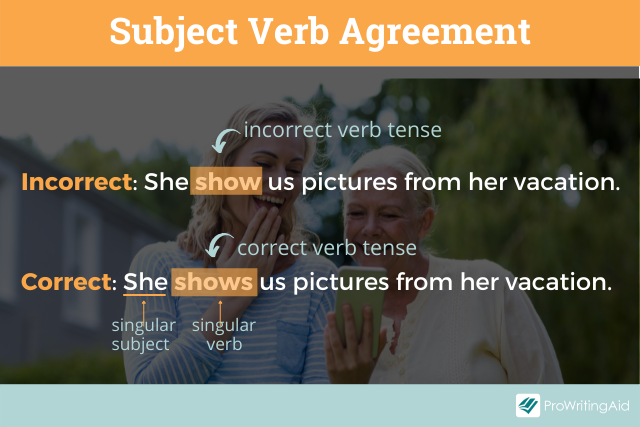
You can think of it like a matching game. Always use plural verb forms when your subjects are plural nouns. When the subject and the verb match, they agree . When they don’t agree, it doesn’t look or sound right to the reader.
When we conjugate verbs in English, we almost always write the third-person singular present tense form differently from other forms. With certain irregular verbs , such as be , we write all the present tense forms differently from each other.
Let’s take a look at a few examples.
- Incorrect: We runs a half-marathon every November.
- Correct: We run a half-marathon every November.
- Incorrect: She show us pictures from her vacation.
- Correct: She shows us pictures from her vacation.
Things get trickier with the verb be . First person , second person , and third person singular are all written differently.
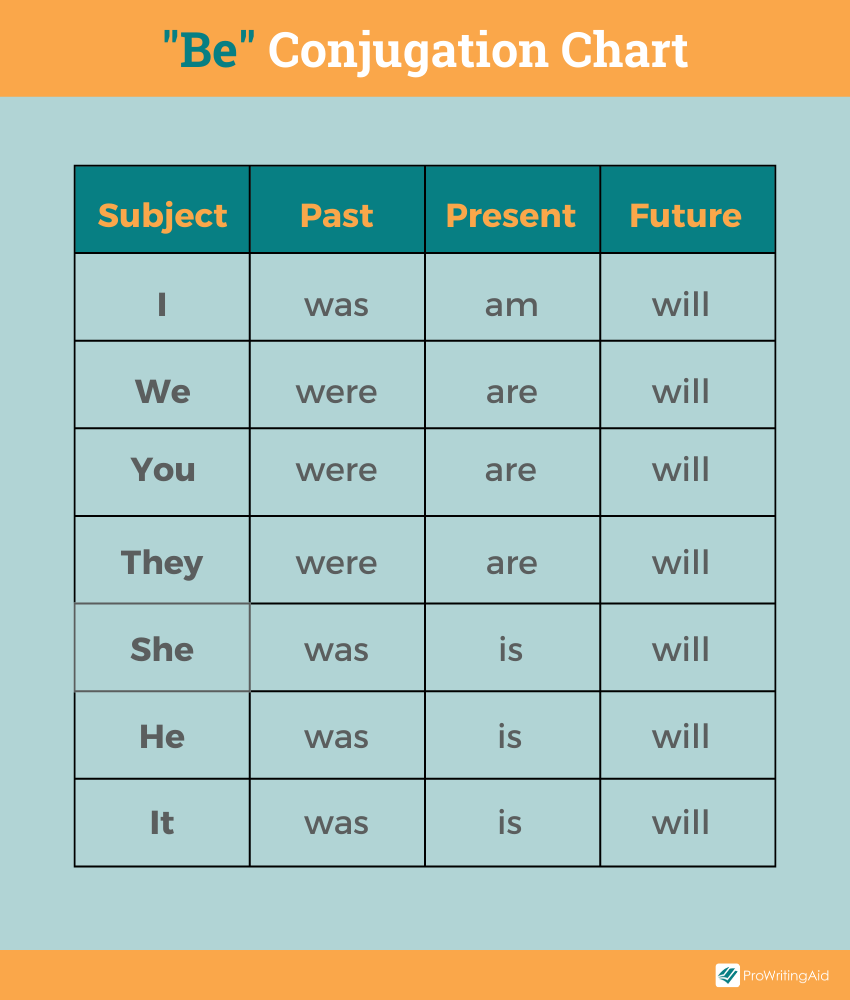
Here are some examples.
- Incorrect: I is going to the store.
- Correct: I am going to the store.
- Incorrect: You is my best friend.
- Correct: You are my best friend.
- Incorrect: She are a customer service representative.
- Correct: She is a customer service representative.
It’s easy to fix your subject–verb agreement issues. Read your sentences aloud to listen for mistakes. Agreement issues usually sound “wrong” when read out loud. ProWritingAid is also a quick, easy way to check for subject–verb agreement.
Subjects and verbs aren’t the only things that need to agree in English! Another bad grammar mistake is mixing up pronouns and antecedents .
An antecedent is the noun that a pronoun refers to. Pronoun–antecedent agreement includes matching gender and number or amount of items.
Here’s a simple example:
- Incorrect: President Biden delivered her speech from the Rotunda.
- Correct: President Biden delivered his speech from the Rotunda.
In this situation, President Biden is one male, so we use the pronoun "his."
Things get trickier with indefinite pronouns, compound subjects, and collective nouns.
Here is an example of each:
- Incorrect (indefinite pronoun): Each teacher went to their room.
- Correct (indefinite pronouns): Each teacher went to his or her room.
- Incorrect (compound subject): Kim and Khloe visited her family.
- Correct (compound subject): Kim and Khloe visited their family.
- Incorrect (collective noun): The team lost to their opponent.
- Correct (collective noun): The team lost to its opponent.
The rules vary from type of pronoun and individual situation. If you aren’t sure, use a grammar checker or look up the rule to avoid making this bad grammar mistake.
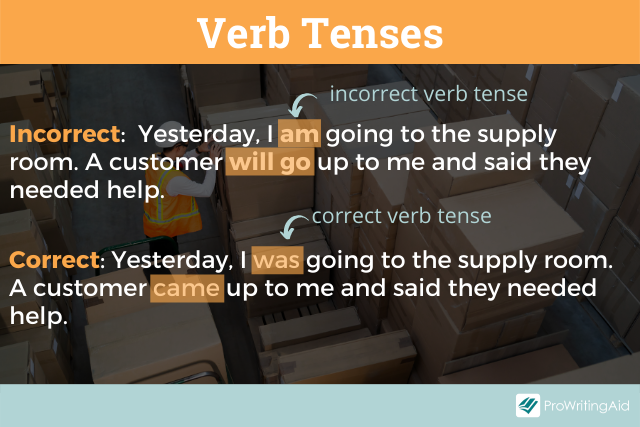
Mixing up verb tenses and moods is another common grammatical error people make. Verbs come in several tenses and moods. Make sure you’re using the correct one for what you’re talking about.
First, you must decide if you’re talking about the past, present, or future. Then you’ll need to determine if you’re talking about an ongoing action or a one-time event. This will help you determine which verb form to use.
Let’s say you’re emailing your boss about an incident that happened at work. You need to write in one of the past tense forms.
- Incorrect: Yesterday, I am going to the supply room. A customer will go up to me and said they needed help.
That incorrect example used the present continuous tense, the future tense, and the simple past tense to describe something that happened in the past. Here’s what it should look like.
- Correct: Yesterday, I was going to the supply room. A customer came up to me and said they needed help.
Now we have the past continuous and simple past tenses. These are correct for describing an event that occurred the day before.
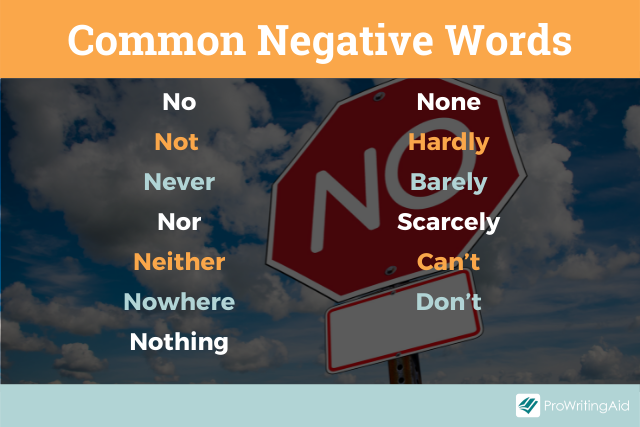
In the English language, using two negative words is a grammar error. We call these double negatives . You should only use one negative word in a phrase to show negation.
The most common negative words are no and not . There are also words that use no as a root word, like nothing , none , nor, and nowhere . But there are other negative words in English, too, such as neither , hardly , barely , never , or scarcely . Be aware of any negatives that are hiding in contractions, like don’t or can’t .
The only exception is that neither and nor are used together when talking about two things (e.g. neither here nor there).
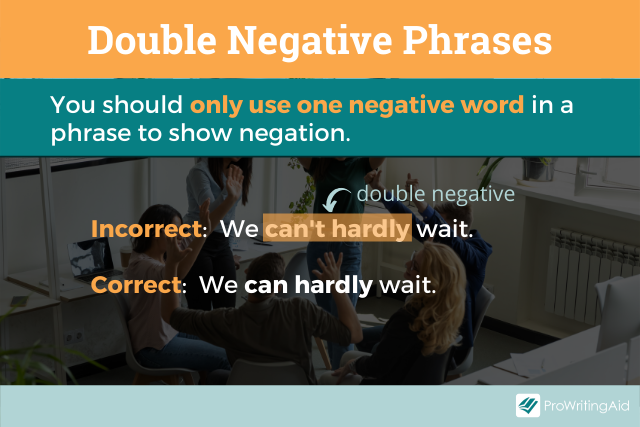
Here are a few examples of how to use negative words correctly.
- Incorrect: I can’t get no satisfaction
- Correct: I can get no satisfaction. OR I can’t get any satisfaction.
- Incorrect: He’s not going nowhere .
- Correct: He’s going nowhere . OR He’s not going anywhere.
- Incorrect: We can’t hardly wait.
- Correct: We can hardly wait.
In some informal situations or among certain cultures, double negatives are acceptable. However, in standard formal English, using double negatives is considered bad grammar.
Another example of bad grammar is misusing modifiers. There are two ways that modifiers can be used wrongly: when they are dangling or misplaced.
What’s a modifier? It’s an optional word or phrase that modifies another element in a sentence. You should always place a modifier as close to the element it’s modifying as possible. Otherwise, you might leave your reader scratching their heads.
A dangling modifier is a modifier that references nothing in the sentence. It’s as if the element it’s supposed to modify was forgotten, so the sentence is unclear.

- Incorrect: While jogging at the park, two squirrels fought over an acorn.
The squirrels weren’t jogging at the park, but the sentence doesn’t mention who was jogging!
Here’s how to fix it.
- Correct: While jogging at the park, I saw two squirrels fight over an acorn.
A misplaced modifier is a little different. The element that needs to be modified is present, but the modifier appears to modify something else.
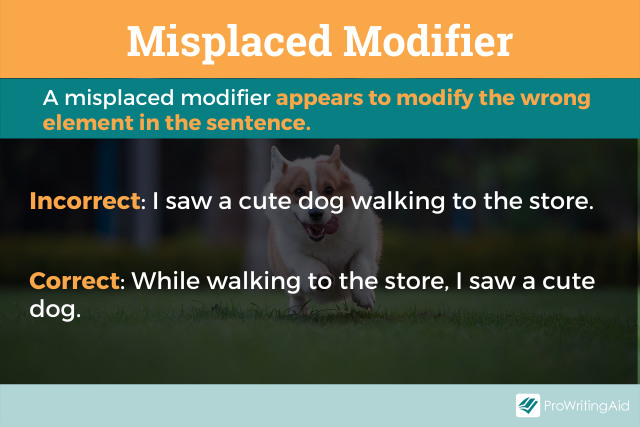
- Incorrect: I saw a cute dog walking to the store.
Is the cute dog walking to the store? Probably not. There are a few ways you can fix this sentence to make the modifier clearer.
- Correct: While walking to the store, I saw a cute dog.
- Correct: I saw a cute dog while walking to the store.
- Correct: I saw a cute dog when I was walking to the store.
A squinting modifier is a type of misplaced modifier that might refer to the word or words before or after the modifier. It makes you squint at the sentence to figure out what is being modified.
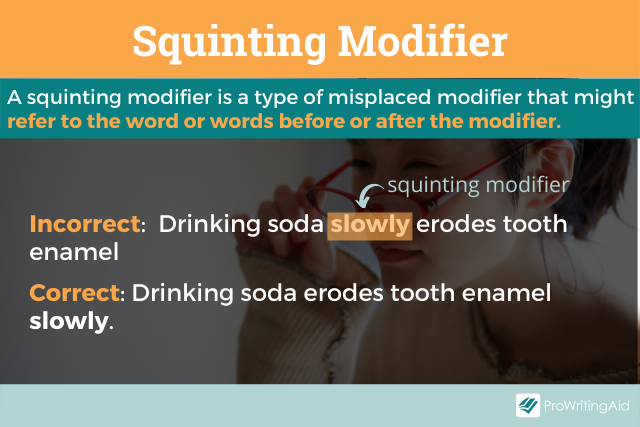
Here’s an example.
- Incorrect: Drinking soda slowly erodes tooth enamel.
It’s not clear whether the adverb “slowly” refers to drinking soda or erodes. If you drink your soda quickly, will your tooth enamel still erode? Here’s how we can fix this squinting modifier.
- Correct: Drinking soda erodes tooth enamel slowly.
Even though we moved the modifier “slowly” further from “erodes,” it’s much clearer than before.
Spelling errors can fall under the bad grammar umbrella, especially when you confuse homophones. Homophones are words that sound the same but are spelled differently.
It’s important to use the correct word in your writing, but homophones make this tricky. There are a few common homophones that people mix up often.
Here are a few of them.
- your/you’re
- there/their/they’re
- which/witch
- affect/effect
When you’re using any of these words, always double check your meaning. If you don’t have the time to do this, ProWritingAid’s Homonym Report can help catch these sneaky words and keep your writing clear of errors.
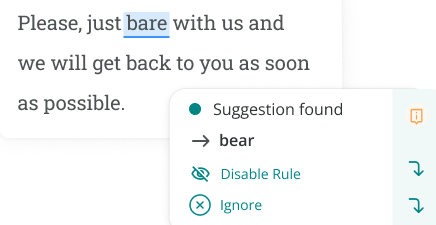
Keep your writing error-free with a free ProWritingAid account.
Often, bad grammar is synonymous with bad sentence structure. There are two main ways that you can write a sentence that has bad grammar. We’ll talk about each of these ways in more detail.
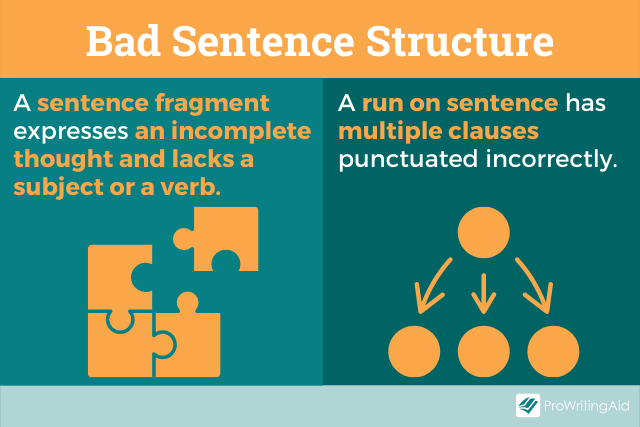
First, there are sentence fragments . A sentence must make complete sense by itself. This means that a sentence needs, at the very least, a subject, a verb, and a complete thought. Without these, the phrase is a sentence fragment.
- Incorrect: Went to the store.
- Correct: He went to the store.
- Incorrect: A pretty girl named Susan.
- Correct: A pretty girl named Susan sits behind me in class.
There are situations where we use sentence fragments, especially in speech, but they are not appropriate for formal writing.
The second way to have poor sentence structure is with run-on sentences . Run-on sentences are sentences with multiple clauses that are not punctuated correctly with commas or other punctuation marks.
- Incorrect: He went to the store he needed to buy groceries because he was out of food but then he decided to also buy some cleaning supplies which he needed to clean the kitchen.
There are several ways you could rewrite this run-on sentence correctly .
Here’s one way:
- Correct: He went to the store; he needed to buy groceries because he was out food. Then he decided to also buy some cleaning supplies, which he needed to clean the kitchen.
Those punctuation marks are important to make the sentences easy to comprehend.
Our next type of grammar mistake has to do with punctuation errors. We already talked about how run-on sentences don't use punctuation correctly. But what about regular sentences?
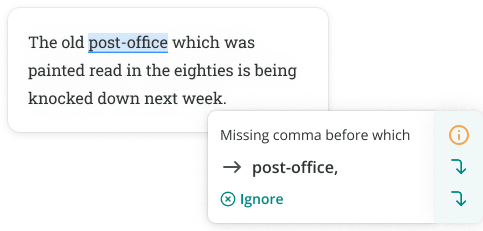
First, it’s important to always use the correct end mark. A period is used for declarative sentences , question marks are used for questions, and exclamation points are used for exclamatory statements.
Here’s an example:
- Incorrect: Do you know Bob.
- Correct: Do you know Bob?
Other punctuation errors might include forgetting to use quotation marks for quotes, using extra dots in an ellipsis, or mixing up hyphens and dashes .
Wordiness is another bad grammar mistake. Even if a sentence follows all the mechanics of grammar, it can be too verbose and use complicated words. An unnecessarily wordy sentence is often called an inflated sentence . Most of the time, simpler is better.
- Incorrect: When you arrive at your domicile from your place of work, please prepare fresh cuisine for the late evening meal, which is necessary for sustenance.
- Correct: When you get home from work, please make dinner.
A tautology is a specific type of wordiness. It means to express the same idea twice. Tautologies make sentences redundant. While they can be useful in creative writing for emphasis when used sparingly, they add unneeded words in most types of writing.
- Incorrect: My heart beat erratically in my chest .
- Correct: My heart beat erratically.
Your heart always beats in your chest, so that phrase is unnecessary.
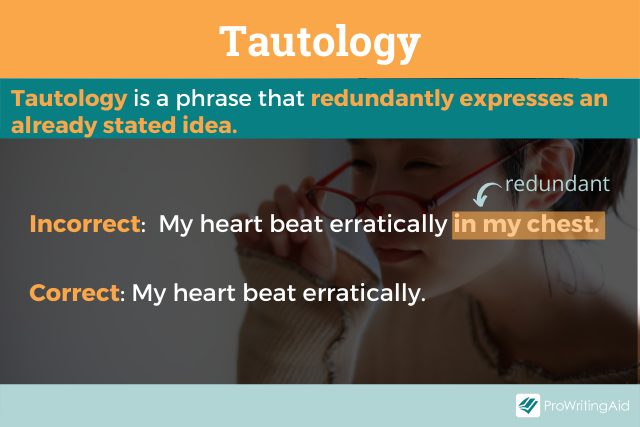
Our final grammar error is mixing up pronouns. In English, we have subject pronouns, object pronouns, possessive adjectives, possessive pronouns, and reflexive pronouns. Mixing up these pronouns is a bad grammar mistake you want to avoid.
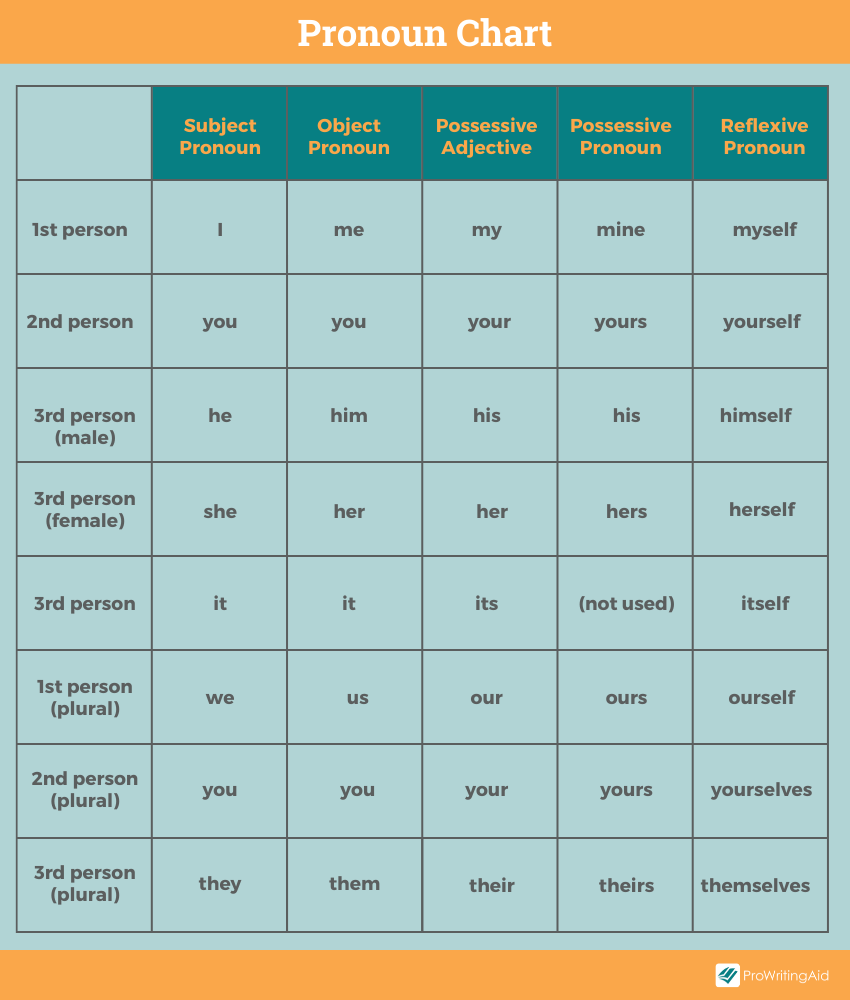
- Incorrect: My mother and me went to the zoo.
- Correct: My mother and I went to the zoo.
- Incorrect: This is a photo of she and I .
- Correct: This is a photo of her and me .
The pronouns they/them/their/theirs sometimes act as singular pronouns, and they have been since at least the fourteenth century. However, you should still use the third-person plural verb forms when you use the singular “they.”
Pay attention to whether you are discussing the subject or the object of a sentence to determine which pronoun to use.
Even the best writers make mistakes! And there are so many grammatical rules to keep track of. With a quick proofread, you can avoid making these grammatical errors and others in your own writing.
Take your writing to the next level:

20 Editing Tips from Professional Writers
Whether you are writing a novel, essay, article, or email, good writing is an essential part of communicating your ideas., this guide contains the 20 most important writing tips and techniques from a wide range of professional writers..

Be confident about grammar
Check every email, essay, or story for grammar mistakes. Fix them before you press send.
Krystal N. Craiker is the Writing Pirate, an indie romance author and blog manager at ProWritingAid. She sails the seven internet seas, breaking tropes and bending genres. She has a background in anthropology and education, which brings fresh perspectives to her romance novels. When she’s not daydreaming about her next book or article, you can find her cooking gourmet gluten-free cuisine, laughing at memes, and playing board games. Krystal lives in Dallas, Texas with her husband, child, and basset hound.
Get started with ProWritingAid
Drop us a line or let's stay in touch via :
Tutorials, Study Guides & More
Bad writing
This is a short rogues’ gallery of bad practice. It is short because we don’t want to dwell on negative examples, but it exists to offer a few warnings and to explain how problems are often caused. Most of the items have been mentioned elsewhere in advice on what to avoid, or cautions of one kind or another. I think they are worth second mention in a different context.
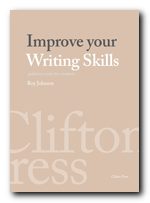
Using speech patterns
Poor punctuation
- Weak grammar and syntax
- Sentences too long
- Unrelated clauses
Jumbled vocabulary
- Straining to impress
- Mired in cliché
When we speak to each other, we don’t use grammatically complete sentences, careful constructions, and beautifully modulated syntax. Our utterances are often quite ungrammatical, abbreviated, and incomplete. We might say ‘She wasn’t there at home, it’ll be later when I’m going to call’. This would be acceptable in speech. But we would write ‘She was not at home, so I will call again later’.
If these habits of speech are carried over into the written language the results are usually not very good. Remember that on the page we do not have any of the other parts of spoken communication to guide us. Tone of voice, accent, stress, and facial expression are absent. The two forms of communication may both use words as their basic element, but they are two different ‘codes’.
If you wish to be understood, and if you wish to make a good impression in the written language, then you should stay fairly close to what is called ‘Standard English’. For most forms of writing, if you want to move away from this norm, you should know what it is you are doing, and you should have a good reason for doing so.
It might be acceptable to use dialects and the irregularities of the spoken language if you were writing fiction or trying to illustrate someone’s character. In almost all types of formal writing however, your best plan is to stay close to the norm – if only because you will thereby communicate with the largest number of people. This is not to be proscriptive or fuddy-duddy. If you have the confidence and the skill, you can use whatever linguistic devices you wish – but then you would probably not be reading this book.
Some people scatter marks of punctuation like confetti throughout their writing, making little distinction between the range of devices available. Yet if it is not used accurately and consistently, this creates an unsettling effect. The sense of a statement can be rendered ambiguous or obscure. Reading can become like hacking your way through a linguistic jungle. Remember that commas, semicolons, and colons are used to create pauses of different length in the grammar and the sense of a statement (see Punctuation ).
Another common form of poor punctuation occurs when one punctuation mark is substituted for another. The most frequent abuse of this kind is the use of the comma to string together statements which are in fact grammatically separate. They might be independent sentences, or (more usually) notes or brief ‘thoughts’.
‘The senator’s reaction was only outrage that a man’s career should be threatened, it was her word against his, they chose to believe his.’
These are separate statements, and should be treated as such. The first comma here should be a full stop (followed by a capital letter) and the second a colon.
The other extreme of the same problem is too little punctuation. This usually has the effect of leaving readers disoriented. We are not sure where one clause ends and the next begins. Unless there is great pressure to continue, we rapidly tire of trying to make sense of writing which has no stress or grammatical indicators. Let’s look at an example used elsewhere. It isn’t a particularly long sentence, but the absence of any punctuation makes it very difficult to understand at first reading.
‘Each night you stay at a Roberts-Plaza Moat Houses UK hotel at the fully published or corporate rate you are entitled to a special discount voucher.’
This usually occurs either because the writer doesn’t have a firm grasp of the meaning and best use of words – or because there is a ‘straining for effect’ which goes wrong. Sometimes the two features may be combined. A local council circular [in what we might call ‘Town Hall prose’] offers the following example of the first weakness:
Manchester has a strong objective to be widely recognized as a fully accessible city, and energetically supports the overall approach of the Action Programme.
The council might have a ‘strong ambition’; it might have these goals as its objective; but it cannot have a ‘strong objective’, because the term ‘objective’ is an abstract noun which cannot be qualified by ‘strong’.
The over-long sentence
Long sentences should generally be avoided – unless you have very good control of grammar and syntax. This is a very common problem for beginners. Some people start out on their subject, add qualifying clauses, explanations, or digressions of some kind, then seem to forget where they have come from. Their sentences drift grammatically and usually become difficult to understand.
If we contrast the past situation where although a doctor may not have been able to cure a patient, he would have visited the patient regularly giving emotional support; with a situation that might occur today, such as the impersonal treatment of a patient using highly sophisticated technology, it could be argued that this transition has produced a less humane or compassionate system.
The following is a more subtle example of the same phenomenon. The sentence isn’t quite so disastrous, but it should be much easier to understand. The weaknesses are caused by its length, but also by its poor grammar and confusing repetitions. [We are back in Manchester Town Hall.]
The Programme is of vital importance, and would assist in creating a significant improvement in the quality of life of disabled people of all ages, not least as access to transport is a key requirement in education and employment, as well as for social, leisure, health, shopping and other activities.
It starts with the active verb is then switches to the conditional ‘would’; the three ‘of’s in quick succession are clumsy; and ‘not least as’ [which should be ‘because’] is not properly paralleled in ‘as well as’. Like most of the examples we have looked at, it would be improved if it were split into two separate sentences.
Pretentiousness
Some people use writing as a vehicle to ‘impress’ others. Rather than make direct statements they use elaborate constructions and wordy phrases in an attempt to appear very literary or clever. These attempts rarely succeed because writing does reveal its author’s ‘style’. An insincere purpose will show through – as the following example should illustrate.
One would hesitate, however, to sip from the same poisoned chalice as those who would speciously crusade the assertion that literature is quintessentially socially functional. Pose the following interrogative: Would Dante, Shakespeare, or Milton, from their peerless pinnacles, have sullied their art, prostituted the muse which their endeavours had enthroned, by indicating something as trivial, as unworthy, as a social purpose? The art of such as these argues another view; that at the heart of all great creative achievement lies a self-justifying, eternally fathomless and sacred mystery.
Let’s finish with a stunning example from the world of provincial journalism. In his book on Newspaper Style , Keith Waterhouse points out that many tabloid journalists inhabit a linguistic world so steeped in cliché that their writing has the appearance of being constructed from ready-made parts. The following is an extract from a genuine theatre review (with the clichés highlighted) but the names have been changed to protect the innocent. [That’s a deliberate example!]
By their very nature cabarets tend to be a bit of a hit and miss affair . And Manchester’s own Downtown Cabaret is ample proof of that. When it was good it was good and when it was bad it was awful. Holding this curate’s egg together was John Keswick acting as compere and keeping the hotch-potch of sketches and songs running along smoothly . And his professionalism shone through as he kept his hand on the tiller and steered the show through a difficult audience with his own brand of witticism. Local playwright Alan Chivers had previously worked like a Trojan and managed to marshall the talents of a bevy of Manchester’s rising stars .
What then are the cures for bad writing? There are essentially two solutions. One is simply to take more care, and subject what you write to detailed scrutiny. If you are in any doubt at all about something you have written, be prepared to change it. If the meaning is ambiguous or cloudy to you, it will almost certainly be so to somebody else. You might ask a tolerant friend to read over what you have written. Check that it makes sense. The other solution is to make yourself more aware of the language and rhythms of good writing. Read the work of those who are known to write well. Absorb the syntax, the cadences, and the texture of good prose.
Chapter continues …
© Mantex/Clifton Press 1995-2011
[eshop_show_product id=’7968′ form=’yes’]
Get in touch
- Advertising
- T & C’s
- Testimonials
Have a language expert improve your writing
Run a free plagiarism check in 10 minutes, generate accurate citations for free.
- Knowledge Base
- Example of a great essay | Explanations, tips & tricks
Example of a Great Essay | Explanations, Tips & Tricks
Published on February 9, 2015 by Shane Bryson . Revised on July 23, 2023 by Shona McCombes.
This example guides you through the structure of an essay. It shows how to build an effective introduction , focused paragraphs , clear transitions between ideas, and a strong conclusion .
Each paragraph addresses a single central point, introduced by a topic sentence , and each point is directly related to the thesis statement .
As you read, hover over the highlighted parts to learn what they do and why they work.
Instantly correct all language mistakes in your text
Upload your document to correct all your mistakes in minutes

Table of contents
Other interesting articles, frequently asked questions about writing an essay, an appeal to the senses: the development of the braille system in nineteenth-century france.
The invention of Braille was a major turning point in the history of disability. The writing system of raised dots used by visually impaired people was developed by Louis Braille in nineteenth-century France. In a society that did not value disabled people in general, blindness was particularly stigmatized, and lack of access to reading and writing was a significant barrier to social participation. The idea of tactile reading was not entirely new, but existing methods based on sighted systems were difficult to learn and use. As the first writing system designed for blind people’s needs, Braille was a groundbreaking new accessibility tool. It not only provided practical benefits, but also helped change the cultural status of blindness. This essay begins by discussing the situation of blind people in nineteenth-century Europe. It then describes the invention of Braille and the gradual process of its acceptance within blind education. Subsequently, it explores the wide-ranging effects of this invention on blind people’s social and cultural lives.
Lack of access to reading and writing put blind people at a serious disadvantage in nineteenth-century society. Text was one of the primary methods through which people engaged with culture, communicated with others, and accessed information; without a well-developed reading system that did not rely on sight, blind people were excluded from social participation (Weygand, 2009). While disabled people in general suffered from discrimination, blindness was widely viewed as the worst disability, and it was commonly believed that blind people were incapable of pursuing a profession or improving themselves through culture (Weygand, 2009). This demonstrates the importance of reading and writing to social status at the time: without access to text, it was considered impossible to fully participate in society. Blind people were excluded from the sighted world, but also entirely dependent on sighted people for information and education.
In France, debates about how to deal with disability led to the adoption of different strategies over time. While people with temporary difficulties were able to access public welfare, the most common response to people with long-term disabilities, such as hearing or vision loss, was to group them together in institutions (Tombs, 1996). At first, a joint institute for the blind and deaf was created, and although the partnership was motivated more by financial considerations than by the well-being of the residents, the institute aimed to help people develop skills valuable to society (Weygand, 2009). Eventually blind institutions were separated from deaf institutions, and the focus shifted towards education of the blind, as was the case for the Royal Institute for Blind Youth, which Louis Braille attended (Jimenez et al, 2009). The growing acknowledgement of the uniqueness of different disabilities led to more targeted education strategies, fostering an environment in which the benefits of a specifically blind education could be more widely recognized.
Several different systems of tactile reading can be seen as forerunners to the method Louis Braille developed, but these systems were all developed based on the sighted system. The Royal Institute for Blind Youth in Paris taught the students to read embossed roman letters, a method created by the school’s founder, Valentin Hauy (Jimenez et al., 2009). Reading this way proved to be a rather arduous task, as the letters were difficult to distinguish by touch. The embossed letter method was based on the reading system of sighted people, with minimal adaptation for those with vision loss. As a result, this method did not gain significant success among blind students.
Louis Braille was bound to be influenced by his school’s founder, but the most influential pre-Braille tactile reading system was Charles Barbier’s night writing. A soldier in Napoleon’s army, Barbier developed a system in 1819 that used 12 dots with a five line musical staff (Kersten, 1997). His intention was to develop a system that would allow the military to communicate at night without the need for light (Herron, 2009). The code developed by Barbier was phonetic (Jimenez et al., 2009); in other words, the code was designed for sighted people and was based on the sounds of words, not on an actual alphabet. Barbier discovered that variants of raised dots within a square were the easiest method of reading by touch (Jimenez et al., 2009). This system proved effective for the transmission of short messages between military personnel, but the symbols were too large for the fingertip, greatly reducing the speed at which a message could be read (Herron, 2009). For this reason, it was unsuitable for daily use and was not widely adopted in the blind community.
Nevertheless, Barbier’s military dot system was more efficient than Hauy’s embossed letters, and it provided the framework within which Louis Braille developed his method. Barbier’s system, with its dashes and dots, could form over 4000 combinations (Jimenez et al., 2009). Compared to the 26 letters of the Latin alphabet, this was an absurdly high number. Braille kept the raised dot form, but developed a more manageable system that would reflect the sighted alphabet. He replaced Barbier’s dashes and dots with just six dots in a rectangular configuration (Jimenez et al., 2009). The result was that the blind population in France had a tactile reading system using dots (like Barbier’s) that was based on the structure of the sighted alphabet (like Hauy’s); crucially, this system was the first developed specifically for the purposes of the blind.
While the Braille system gained immediate popularity with the blind students at the Institute in Paris, it had to gain acceptance among the sighted before its adoption throughout France. This support was necessary because sighted teachers and leaders had ultimate control over the propagation of Braille resources. Many of the teachers at the Royal Institute for Blind Youth resisted learning Braille’s system because they found the tactile method of reading difficult to learn (Bullock & Galst, 2009). This resistance was symptomatic of the prevalent attitude that the blind population had to adapt to the sighted world rather than develop their own tools and methods. Over time, however, with the increasing impetus to make social contribution possible for all, teachers began to appreciate the usefulness of Braille’s system (Bullock & Galst, 2009), realizing that access to reading could help improve the productivity and integration of people with vision loss. It took approximately 30 years, but the French government eventually approved the Braille system, and it was established throughout the country (Bullock & Galst, 2009).
Although Blind people remained marginalized throughout the nineteenth century, the Braille system granted them growing opportunities for social participation. Most obviously, Braille allowed people with vision loss to read the same alphabet used by sighted people (Bullock & Galst, 2009), allowing them to participate in certain cultural experiences previously unavailable to them. Written works, such as books and poetry, had previously been inaccessible to the blind population without the aid of a reader, limiting their autonomy. As books began to be distributed in Braille, this barrier was reduced, enabling people with vision loss to access information autonomously. The closing of the gap between the abilities of blind and the sighted contributed to a gradual shift in blind people’s status, lessening the cultural perception of the blind as essentially different and facilitating greater social integration.
The Braille system also had important cultural effects beyond the sphere of written culture. Its invention later led to the development of a music notation system for the blind, although Louis Braille did not develop this system himself (Jimenez, et al., 2009). This development helped remove a cultural obstacle that had been introduced by the popularization of written musical notation in the early 1500s. While music had previously been an arena in which the blind could participate on equal footing, the transition from memory-based performance to notation-based performance meant that blind musicians were no longer able to compete with sighted musicians (Kersten, 1997). As a result, a tactile musical notation system became necessary for professional equality between blind and sighted musicians (Kersten, 1997).
Braille paved the way for dramatic cultural changes in the way blind people were treated and the opportunities available to them. Louis Braille’s innovation was to reimagine existing reading systems from a blind perspective, and the success of this invention required sighted teachers to adapt to their students’ reality instead of the other way around. In this sense, Braille helped drive broader social changes in the status of blindness. New accessibility tools provide practical advantages to those who need them, but they can also change the perspectives and attitudes of those who do not.
Bullock, J. D., & Galst, J. M. (2009). The Story of Louis Braille. Archives of Ophthalmology , 127(11), 1532. https://doi.org/10.1001/archophthalmol.2009.286.
Herron, M. (2009, May 6). Blind visionary. Retrieved from https://eandt.theiet.org/content/articles/2009/05/blind-visionary/.
Jiménez, J., Olea, J., Torres, J., Alonso, I., Harder, D., & Fischer, K. (2009). Biography of Louis Braille and Invention of the Braille Alphabet. Survey of Ophthalmology , 54(1), 142–149. https://doi.org/10.1016/j.survophthal.2008.10.006.
Kersten, F.G. (1997). The history and development of Braille music methodology. The Bulletin of Historical Research in Music Education , 18(2). Retrieved from https://www.jstor.org/stable/40214926.
Mellor, C.M. (2006). Louis Braille: A touch of genius . Boston: National Braille Press.
Tombs, R. (1996). France: 1814-1914 . London: Pearson Education Ltd.
Weygand, Z. (2009). The blind in French society from the Middle Ages to the century of Louis Braille . Stanford: Stanford University Press.
If you want to know more about AI tools , college essays , or fallacies make sure to check out some of our other articles with explanations and examples or go directly to our tools!
- Ad hominem fallacy
- Post hoc fallacy
- Appeal to authority fallacy
- False cause fallacy
- Sunk cost fallacy
College essays
- Choosing Essay Topic
- Write a College Essay
- Write a Diversity Essay
- College Essay Format & Structure
- Comparing and Contrasting in an Essay
(AI) Tools
- Grammar Checker
- Paraphrasing Tool
- Text Summarizer
- AI Detector
- Plagiarism Checker
- Citation Generator
Prevent plagiarism. Run a free check.
An essay is a focused piece of writing that explains, argues, describes, or narrates.
In high school, you may have to write many different types of essays to develop your writing skills.
Academic essays at college level are usually argumentative : you develop a clear thesis about your topic and make a case for your position using evidence, analysis and interpretation.
The structure of an essay is divided into an introduction that presents your topic and thesis statement , a body containing your in-depth analysis and arguments, and a conclusion wrapping up your ideas.
The structure of the body is flexible, but you should always spend some time thinking about how you can organize your essay to best serve your ideas.
Your essay introduction should include three main things, in this order:
- An opening hook to catch the reader’s attention.
- Relevant background information that the reader needs to know.
- A thesis statement that presents your main point or argument.
The length of each part depends on the length and complexity of your essay .
A thesis statement is a sentence that sums up the central point of your paper or essay . Everything else you write should relate to this key idea.
A topic sentence is a sentence that expresses the main point of a paragraph . Everything else in the paragraph should relate to the topic sentence.
At college level, you must properly cite your sources in all essays , research papers , and other academic texts (except exams and in-class exercises).
Add a citation whenever you quote , paraphrase , or summarize information or ideas from a source. You should also give full source details in a bibliography or reference list at the end of your text.
The exact format of your citations depends on which citation style you are instructed to use. The most common styles are APA , MLA , and Chicago .
Cite this Scribbr article
If you want to cite this source, you can copy and paste the citation or click the “Cite this Scribbr article” button to automatically add the citation to our free Citation Generator.
Bryson, S. (2023, July 23). Example of a Great Essay | Explanations, Tips & Tricks. Scribbr. Retrieved April 2, 2024, from https://www.scribbr.com/academic-essay/example-essay-structure/
Is this article helpful?
Shane Bryson
Shane finished his master's degree in English literature in 2013 and has been working as a writing tutor and editor since 2009. He began proofreading and editing essays with Scribbr in early summer, 2014.
Other students also liked
How to write an essay introduction | 4 steps & examples, academic paragraph structure | step-by-step guide & examples, how to write topic sentences | 4 steps, examples & purpose, unlimited academic ai-proofreading.
✔ Document error-free in 5minutes ✔ Unlimited document corrections ✔ Specialized in correcting academic texts
Calculate for all schools
Your chance of acceptance, your chancing factors, extracurriculars, what makes a college essay bad.
Hey everyone, I'm starting to work on my college essays, and I want to make sure I avoid any common pitfalls. In your opinion, what are some characteristics of a bad college essay? Are there any clichés or mistakes I should definitely avoid?
Hello! It's great that you're looking to avoid common essay pitfalls. A bad college essay can suffer from several issues:
1. Poor grammar and punctuation: Proofread, proofread, proofread! No matter how great your story is, if it's plagued with grammar and punctuation errors, it gives the impression that you didn't put in the effort. Ask others to review your essay and use tools like Grammarly to catch any errors you might have missed.
2. Generic or cliché topics: Some cliché essay topics include sports injuries or victories, immigrant stories, moving schools, and overcoming a challenging class. Writing about these topics can make your essay feel less unique and memorable. Keep in mind, though, that you can still write about these topics as long as you bring a fresh perspective or unique personal experience.
3. Lack of focus or depth: A good college essay showcases your personal growth, qualities, and thinking ability. Avoid trying to cover too many ideas or events, as this could result in a superficial essay. Instead, focus on one or two experiences and show how they have shaped you.
4. Negativity or complaining: While it's okay to acknowledge challenges you've faced, it's important to show resilience, persistence, or growth instead of simply complaining about your problems.
5. Failing to answer the prompt: Make sure you thoroughly address the essay prompt provided. If you don't answer the question being asked, your essay won't be helpful in showcasing your fit for the college or program.
6. Overusing quotes or big words: While it might be tempting to show off your vocabulary or include a favorite quote, it can detract from your voice and message. Focus on your own words and experiences, using advanced vocabulary and quotes sparingly.
7. Too much telling, not enough showing: "Show, don't tell" is a critical concept in good essay writing. Provide specific examples and anecdotes to illustrate your points, instead of simply claiming or listing attributes. This helps readers connect with you and makes your essay more engaging.
8. Not being authentic: Let your true self shine through your essay. Admissions officers can usually tell when you're writing what you think they want to hear, rather than writing honestly about your experiences and thoughts.
By being aware of these common issues, you'll be well on your way to writing a strong college essay that showcases your story and personality. Good luck!
About CollegeVine’s Expert FAQ
CollegeVine’s Q&A seeks to offer informed perspectives on commonly asked admissions questions. Every answer is refined and validated by our team of admissions experts to ensure it resonates with trusted knowledge in the field.

Essay Writing

Writing an essay isn’t exactly the most entertaining thing to do with your time. Correct grammar, punctuation, and spelling are essential writing skills to be observed in order to create a good essay. Some may even consider this a dreadful task to be done, spending hours on end just to form something worth reading.
Although for others, it’s easy as pie. They see it as a hobby or a career path, taking on part-time jobs in freelance writing . However, the ability to write good and effective essays isn’t a skill you are born with. It is commonly developed through experience and constant practice.
What is Essay Writing? Essay writing is the process of creating a structured piece of writing that presents ideas, arguments, or reflections on a specific topic. It’s a common form of academic assignment, often used in schools and universities to assess a student’s understanding and expression of various subjects. Essay writing helps students develop critical thinking and writing skills, enabling them to articulate their thoughts and ideas clearly and logically.
Structure/Format of Essay Writing
An essay typically starts with an introduction that introduces the topic and states the main point or thesis. The body, consisting of several paragraphs, each focuses on a specific idea or argument supporting the thesis, with evidence or examples. The essay concludes with a summary that reiterates the main points and restates the thesis, leaving the reader with a final thought. This structure helps organize ideas clearly and logically, making the essay easy to follow and understand.
Introduction
An introduction in essay writing serves as the opening paragraph that introduces the topic, provides context, and outlines the essay’s purpose, setting the stage for the main arguments and thesis statement.
Purpose: Introduces the topic, sets the tone, and presents the thesis statement. Key Elements: Engaging opening sentence, background information, thesis statement.
Body Paragraphs
A body paragraph is a section that presents a single main idea, supports it with evidence, and elaborates on it to strengthen the essay’s argument and structure.
Purpose: To develop and support the thesis statement. Structure: Each paragraph should focus on a single main idea or argument. Key Elements: Topic Sentence, Supporting Details and Analysis
A conclusion in essay writing summarizes key points, restates the thesis, and provides a final perspective, leaving a lasting impression.
Purpose: Summarizes the essay and reinforces the thesis statement. Key Elements: Summary of Main Points, Restatement of Thesis and Final Thoughts
Essay Writing Topics, Ideas with Samples
1. the impact of technology on society.
Introduction: Technology has become an integral part of our daily lives, revolutionizing the way we communicate, work, and live. This essay explores the profound impact of technology on society, delving into both the positive advancements and the challenges it presents. Body: 1. Advancements in Communication: Technology has transformed communication, breaking down geographical barriers and connecting people across the globe. Social media platforms, messaging apps, and video conferencing have revolutionized how we interact, fostering global communities and enabling instant information exchange. 2. Economic Transformation: The rise of the internet and e-commerce has reshaped the business landscape. Online marketplaces, digital payment systems, and automation have streamlined transactions and enhanced efficiency. However, the digital divide remains a concern, with disparities in access and opportunities between different socioeconomic groups. 3. Education and Learning: Technology has revolutionized education, providing access to a vast array of information and online courses. E-learning platforms offer flexible learning opportunities, making education more accessible to diverse learners. However, challenges such as information overload and the need for digital literacy skills persist. 4. Healthcare Innovations: Technological advancements in healthcare have led to improved diagnostics, treatment options, and patient care. Telemedicine facilitates remote consultations, enhancing healthcare accessibility. Artificial intelligence and data analytics have revolutionized medical research and personalized medicine, leading to breakthroughs in various fields. 5. Social Impact and Relationships: The pervasive use of technology has raised concerns about its impact on social relationships. While it facilitates connection, there are worries about the erosion of face-to-face interactions and the rise of online addiction. Balancing digital engagement with meaningful, in-person relationships has become a societal challenge. Conclusion: In conclusion, technology’s impact on society is multifaceted, bringing both opportunities and challenges. Embracing the benefits of technological advancements while addressing issues such as digital inequality, privacy concerns, and social disconnection is crucial. Society must navigate these complexities thoughtfully to ensure that technology continues to enhance our lives without compromising fundamental human values and connections.
2. Impact of Climate Change on Our Planet
Introduction Climate change, a critical global issue, has far-reaching impacts on our planet. It refers to significant changes in global temperatures and weather patterns over time. While climate has changed throughout Earth’s history, recent decades have seen unprecedented changes, largely attributed to human activities. This essay explores the impact of climate change on various aspects of our planet, including natural ecosystems, weather patterns, human health, and economic sectors. Impact on Natural Ecosystems One of the most visible impacts of climate change is on natural ecosystems. Rising temperatures and changing precipitation patterns are altering habitats globally. For instance, coral reefs, known as the rainforests of the sea, are experiencing widespread bleaching due to warmer oceans. Similarly, polar regions are facing melting ice, endangering species like polar bears and penguins. Forests are not immune either; increased temperatures and droughts lead to more frequent and intense wildfires, destroying vast areas and biodiversity. Weather Patterns and Extreme Events Climate change has significantly altered weather patterns, leading to more extreme and unpredictable weather events. The frequency and severity of droughts, heatwaves, hurricanes, and floods have increased. For example, hurricanes are becoming more intense due to warmer ocean waters, and rising sea levels are exacerbating coastal flooding. These extreme events not only cause immediate destruction but also long-term economic and social challenges. Human Health Concerns The impact of climate change on human health is increasingly evident. Higher temperatures contribute to heat-related illnesses and deaths. Changes in weather patterns also affect air quality, leading to respiratory issues. Furthermore, the spread of vector-borne diseases, such as malaria and dengue fever, is expected to increase as the climate warms, posing new health risks in regions previously unaffected. Economic and Social Impacts Economically, climate change affects various sectors, including agriculture, fisheries, and tourism. Changes in temperature and precipitation patterns disrupt food production, leading to food insecurity. Fisheries are impacted by ocean acidification and changing marine ecosystems, affecting livelihoods and food supplies. Additionally, tourism in areas like coastal regions and mountain ski resorts faces challenges due to changing climate conditions. Conclusion The impact of climate change on our planet is profound and multifaceted, affecting natural ecosystems, weather patterns, human health, and economic sectors. It is a global challenge that requires immediate and concerted efforts to mitigate and adapt to its effects. Addressing climate change involves reducing greenhouse gas emissions, preserving and restoring ecosystems, and developing sustainable practices. The time to act is now, to protect our planet for future generations.
3. Mental Health Awareness Among Youth
Mental health is a crucial aspect of overall well-being, especially among youth. It’s a pivotal period in life when individuals undergo significant physical, emotional, and social changes. Understanding and addressing mental health issues during these formative years are essential for fostering a healthy and productive society. Identifying Mental Health Issues in Youth Mental health issues can manifest in various ways, such as anxiety, depression, eating disorders, and behavioral problems. Often, these issues are misinterpreted as typical adolescent behavior, leading to a lack of proper intervention. Early identification of mental health issues is key to providing timely support and care. Signs of Mental Health Issues Changes in mood or behavior Withdrawal from social interactions Declining academic performance Changes in sleeping or eating patterns Expressions of hopelessness or worthlessness The Stigma Surrounding Mental Health One of the biggest challenges in addressing mental health among youth is the stigma associated with it. This stigma often leads to reluctance in seeking help and discussing mental health issues openly. Effects of Stigma Hesitation to seek help Lack of understanding from peers and adults Worsening of mental health conditions Creating a Supportive Environment Creating a supportive and understanding environment is vital in encouraging youth to speak about and seek help for their mental health issues. Strategies for Support Educating teachers and parents about mental health Implementing mental health programs in schools Providing access to counseling and psychological services Encouraging peer support groups The Role of Technology and Social Media In today’s digital age, technology and social media play a significant role in youths’ lives, impacting their mental health both positively and negatively. Impact of Digital Media: Social media can lead to issues like cyberbullying and unrealistic body image expectations. Technology can also be a tool for spreading awareness and providing access to resources. Conclusion Mental health awareness among youth is not just a necessity but an imperative for building a resilient, empathetic, and healthy society. Through education, support, and open conversations, we can empower our youth to face life’s challenges with strength and optimism. Creating an environment where mental health is prioritized and discussed openly will pave the way for a more understanding and supportive community, ensuring a brighter future for all.
4. Artificial Intelligence: Boon or Bane?
Introduction: In the realm of technology, artificial intelligence (AI) stands as a monumental innovation, reshaping how we live, work, and interact. But as with any significant technological advancement, AI’s impact on society sparks a crucial debate: Is it a boon or a bane? This essay delves into the multifaceted nature of AI, examining its benefits and challenges, ultimately aiming to provide a balanced perspective. The Boon of AI Enhancement of Efficiency and Productivity AI systems excel in processing vast amounts of data rapidly, significantly outpacing human capabilities. This trait has transformed industries by streamlining operations, from manufacturing with automated robotics to healthcare where AI aids in diagnosis and treatment planning. Innovation in Various Fields AI fosters innovation across diverse sectors. In education, personalized learning algorithms adapt to individual student needs, enhancing the learning experience. In environmental science, AI assists in climate modeling and conservation efforts, contributing to a more sustainable future. Improvement in Quality of Life AI’s impact on daily life is profound. Smart home devices offer convenience and enhanced security, while AI-driven personal assistants, like voice-activated systems, simplify tasks. Moreover, AI’s role in healthcare, from robotic surgeries to predictive diagnostics, has been life-altering for many. The Bane of AI Job Displacement Concerns One of the most significant fears surrounding AI is job displacement. Automation and AI systems could replace human roles, particularly in sectors like manufacturing and customer service, leading to unemployment and economic disparities. Ethical and Privacy Issues AI’s ability to analyze personal data raises privacy concerns. Issues like data misuse and surveillance have prompted debates on ethical guidelines and regulations. Furthermore, AI’s decision-making processes, if not transparent, can lead to ethical dilemmas in areas like law enforcement and lending. Dependency and Reduced Human Skill An over-reliance on AI could lead to a decline in critical human skills. For instance, excessive use of navigational AI may impair our natural sense of direction, and dependence on AI for decision-making could diminish our problem-solving abilities. Conclusion: AI, like any powerful tool, comes with its set of pros and cons. While it offers remarkable advancements and efficiencies, it also presents significant challenges and risks. The key lies in harnessing AI’s potential responsibly, with mindful consideration of ethical implications and a balanced approach to technology integration. By doing so, we can steer AI towards being more of a boon than a bane, ensuring it serves to enhance, rather than dictate, the course of human progress.
5. Sustainable Living and Environmental Conservation
Introduction Sustainable Living and Environmental Conservation are vital concepts in today’s world, as they focus on maintaining the health of our planet for future generations. This essay explores the importance of sustainable living and the various ways in which individuals and communities can contribute to environmental conservation. Understanding Sustainable Living Sustainable living refers to a lifestyle that attempts to reduce an individual’s or society’s use of the Earth’s natural resources. This practice advocates for: Reducing Carbon Footprint : Limiting activities that contribute to carbon emissions, such as excessive use of fossil fuels. Conserving Water : Implementing water-saving techniques like rainwater harvesting and fixing leaks. Minimizing Waste : Promoting recycling, composting, and the reduction of single-use plastics. Environmental Conservation: A Global Priority Environmental conservation involves protecting and preserving the natural world. Its significance lies in: Biodiversity Protection : Ensuring the survival of diverse species and ecosystems. Climate Change Mitigation : Addressing global warming through sustainable practices. Resource Preservation : Ensuring that natural resources are available for future generations. Implementing Sustainable Practices Adopting sustainable habits can have a profound impact. Key practices include: Energy Efficiency : Using energy-saving appliances and LED lighting. Sustainable Transportation : Favoring walking, cycling, and public transport over individual car use. Eco-Friendly Products : Choosing products with minimal environmental impact, like biodegradable packaging. Community and Global Efforts Beyond individual actions, larger scale efforts are crucial: Government Policies : Implementing regulations that promote sustainability, like renewable energy incentives. Corporate Responsibility : Encouraging businesses to adopt sustainable practices in their operations. Educational Initiatives : Raising awareness about environmental issues through education and community programs. Challenges and Future Perspectives While the journey towards sustainability presents challenges such as economic constraints and resistance to change, the future looks promising with technological advancements and increasing global awareness. It’s essential that: Innovation Continues : Developing new technologies for renewable energy and sustainable agriculture. Collaborative Efforts Increase : Fostering partnerships between governments, businesses, and communities. Sustainable Values Are Cultivated : Encouraging a cultural shift towards valuing and protecting our environment. Conclusion Sustainable living and environmental conservation are not just choices, but necessities for the health and survival of our planet. It’s a collective responsibility that requires the participation of individuals, communities, and nations. By embracing sustainable practices and advocating for environmental conservation, we can ensure a healthier, more equitable, and sustainable world for future generations.
6. The Influence of Social Media on Teenagers
In the digital age, social media has become a pivotal aspect of teenagers’ lives. Its impact is profound and multifaceted, influencing various aspects of their social, emotional, and educational development. This essay explores the positive and negative effects of social media on teenagers and suggests ways to mitigate its adverse impacts. Positive Impacts of Social Media 1. Connectivity and Socialization: Social media platforms like Facebook, Instagram, and Snapchat offer teenagers a space to connect with friends and family, fostering a sense of belonging and community. They can interact with peers from different parts of the world, learn about diverse cultures, and form new friendships. 2. Educational Resources: Platforms such as YouTube and educational blogs provide an abundance of learning materials. Teenagers can access tutorials, e-books, and online courses, aiding their academic growth and supplementing their school education. 3. Self-Expression and Creativity: Social media is a canvas for self-expression. Teenagers can share their thoughts, artwork, and achievements, receiving encouragement and feedback. This boosts their confidence and nurtures their creative talents. Negative Impacts of Social Media 1. Cyberbullying and Peer Pressure: The anonymity and distance provided by social media can lead to cyberbullying. Teens often face pressure to conform to certain trends or behaviors, affecting their mental health and self-esteem. 2. Distraction and Academic Decline: Excessive use of social media can become a major distraction, leading to reduced concentration and a decline in academic performance. The constant need to check notifications disrupts study routines and hinders productivity. 3. Mental Health Issues: Studies have linked prolonged social media use to mental health issues like anxiety, depression, and loneliness in teenagers. The pressure to maintain a certain image and the fear of missing out (FOMO) can be overwhelming. Mitigating the Negative Impacts 1. Educating on Digital Literacy: Schools and parents should educate teenagers about responsible social media usage. Understanding digital footprints, privacy settings, and the importance of online etiquette is crucial. 2. Encouraging Offline Interactions: Promoting real-life interactions and activities can balance online engagement. Participating in sports, clubs, and family activities helps develop social skills away from the digital world. 3. Setting Boundaries: Implementing rules on the amount of time spent on social media can be effective. Encouraging designated ‘tech-free’ times during meals or before bed can help in establishing healthy habits. Conclusion Social media’s influence on teenagers is undeniable. While it offers significant benefits in terms of connectivity, learning, and self-expression, the risks associated with cyberbullying, distraction, and mental health cannot be overlooked. By educating teenagers about the responsible use of social media and encouraging a balanced lifestyle, the negative impacts can be mitigated, harnessing its positive potential for their holistic development.
7. Equality and Diversity in the 21st Century
In the 21st century, the concepts of equality and diversity have evolved significantly, reflecting a world that is increasingly interconnected and diverse. This essay explores the importance of equality and diversity, their impact on society, and the challenges and opportunities they present in today’s global landscape. The Importance of Equality and Diversity Equality and diversity are foundational to a just and vibrant society. Equality ensures that every individual has an equal opportunity to make the most of their lives and talents. It is not only about treating individuals in the same way but also about recognizing and valuing differences to contribute and realize their full potential. Diversity, on the other hand, refers to the range of human differences, including but not limited to race, ethnicity, gender, gender identity, sexual orientation, age, social class, physical ability or attributes, religious or ethical values system, and national origin. Embracing diversity means understanding, accepting, and valuing differences between people. Impact on Society The synergy of equality and diversity has a profound impact on society. It fosters innovation and creativity by bringing together a wide range of perspectives and experiences. Organizations and societies that embrace diversity and equality tend to be more dynamic, creative, and successful. In education, a diverse and inclusive environment encourages critical thinking and exposes students to a broader range of perspectives, preparing them for global citizenship. Challenges and Opportunities Despite the clear benefits, achieving equality and diversity in the 21st century comes with challenges. Discrimination and inequality persist in many forms and settings. Stereotyping and prejudice can lead to exclusion and marginalization of certain groups. However, these challenges present opportunities. There is a growing awareness and activism around issues of inequality and discrimination. Technology and globalization have given rise to new platforms for voices advocating for change and equality. Role of Education and Policy Education plays a critical role in fostering equality and diversity. Curricula that incorporate diverse perspectives and histories can promote understanding and respect for differences. Policy-making also has a significant impact. Laws and regulations that promote equality, prevent discrimination, and protect the rights of minorities are essential for a fair society. Conclusion In conclusion, equality and diversity are not just ideals to be aspired to; they are essential components of a healthy, dynamic, and just society. The challenges in achieving these are substantial, but the opportunities they present are transformative. By embracing these principles, societies can build a foundation for a more inclusive, innovative, and equitable world.
8. The Future of Work Post-Pandemic
Introduction The COVID-19 pandemic has irreversibly transformed the landscape of work. As we transition into the post-pandemic era, it is vital to explore how these changes will continue to influence the workplace. This essay examines the emerging trends and potential future of work, considering the shifts in work culture, technology, and employee expectations. Shift to Remote and Hybrid Models One of the most significant changes is the widespread adoption of remote and hybrid work models. Companies have realized that many jobs can be done effectively from home, leading to a reevaluation of the need for physical office spaces. This shift has benefits such as reduced commute times and greater flexibility, enhancing work-life balance for employees. Increased Remote Opportunities : Companies are now more open to hiring remote employees, broadening the talent pool. Hybrid Work Environments : A blend of in-office and remote work is becoming the norm, offering flexibility and maintaining team collaboration. Technological Advancements The pandemic has accelerated the adoption of technology in the workplace. From virtual meetings to cloud-based collaboration tools, technology is at the forefront of this new work era. Collaboration Tools : Platforms like Zoom, Slack, and Microsoft Teams have become indispensable for remote teamwork. Artificial Intelligence and Automation : These technologies are streamlining processes and improving efficiency, but also raising questions about job security and skill requirements. Changing Employee Expectations Employees’ priorities and expectations have evolved, leading to a shift in workplace dynamics. Emphasis on Well-being : Workers are now more focused on mental health and work-life balance. Desire for Meaningful Work : There is a growing trend towards seeking work that is fulfilling and aligns with personal values. Challenges and Opportunities This new era of work is not without its challenges. Issues such as digital inequality, maintaining company culture, and managing remote teams effectively are at the forefront. However, these challenges also present opportunities for innovation and growth. Inclusive and Diverse Workplaces : Remote work allows for a more diverse workforce, but it requires deliberate efforts to ensure inclusivity. Sustainable Practices : The reduction in commuting and office usage can contribute to environmental sustainability. Conclusion The post-pandemic future of work is characterized by flexibility, technological integration, and a new set of employee expectations. While navigating this landscape presents challenges, it also offers opportunities for creating more inclusive, efficient, and fulfilling work environments. As we move forward, it is crucial for both employers and employees to adapt and embrace these changes to thrive in the evolving world of work.
9. Space Exploration and Its Importance
Space exploration , a journey into the unknown, the endless cosmos, holds a significant place in the advancement of human knowledge and technology. Over the years, exploring space has not only fueled our imagination but also brought about groundbreaking discoveries and innovations. This essay delves into the importance of space exploration, highlighting its impact on science, technology, and humanity. Unlocking the Mysteries of the Universe Space exploration allows us to understand the cosmos beyond our planet. Through missions like the Hubble Space Telescope and the Mars rovers, we have gained invaluable insights into the formation of galaxies, the lifecycle of stars, and the possibility of life on other planets. These discoveries not only satisfy our natural curiosity but also enhance our understanding of Earth’s place in the universe. Advancing Scientific Knowledge and Innovation The pursuit of space exploration has led to significant technological advancements. Innovations developed for space missions often find applications on Earth. For instance, satellite technology, essential for GPS and weather forecasting, was born out of space research. Similarly, advancements in materials science, robotics, and computer technology can all trace their roots back to space exploration. Inspiring Future Generations Space exploration stands as a testament to human ingenuity and perseverance. It inspires young minds to pursue careers in science, technology, engineering, and mathematics (STEM). The achievements of astronauts and the allure of exploring the unknown ignite the imagination of students, encouraging them to dream big and push the boundaries of what is possible. Fostering International Collaboration Space missions often require global cooperation, uniting countries in a common goal. International space stations and joint missions demonstrate how collaboration can transcend geopolitical boundaries, fostering peace and mutual understanding among nations. This cooperation in space exploration serves as a model for addressing other global challenges. Preparing for Future Challenges Understanding celestial phenomena like asteroids and solar flares is crucial for protecting Earth. Space exploration equips us with the knowledge and tools to predict and mitigate potential threats from space. Moreover, exploring celestial bodies like Mars or the Moon could pave the way for future colonization, ensuring the long-term survival of humanity. Economic Benefits Investing in space exploration has significant economic returns. It stimulates industries related to aerospace, engineering, and research, creating jobs and boosting economic growth. The technology developed often leads to new products and services, further enhancing economic development. Conclusion Space exploration is not just about reaching new frontiers but about the benefits it brings to life on Earth. It enriches our understanding of the universe, drives technological innovation, inspires future generations, fosters international cooperation, prepares us for future challenges, and stimulates economic growth. The journey into space, therefore, is not an optional pursuit but a necessary endeavor for the advancement and well-being of humanity.
10. Cultural Heritage and Its Preservation
Cultural heritage encompasses the traditions, values, and historical sites that are inherited from past generations. It is a reflection of a community’s identity and plays a crucial role in shaping the future. This essay explores the significance of cultural heritage and the importance of its preservation. The Essence of Cultural Heritage Cultural heritage is not just about historical artifacts and monuments. It includes intangible aspects like folklore, music, language, and rituals. These elements provide a sense of belonging and continuity in a rapidly changing world. For instance, traditional festivals and ceremonies are more than just events; they are the carriers of stories, beliefs, and customs. Threats to Cultural Heritage Cultural heritage faces numerous threats, including urbanization, environmental degradation, and globalization. Urban development often leads to the destruction of historical sites. Pollution can damage irreplaceable artifacts, and the global spread of a uniform culture threatens the uniqueness of local customs and traditions. Conflict and war also pose significant risks to cultural heritage, as seen in the destruction of historical sites in various parts of the world. Importance of Preservation Preserving cultural heritage is essential for maintaining community identity and fostering an understanding of our history. It aids in the retention of cultural diversity in a globalized world. For example, preserving indigenous languages helps maintain unique worldviews and knowledge systems. Methods of Preservation Digital Preservation: Technological advancements enable the digital preservation of cultural artifacts. Digitizing documents, artworks, and music ensures their longevity and accessibility to future generations. Legal Protections: Implementing laws to protect cultural heritage sites and practices is crucial. These laws can prevent unauthorized alterations to historical sites and safeguard intangible cultural elements. Community Engagement: Involving local communities in preservation efforts ensures that practices and sites are maintained in a culturally respectful and sustainable manner. Education and Awareness: Educating the public about the value of cultural heritage can foster a sense of responsibility towards preservation. School curricula that include local history and cultural studies can inspire younger generations to appreciate and preserve their cultural heritage. Conclusion Cultural heritage is a vital link to our past and a gift to our future. Its preservation requires collaborative efforts between governments, communities, and individuals. By valuing and protecting our cultural heritage, we ensure that the richness of our past continues to enlighten our present and guide our future.
Essay Writing Examples & Templates in PDF, DOC
1. argumentative essay writing example.
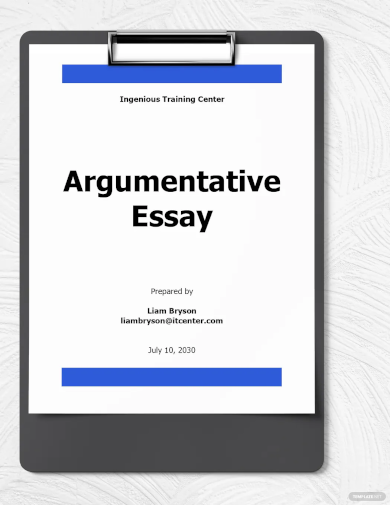
- Google Docs
Size: 88 KB
2. 5-Paragraph Essay Writing Example
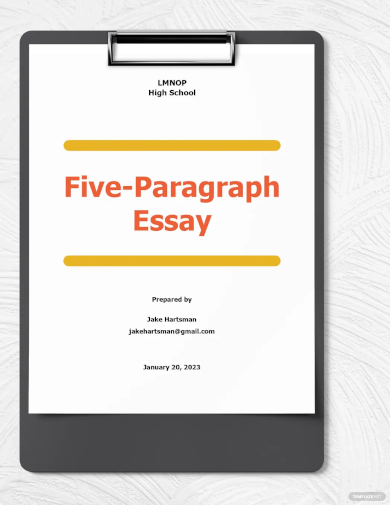
Size: 94.8 KB
3. Character Analysis Writing Essay Outline
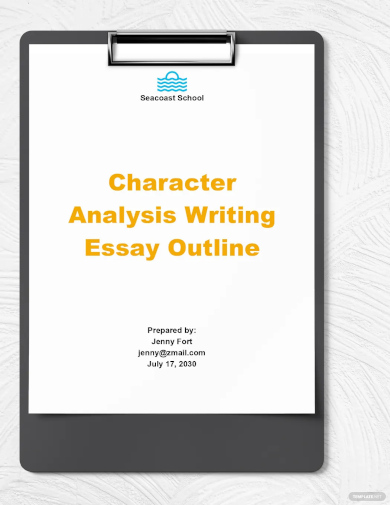
Size: 24.4 KB
4. Free Essay Writing Plan Example
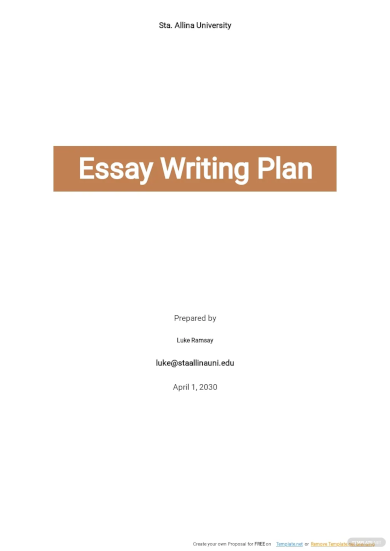
- Apple Pages
5. Argumentative Essay Writing Middle School
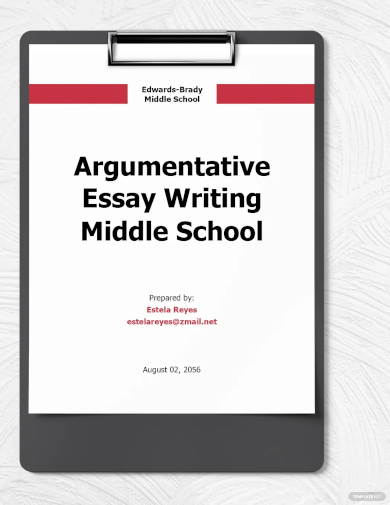
Size: MS Word, Google Docs
6. Example of Essay Writing Format
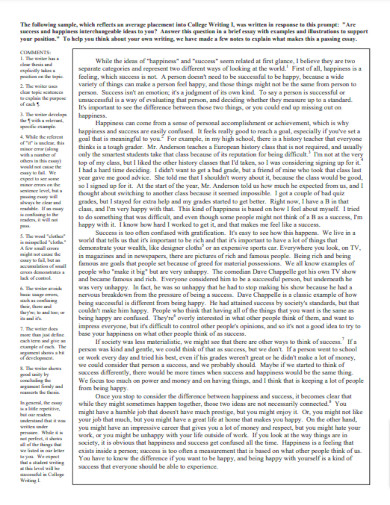
Size: 26 KB
7. Composition Essay Writing Example
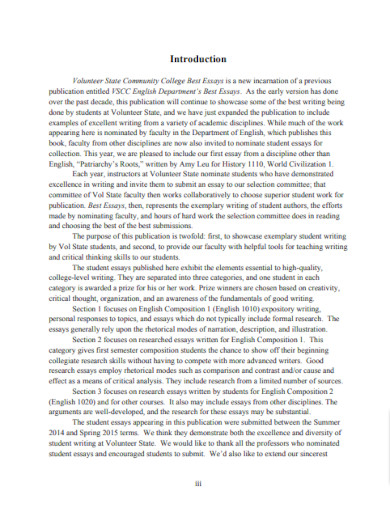
volstate.edu
Size: 425 KB
8. Photo Essay Writing Example
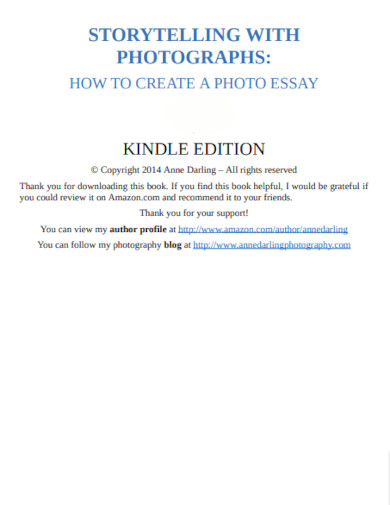
9. Essay Writing Example For Students
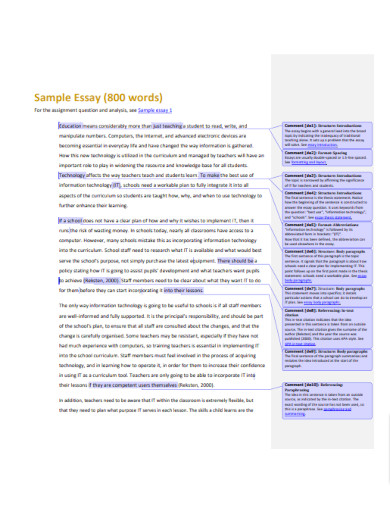
owll.massey.ac.nz
Size: 246 KB
10. Argumentative Essay Writing Example
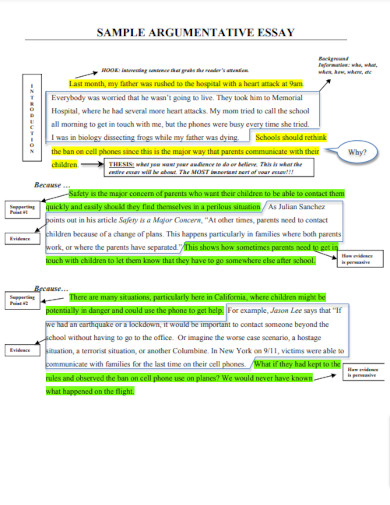
mrvattahamber.files.wordpress.com
Size: 121 KB
11. Academic Essay Writing Example
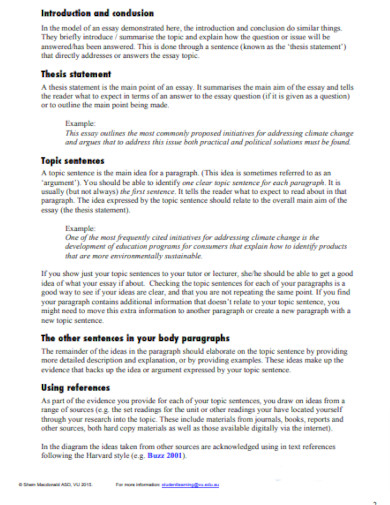
Size: 562 KB
12. Advanced Essay Writing Example
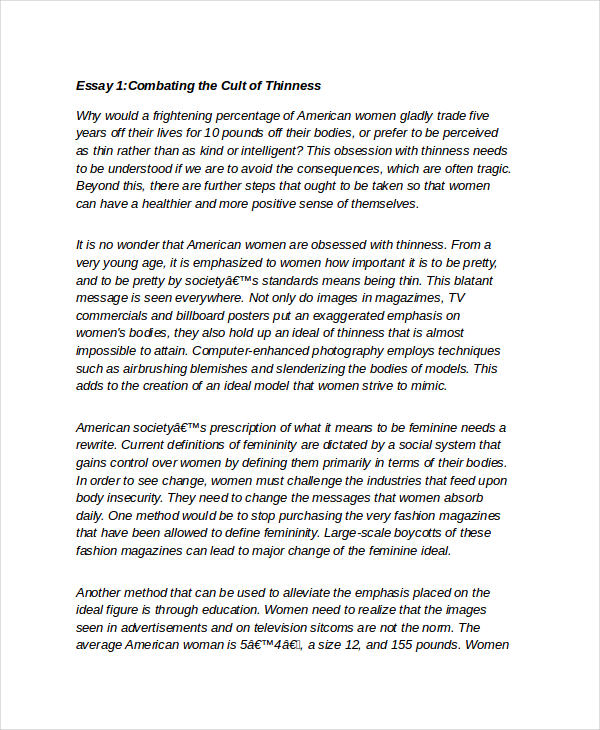
13. Critical Essay Writing Example

Size: 78 KB
14. Descriptive Essay Sample Example
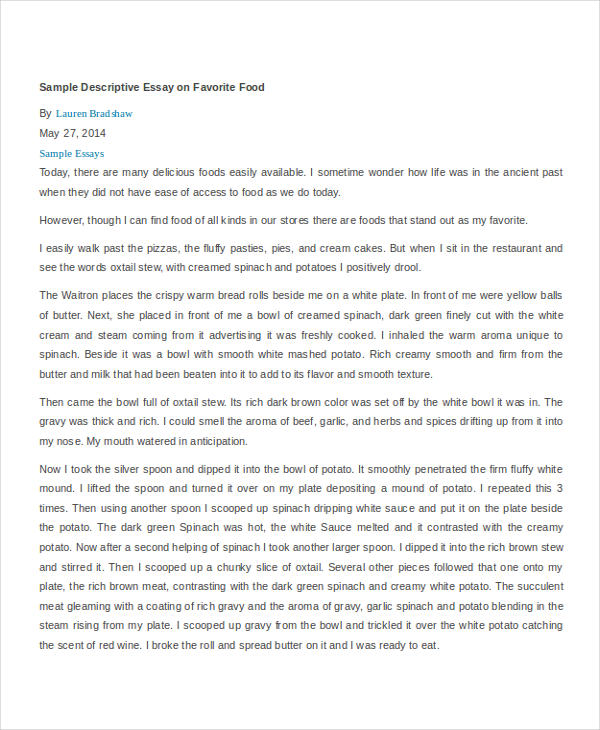
15. Education Essay Writing Example
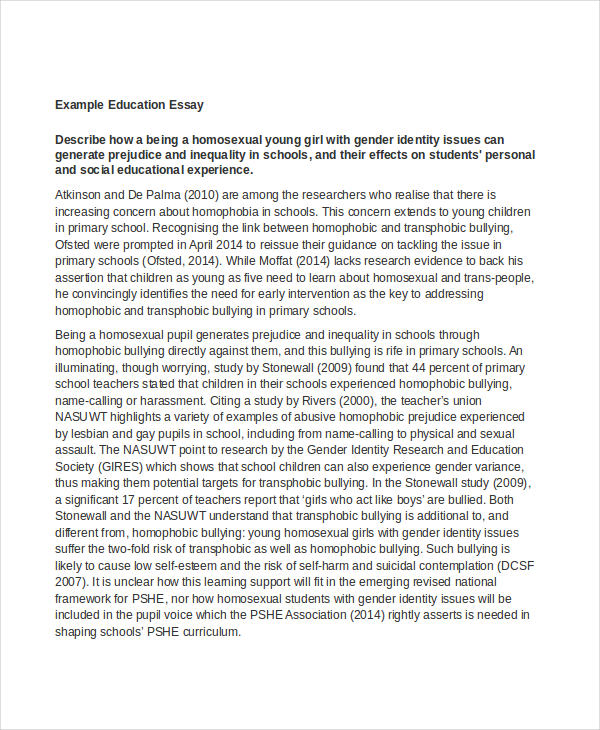
What to Include in a Creative Essay
Creative essay writing is simply freestyle writing. It’s about being open-minded and imaginative with your thoughts. There are no exact rules being set but instead, it takes on a more narrative writing approach to the standard essay writing. It is an informal type of essay writing as opposed to those of formal writing examples, such as in argumentative college application examples , in essay writing. Creative essays must have a topic. It may be about personal experiences or fictional beliefs. Make sure that the essay has a purpose, to either inform or entertain readers with interesting details. Although this isn’t the standard way of writing, it’s still important to emphasize the point of your essay.
16. Self-Evaluation Essay Example
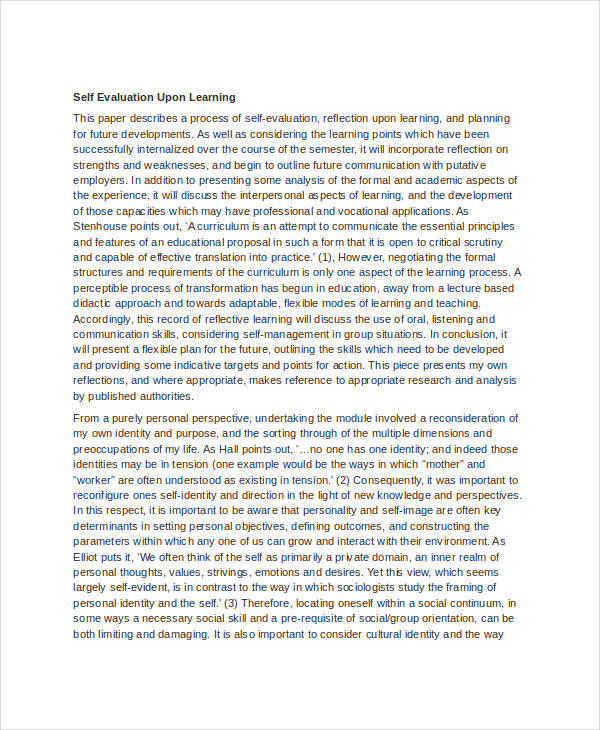
Size: 13 KB
17. Leadership and Profile Essay Writing

Size: 103 KB
18. Histographic Narrative Essay Sample Example
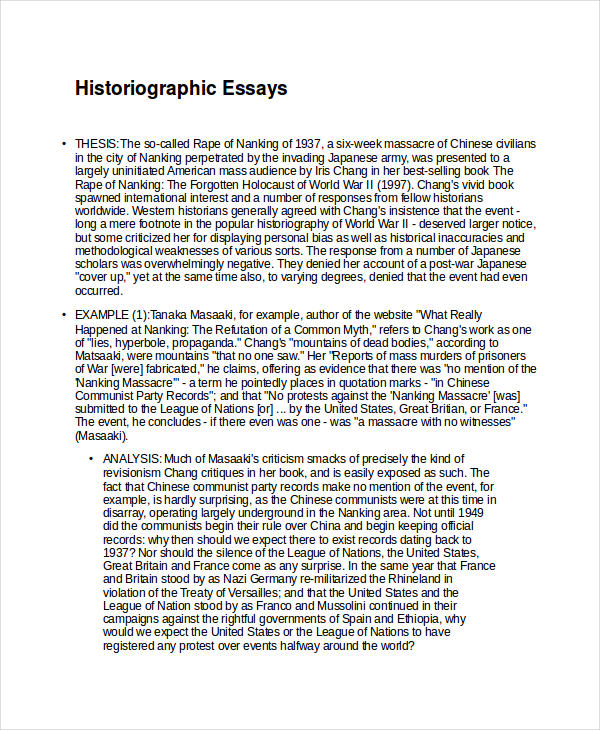
Size: 10 KB
19. Nursing Essay Writing Example
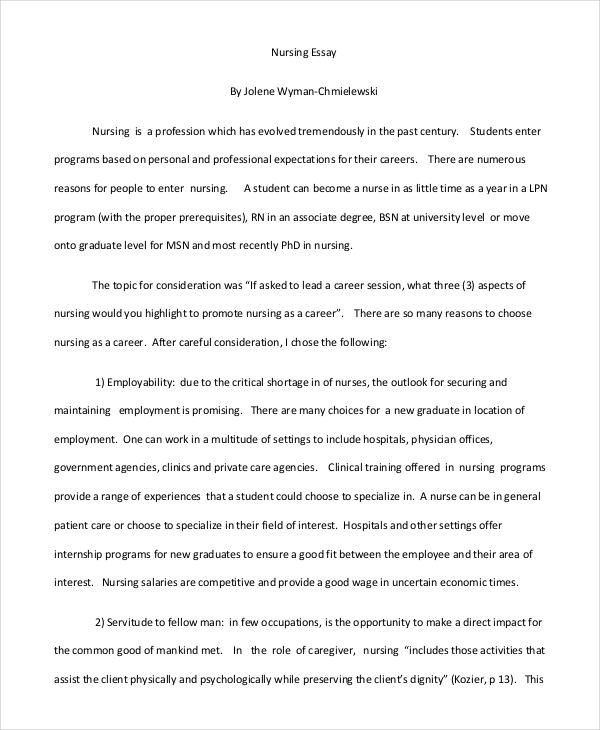
Size: 176 KB
What Is an Essay Outline?
An essay outline is a collection of thoughts and ideas relevant to the subject matter. It serves as a guide for writers to properly organize their thoughts into paragraphs. Writing templates are quite useful for essays with topics that are unfamiliar to the writer. It also allows the writer to properly reorganize points and research further on unclear statements. This will make it easier for the writer to emphasize important points properly.
20. Persuasive Application Essay Example

21. Short Personal Writing Example
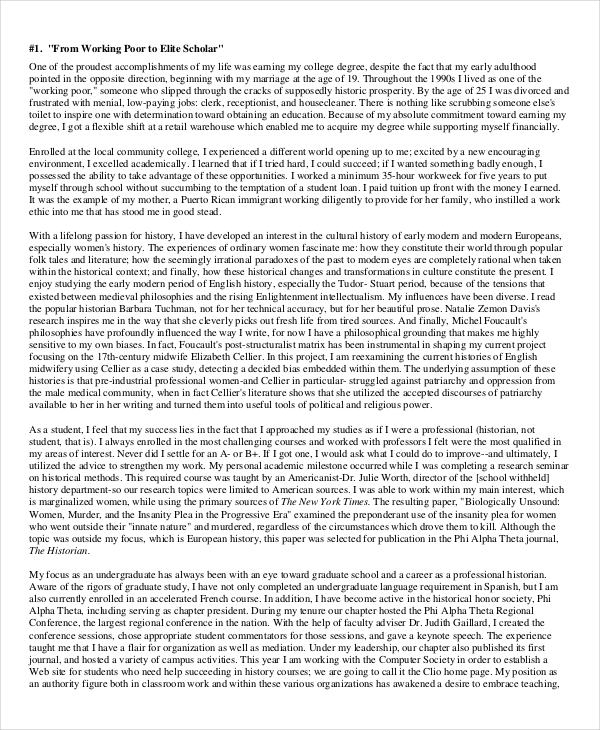
Size: 41 KB
22. Sample Vacation Writing Example
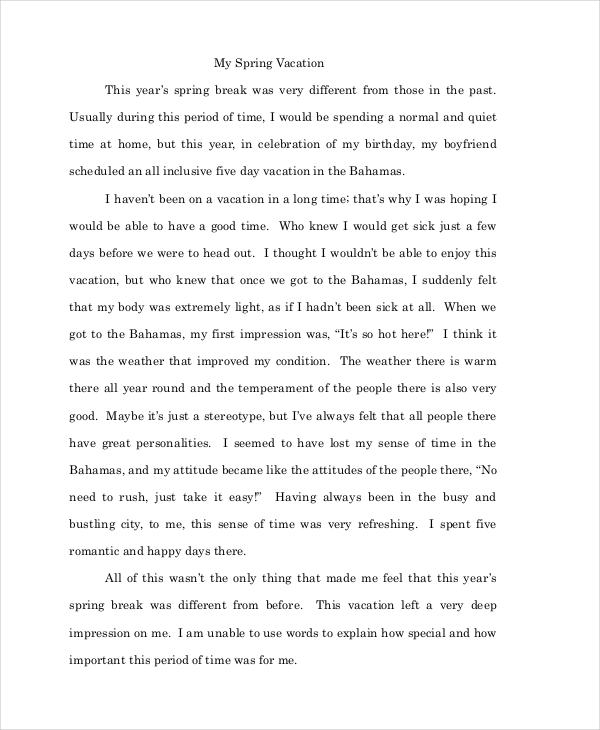
Size: 25 KB
Types of Essay Writing
- Narrative Essay : Tells a story, often personal, with a central theme or point.
- Descriptive Essay : Paints a picture using detailed observations and descriptions.
- Expository Essay : Provides factual information on a topic, explaining ideas without personal opinions.
- Persuasive Essay : Aims to convince the reader of a certain point of view or argument.
- Compare and Contrast Essay : Discusses similarities and differences between two subjects.
- Cause and Effect Essay : Explores the reasons (causes) for something and the results (effects) of those reasons.
- Problem-Solution Essay : Identifies a problem and proposes one or more solutions.
- Definition Essay : Explains the meaning of a term or a concept.
- Argumentative Essay : Presents a balanced view of a controversial issue, arguing for one side.
- Critical Essay : Analyzes the strengths, weaknesses, and methods of a certain subject, such as a piece of art or literature.
- Analytical Essay : Breaks down a concept or issue into its key components, examining them in detail.
- Process Essay : Gives step-by-step instructions on how to do something or how something is done.
- Reflective Essay : Shares the writer’s personal experiences or thoughts on a topic, reflecting on the deeper meaning.
How to Write an Essay? – Step by Step Guide
- Understand the Assignment: Carefully read the essay prompt or assignment instructions. Ensure you understand the topic, purpose, and any specific requirements, such as word count or formatting.
- Choose Your Topic : Sometimes you might have a topic assigned, or you may need to choose one. Pick a topic that interests you and can be explored in depth.
- Research Your Topic : Gather information from various sources like books, websites, or academic journals. Take notes to keep track of important points and references.
- Create a Thesis Statement : This is the main point of your essay. Your thesis statement should clearly state your position or the central argument of your essay.
- Outline Your Essay : Plan the structure of your essay. Typically, this includes an introduction, body paragraphs, and a conclusion.
- Write the Introduction : Start with a hook to grab the reader’s attention, followed by a few sentences leading to your thesis statement.
- Develop the Body Paragraphs : Each paragraph should focus on a single idea that supports your thesis. Start with a topic sentence, then add examples, evidence, and explanations.
- Write the Conclusion : Summarize your main points and restate your thesis in a new way. Provide a final thought or call to action to leave the reader with something to think about.
Do’s & Don’ts in a Essay Writing
Tips for writing an essay.
- Clear and Concise Topic : Choose a well-defined and concise topic for your essay. A focused topic makes it easier to convey your message effectively.
- Solid Thesis Statement : Craft a strong thesis statement that clearly states the main argument or purpose of your essay. This statement should be specific and debatable.
- Outline Your Essay : Before writing, create an outline with a clear structure, including an introduction, body paragraphs, and a conclusion. This will help you stay organized.
- Engaging Introduction : Start your essay with an engaging introduction that hooks the reader. You can use an anecdote, a surprising fact, or a relevant quote to grab attention.
- Well-Structured Body : Each body paragraph should have a clear topic sentence, supporting evidence, and a transition to the next point. Make sure your arguments flow logically.
- Use Strong Evidence : Back up your claims with strong evidence, examples, and relevant data. Quality evidence enhances the credibility of your essay.
- Effective Transitions : Use transitional words and phrases to connect ideas and paragraphs smoothly. This ensures that your essay flows coherently.
Why Is Essay Writing Important?
Essay writing skills is a difficult and time-consuming task. There’s more to it than mere writing, it involves researching and assembling of ideas. One may see it as a burden given by school teachers or college professors for extra credit, but we often fail to recognize how essay writing actually helps develop our logical thinking. Essay writing allows individuals to think critically and logically. Not only do you gain knowledge on a particular subject matter but you also learn how to express your thoughts through reasoning. The skills you’ll develop may even be useful in business writing. Some business writing examples include formal documents for reports and memos.
How do I start writing an essay?
To start writing an essay, first understand the assignment, choose a topic, create an outline, and craft a compelling introduction with a clear thesis statement.
What is a good sentence to start an essay?
A strong start to an essay could be: “In an age of rapid technological advancements, the impact of digitalization on society is undeniable, reshaping our lives in profound ways.”
What should an essay look like?
An essay typically comprises an introduction with a thesis statement, several body paragraphs presenting arguments with supporting evidence, and a conclusion summarizing key points and restating the thesis.
How do you start an introduction for an essay example?
Begin an essay introduction by grabbing the reader’s attention with a hook, offering background information on the topic, and concluding with a clear thesis statement that outlines your main argument.

Essay Generator
Text prompt
- Instructive
- Professional
Write an Essay on the role of community service in personal development.
Create an Essay about the impact of digital literacy on modern education.
Essay – examples & model answers | B2 First (FCE)
FCE Essay Examples: Topic (Environment)
Example exam task:, example answer (grade: 3), example answer:.
I think that my country has problems with pollution to the environment like all other countries. This problem is normal for Russia. We have big problems with transport because there are too much cars in our country. And because of that we have problems with atmospeer, air in my city and in all Russia is really dirty and sometimes I can’t make a sigh because it smells around me and of course around that cars on the road. I’ve heard about tradition of one country. They don’t go anywhere by car one day a month or a year, they just use bycicle or their feet. I think it could be very good if we had a tradition like that.
So, what about the rivers and the seas? Yeah, there are some really good and clean rivers and seas where you can go, but there are not many of them. Once I saw the river OB in my city, it was about two years ago but I stil remember that in some places it was not blue, it was green or purple I didn’t really understand because it had different colours.
I don’t know what should we do. Maybe we should just open our eyes and look what we did. But Russian people don’t care about the world around them many people care only about themselves an that’s all.
So, the best idea is look around and try to do something good for our planet and for us and our children.
FCE, CAE, CPE
Practice, write & improve, examiners comments & grade:, example answer (grade: 3-4).
To begin with pollution and damage to the environment is the most serious and difficult problem for countries of all over the world. Scientists of different countries predict a global ecocatastrophe if people won’t change their attitude to our planet.
First of all a huge damage to the environment brings a transport. People can’t imagine their living without cars, buses, trains, ships and planes. But it’s an open secret that one of disadvantage of these accustomed things is harmful exhaust. Needless to say that use of environment friendly engines helps us to save atmosphere from pollution.
In addition to this our rivers and seas are in not less danger situation. It’s a fact of common knowledge that numerous factories and plants pour off their waste to ponds. Obviously that cleaning manufacturing water helps to avoid extinction of ocean residents.
Apart from this I’m inclined to believe that every person can and must contribute to solving this important problem. Doing a little steps for protection our environment every day we will be able to save our Earth. And it’s a task of each of us.
Model Answer (Grade: 5)
DEVELOPMENT VS ENVIRONMENT
If we surf the web looking for pollution and environmental catastrophes, we will find out that every country in the world suffers them. This is a natural consequence of the struggle between development and environment.
If a country decided to live isolated from the rest of the world, living on what it can naturally grow and produce, it surely wouldn’t be highly polluted. But we all want exotic food and technological items from all over the world, so we have to pay the price.
Investing on electrical transport would benefit the environment a lot. Even more if this electricity came from a natural source of energy like wind, rivers and solar boards. It’s difficult to achieve this because petrol companies will fight against these actions.
We also have to take care of our rivers and seas. We all have heard about factories throwing highly toxic substances to rivers, without minimizing their poisoning effects. A really strict law should be applied to fine these factories and make them change their policy.
But what about ourselves? We also can do a lot! If, when possible, we bought larger packs of food, we would be producing less rubbish. And this is only an example!
FCE Essay Examples: Topic (Fashion)
In today’s world, the fashion industry has a strong importance in people’s lives. The fashion industry say to the society what to wear and creates new types of clothes all the time.
Some people claim that the fashion industry has a bad effect on people’s lives, they say that the fashion industry creates clothes that the society has to wear. Furthermore, the clothes’ price is extremely high and people, who can’t afford it, should not be in the society.
In the other hand, the fashion industry guide the people to be in a good appearance, because, nowadays, the appearance of the person is more important than the person itself.
In my opinion, the fashion industry doesn’t has a bad influence on people’s lives. It’s something which was created to help people what to wear.
Example Answer (Grade: 4)
Fashion industry is very a discussed subject nowadays: they create and design new clothes everyday in order to satisfy some people needs.
There are many people who claim that the fashion industry is important and good for society. According to them, this industry design beautiful clothes and thanks to that every person can wear shirts, trousers or any acessory which is on today’s fashion.
On the other hand, the fashion industry in some people opinion, controls the market of clothes and because of that they can’t wear what they want to. In addition, the industry can increase the price of clothes, forcing people who don’t want to be “oldfashioned” to buy and pay a large amount of money to keep “beautiful”.
In my opinion, we can’t let the fashion industry decide what we must or musn’t wear. We shouldn’t judge people for its appearance,because that is not important. We must wear whatever we like, want and feel confortable with.
The society we live today is characterised by technology in constant development, fast speed processes, information travelling and getting to people at a blink of an eye and a complex web of social networking. In this context, the fashion industry is becoming increasingly important and having a more and more paramount role in our lives.
On one hand, the fashion industry is undeniably a source of profit and income. It hires millions of people all over the world and generates millions of dollars every year. Furthermore, such profitable business is also believed to be able to spread and make known the culture of a people, encouraging and enhancing a better understanding of each other.
Nevertheless, for those who are neither impressed nor motivated by numbers and figures, the fashion industry is seen as one which segregates people, isolating those who not fit their laws and commands. It is stated that people place too much importance on appearance and the material, world, sadly true, and the fashion industry just spurs on such situation. Moreover, not only are the costs of fashion item unrealistically high, it is thought to be a money better spent on more pressing issues, such as poverty and hunger.
I do believe that the fashion industry, as it is today, has a harmful effect, because it values a minority of people in detriment to the majority. However, it has such a wide reach that, it put into a good use, it can save lives.
FCE Essay Examples: Topic (Languages)
“There are more reasons to learn a foreign language than to pass a test”
Everything around us revolves around language(s), it is the most important thing in our lives. Society would just not function without it. They are It is our future and I would personaly love to learn as many as I possibly can.
Not everything in life is done because it is necessary. Learning a new language can be a lot of fun. Many people only do it as a hoby, or their knowledge is something that brings them pride and pleasure.
Secondly, we have people who do it simply to challenge themselves. Truly I believe that having a great outcome that stems from your hard work and dedication to learn something new is a wonderful way to challenge prove your ability to yourself and others. Then there is travelling. It is very important to be able to understand and have a conversation with someone abroad, unless you would like to get lost or worse.
To conclude, I think that learning a new language is an amazing thing no matter why you do it. It is always better to do things out of enjoyment, but even if you do it for a test, that knowledge will always be useful.
Learning a a foreign languages is very important nowadays. English, in particular, is essential because it allows is spoken all over the world. That’s the reason why we start studying it from the age of six years old. Going abroad and being able to speak to native people is very satisfying and that’s why I want to improve my knowledge about foreign languages.
I decided to take this exam to know how high my level of English is, but also because I need this certification to go abroad next summer. I really want to come back to Cornwall, an amazing region in the South-West of England. I’ve been there twice with my family, but now I want to go alone. Only being there to England I can really improve my English comprehension and speaking skills.
Fortunately I can will have some English lessons which taught in English at university and I can’t wait for it because it will be an interesting challenge for me. Studying foreign languages is essential to live and to travel. It isn’t simple and I surely have to challenge myself everyday, but the result is so satisfying that we I can’t do without it.
FCE Essay Example: Topic (History)
A very common topic that is being discussed nowadays is wether schools should teach subjects that some may consider useless later in life. A clear example is history, since it is quite difficult to learn and does not help us in day-to-day activities.
However, many people do not realize the importance of it or that it affects our lives today. For example, our political system would not be this way if it weren’t for the Ancient Greeks, numerous politicians and wars who helped shape democracy and our constitution. Yet it is still thought that it’s useless.
In addition, it is very important that we never forget about our past since we must know where we were standing years ago. Moreover, there are some things, such as World War II, that we have to remember to prevent them from happening again. We should also know where we we were standing a century ago: our origins, our identity. The more you learn about your ethnicity, the better.
All in all, I think that it is extremely important to learn about one’s own country’s history. Anyone who gets the chance to do this should not waste it, since they are very fortunate to have this opportunity
Would you pass B2 First (FCE)?
- Wed. Apr 3rd, 2024
English Syllabus Guru
Your Ultimate English Syllabus Learning Resource
Guide to Good and Bad Writing with Examples
By Waqas Sharif
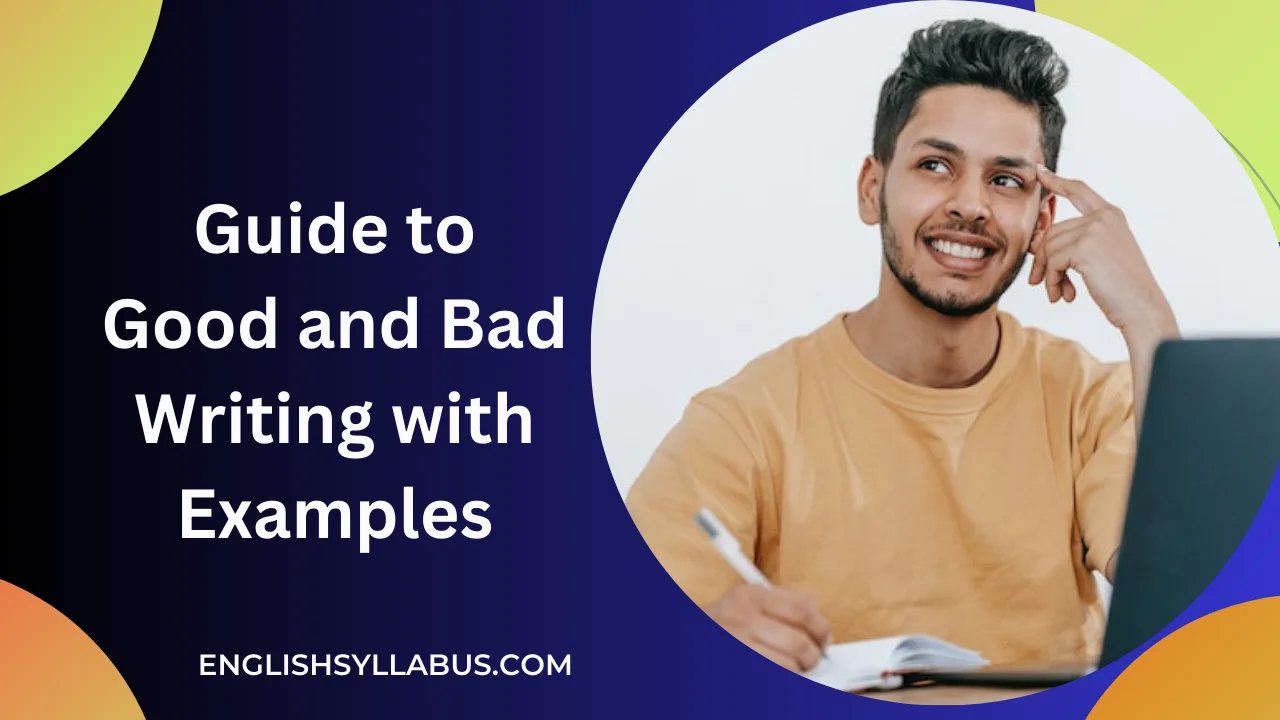
Writing is a beautiful art, but like any other art, it takes practice to master. There are many different styles of writing, each with its own set of rules and guidelines. However, there is one thing that is universal when it comes to writing, and that is the difference between good and bad writing. Good writing is clear, concise, and engaging, while bad writing is confusing, rambling, and boring. In this comprehensive guide, we will explore the good, the bad, and the ugly of writing. We will provide you with examples of both good and bad writing, and show you how to identify the difference between them. Whether you are a professional writer or just starting out, this guide will help you improve your writing skills and produce high-quality content.
1. Introduction
Welcome to “The Good, The Bad, and The Ugly: A Comprehensive Guide to Good and Bad Writing with Examples”. Writing is a complex art, and everyone has their own style and preferences. While there is no single correct way to write, there are certain standards that can help you produce better writing.
In this guide, we will explore some of the best examples of good writing and highlight some of the common pitfalls of bad writing. Whether you are an aspiring writer or just looking to improve your everyday writing, this guide is for you.
We will start with the basics of good writing, such as clarity, conciseness, and coherence , and then move on to more advanced topics like tone, voice, and style. We will also examine some of the most common mistakes that writers make, such as spelling and grammar errors, cliches, and poor sentence structure.
Throughout the guide, we will provide examples of both good and bad writing, so you can see the principles in action. We hope that by the end of this guide, you will have a better understanding of what makes good writing and how to avoid common mistakes. So, let’s get started!
2. The qualities of good writing
Good writing is clear, concise, and to the point. It should be easy to read and understand, without the reader having to struggle to decipher the meaning. Sentences should flow naturally from one to the next, and the writing should be free from grammatical errors and typos.
Additionally, good writing should be engaging and interesting to read. It should capture the reader’s attention and keep them interested throughout. This can be achieved through the use of descriptive language, powerful imagery, and storytelling techniques.
Good writing should also be well-researched and accurate. Any claims made should be supported by evidence, and sources should be cited where necessary.
Finally, good writing should be tailored to the audience. It should take into account the reader’s level of understanding and use language that is appropriate for them. It should also be written in a style that is appropriate for the subject matter, whether that be formal or informal.
Overall, good writing is about communicating effectively with the reader in a way that is engaging, accurate, and tailored to their needs.
3. Examples of good writing
Good writing is always a pleasure to read, it flows easily and is easy to understand. It conveys the message in a clear and concise manner. Here are a few examples of good writing that you can learn from:
It does not do well to dwell on dreams and forget to live. J.K. Rowling, Harry Potter, and the Philosopher’s Stone
This sentence is an excellent example of good writing, as it is short and precise, yet conveys a powerful message. It tells the reader that it is important to live in the present and not get lost in thoughts and dreams.
In three words I can sum up everything I’ve learned about life: It goes on. Robert Frost
This quote is an excellent example of good writing, as it is simple and powerful. It tells the reader that no matter what happens in life, it always continues and we must move on.
The only way to do great work is to love what you do. Steve Jobs
This sentence is an excellent example of good writing, as it is short and to the point. It conveys a powerful message about the importance of passion in work and life. These examples show how good writing can be simple, precise, and powerful. By focusing on clarity and brevity, you can convey your message effectively and leave a lasting impact on your readers.
4. The pitfalls of bad writing
Bad writing can be detrimental to your message and your brand. It can cause confusion, and frustration, and even turn off potential customers. One of the biggest pitfalls of bad writing is poor grammar and incorrect spelling. This can make your writing difficult to read and understand, and it can also make your business look unprofessional.
Another common pitfall of bad writing is using overly complicated language and technical jargon. While it may make you sound smart, using terminology that your audience doesn’t understand can lead to confusion and disinterest.
Lack of clarity is also a common trap of bad writing. If your message is confusing or unclear, your readers will quickly lose interest and move on. Your writing should be clear, concise, and easy to follow.
Finally, a lack of originality can also be a pitfall of bad writing. Copying content from other sources without proper attribution or creating content that is too similar to what’s already out there can make your brand seem unoriginal and uncreative.
Avoiding these pitfalls is crucial to effective writing. Your writing should be clear, concise, and engaging, and it should reflect your brand’s unique voice and personality. By avoiding the pitfalls of bad writing, you can create content that stands out and resonates with your audience.
5. Examples of bad writing
As much as we strive for excellence in our writing, sometimes we fall short and produce bad writing. Here are some examples of common mistakes that contribute to bad writing: 1. Run-on sentences: “I woke up this morning, got dressed in a hurry because I was running late for work, grabbed a cup of coffee, spilled it on my shirt, changed my shirt, and then rushed out the door.” 2. Overuse of adjectives: “The beautiful, stunning, picturesque sunset was a breathtaking sight to see.” 3. Use of cliches: “He was as cool as a cucumber.” 4. Poor grammar: “Me and my friends went to the store.” 5. Lack of clarity: “The thing that happened was really bad.” 6. Use of jargon: “The synergistic approach to our marketing strategy was not conducive to our ROI.” These are just a few examples of bad writing that should be avoided at all costs. Remember, good writing is clear, concise, and engaging.
6. How to improve your writing
Time needed: 10 minutes
Improving your writing is an essential part of being a good writer. Whether you’re crafting a novel, writing a blog post or even just sending an email, good writing skills are important in making sure your message is communicated effectively. Here are some tips to help you improve your writing:
The more you read, the more you’ll learn about writing styles, structure, and grammar. Read books, articles, and blogs in your niche and outside it to help broaden your understanding.
Practice makes perfect, so write as often as you can. Even if you’re just jotting down a few sentences every day, you’ll be developing your skills over time.
Sharing your work with others can be scary, but it’s a great way to get constructive criticism. Join a writing group or find a trusted friend or family member who can give you honest feedback.
First drafts are rarely perfect, so be prepared to edit and revise your work. Cut out unnecessary words, rephrase sentences to make them clearer, and make sure your grammar and punctuation are correct.
There are many online tools available that can help you improve your writing, from grammar checkers to writing prompts. Use them to your advantage to help you spot errors and improve your skills.
Improving your writing takes time and effort, but by following these tips and continuing to practice, you’ll soon see a noticeable improvement in your writing style and ability.
7. The importance of editing
Good writing is not just about writing itself, but also about the editing process. Editing is the most crucial part of writing, and it is the process where you can turn a good piece of writing into a great one. Editing helps to refine your writing, making it clearer, more concise, and more readable.
When you are editing your work, you need to look at several things, such as the structure of your writing, the flow of ideas, the tone of your writing, grammar, punctuation, and spelling errors. These are all essential elements of good writing, and if you do not pay attention to them, your writing may not be as effective as you wanted it to be.
The editing process is not just about correcting mistakes; it is also about making sure that your writing is compelling and engaging to your readers. You need to make sure that your ideas flow logically and that your readers can follow your arguments easily. It is also important to make sure that your writing style is consistent throughout your work.
So, editing is an essential part of good writing, and it is a skill that can be learned and improved. So, take the time to edit your work carefully and make sure that your writing is the best it can be.
8. The role of feedback in improving your writing
Feedback is an essential part of improving your writing. Whether you are just starting out or have years of experience, you can always benefit from constructive criticism. Getting feedback from others allows you to see your work from a different perspective, identify areas for improvement, and gain valuable insights into how readers perceive your writing. One of the best ways to get feedback is to join a writing group or workshop. These groups provide a supportive environment where you can share your work with others and receive feedback on your writing. They can also help you develop your skills, learn new techniques, and gain inspiration from other writers. Another great way to get feedback is to ask friends, family, or colleagues to read your work and provide feedback. This can be particularly helpful if you are writing for a specific audience or purpose, as they can offer insights into what works and what doesn’t. When receiving feedback, it’s important to approach it with an open mind and a willingness to learn. Don’t be defensive or dismissive of criticism, but instead, use it as an opportunity to grow and improve your writing. Take note of the feedback you receive and use it to make changes to your work. Finally, it’s important to remember that feedback is subjective. Not everyone will agree on what makes good or bad writing, and you may receive conflicting advice. Ultimately, it’s up to you to decide what changes to make and how to improve your writing. Use feedback as a tool to help you achieve your writing goals, but don’t let it dictate the direction of your work.
9. The importance of reading widely and critically
One of the most important things that any aspiring writer can do is to read widely and critically. By doing so, you’ll be able to see firsthand what works and what doesn’t work in writing. This includes everything from sentence structure and word choice to the pacing of a story and character development.
Reading widely also exposes you to different genres and styles of writing, which can help you develop your own unique voice. For example, if you’re interested in writing mystery novels, it’s important to read widely within that genre to see what techniques successful mystery writers use to keep their readers engaged.
However, it’s not enough to simply read widely – you also need to read critically. This means examining the choices that the writer made and thinking about why they made those choices. For example, if you’re reading a novel and you notice that the author uses short, choppy sentences during an action scene, ask yourself why they made that choice. Was it to create a sense of urgency? To make the scene feel more chaotic?
By reading widely and critically, you’ll develop a deeper understanding of the craft of writing, which will in turn make you a better writer. So the next time you pick up a book, take the time to analyze what the author is doing and think about how you can apply those techniques to your own writing.
10. Conclusion
In conclusion, good writing is a skill that can be learned and perfected with practice and dedication. The key to good writing is clarity, coherence, and conciseness. Your message should be clear, your thoughts should flow smoothly, and unnecessary words or phrases should be avoided. Good writing engages readers, creates a connection with them, and leaves a lasting impression. On the other hand, bad writing is often characterized by poor grammar, spelling mistakes, and a lack of structure. It can be confusing, difficult to follow, and ultimately fail to convey the intended message. Bad writing can be a turn-off for readers and may even harm your credibility and reputation. Remember, the way you write reflects who you are as a person or a brand. Whether you’re writing an email, a blog post, or a social media update, always strive for good writing. Take the time to proofread and edit your work, and seek feedback from others to improve. With these tips and examples in mind, you can become a better writer and communicate more effectively with your audience.
We hope that our comprehensive guide to good and bad writing has been helpful. Writing is a craft that takes time and practice to master, but by following the tips in this article, you can improve your writing skills and avoid common mistakes. Remember, good writing is clear, concise, and engaging, while bad writing is confusing, poorly structured, and uninteresting. We included examples of both good and bad writing to help you better understand what to do and what not to do. Keep practicing and refining your writing skills, and you’ll be able to communicate your ideas and thoughts more effectively.
Share this:

Mr. Waqas Sharif is an English Language Teaching (ELT) Professional, Trainer, and Course Instructor at a Public Sector Institute. He has more than ten years of Eng Language Teaching experience at the Graduate and Postgraduate level. His main interest is found in facilitating his students globally He wishes them to develop academic skills like Reading, Writing, and Communication mastery along with Basics of Functional Grammar, English Language, and Linguistics.
Related Post
On writing well, the classic guide to writing nonfiction pdf, writing that works pdf – download, how to write strong thesis statements for your ielts essays, leave a reply cancel reply, speed reading tips: how to read faster and recall more, 10 days to faster reading by abbymarks beale, writing tools: 55 essential strategies for every writer.
- ALL PREPARATION PDFs
Bad College Essay Examples to Avoid When Writing Your Essay
In as much as there are some good examples of college essays available, there are also some bad college essay examples that you will need to avoid when writing your essay. Well, with the aid of this article, you would see some of the bad college essay examples to guide you in writing your masterpiece.
The application essay , sometimes called the personal statement, can be an applicant’s main shot at showcasing their personality and grabbing the admissions officer’s attention. Selecting the right essay topic is important, and it can be tough to know where to start.
What Makes a Bad College Essay
What exactly happens to turn a college essay terrible? Just as great personal statements combine an unexpected topic with superb execution, flawed personal statements compound problematic subject matter with poor execution. Below are some of the points that make an essay bad;
The primary way to screw up a college essay is to flub what the essay is about or how you’ve decided to discuss a particular experience. Badly chosen essay content can easily create an essay that is off-putting in one of a number of ways I’ll discuss in the next section.
The essay is the place to let the admissions office of your target college get to know your personality, character, and the talents and skills that aren’t on your transcript . So if you start with a terrible topic, not only will you end up with a bad essay, but you risk ruining the good impression that the rest of your application makes.
Reasons why choosing the wrong topic could be a problem;
- Some bad topics show admissions officers that you don’t have a good sense of judgment or maturity.
- Other bad topics suggest that you are a boring person.
- Still, other bad topics indicate that you’re unaware of or disconnected from the outside world and focused only on yourself.
2. The Body Essay Execution
Sometimes, even if the experiences you discuss could be the foundation of a great personal statement, the way you’ve structured and put together your essay sends up warning flags. This is because the admissions essay is also a place to show the admissions team the maturity and clarity of your writing style.
Things to avoid;
- Avoid exhibiting very faulty writing mechanics.
- Avoid ignoring prompt instructions either for creative or careless reasons.
College Essay Topics To Avoid
Want to know why you’re often advised to write about something mundane and every day for your college essay ? That’s because the more out-there your topic, the more likely it is to stumble into one of these trouble categories.
1. Too Personal
The problem with the overly personal essay topic is that revealing something very private can show that you don’t understand boundaries. And knowing where appropriate boundaries are will be key for living on your own with a bunch of people not related to you.
- Describing losing your virginity, or anything about your sex life.
- Writing in too much detail about your illness, disability, any other bodily functions.
- Waxing poetic about your love for your significant other.
- Confessing to odd and unusual desires of the sexual or illegal variety.
2. Too Revealing of Bad Judgment
Generally speaking, leave past illegal or immoral actions out of your essay . It’s simply a bad idea to give admissions officers ammunition to dislike you.
- Writing about committing a crime as something fun or exciting.
- Describing drug use or the experience of being drunk or high.
- Making up fictional stories about yourself as though they are true.
- Detailing your personality flaws.
3. Too Overconfident
While it’s great to have faith in your abilities, no one likes a relentless show-off. No matter how magnificent your accomplishments, if you decide to focus your essay on them, it’s better to describe a setback or a moment of doubt rather than simply praising yourself to the skies.
- Bragging and making yourself the flawless hero of your essay.
- Having no awareness of the actual scope of your accomplishments.
4. Too Clichéd or Boring
Remember your reader. In this case, you’re trying to make yourself memorable to an admissions officer who has been reading thousands of other essays. If your essay makes the mistake of being boring or trite, it just won’t register in that person’s mind as anything worth paying attention to.
- Transcribing your resume into sentence form or writing about the main activity on your transcript.
- Writing about sports.
- Being moved by your community service trip to a third-world country.
- Reacting with sadness to a sad, but very common experience.
- Going meta. Please don’t write about the fact that you’re writing the essay as we speak, and now the reader is reading it, and look, the essay is right here in the reader’s hand. It’s a technique that seems clever but has already been done many times in many different ways.
- Offering your ideas on how to fix the world. This is especially true if your solution is an easy fix if only everyone would just listen to you. Trust me; there’s just no way you are being realistically appreciative of the level of complexity inherent in the problem you’re describing.
- Starting with a famous quotation. There usually is no need to show up your own words by bringing in someone else’s. Of course, if you are writing about a particular phrase that you’ve adopted as a life motto, feel free to include it. But even then, having it be the first line in your essay feels like you’re handing the keys over to that author and asking them to drive.
- Using an everyday object as a metaphor for your life/personality.
5. Too Off-Topic
Unlike the essays you’ve been writing in school where the idea is to analyze something outside of yourself, the main subject of your college essay should be you, your background, your makeup, and your future. Writing about someone or something else might well make a great essay, but not for this context.
- Paying tribute to someone very important to you.
- Documenting how well other people do things, say things, are active, while you remain passive and inactive in the essay.
- Concentrating on a work of art that deeply moved you.
Bad college Essay Examples
These are some of the bad college essay examples, which you should read carefully and take notes of some of their mistakes;
Essay #1: The “I Once Saw Poor People” Service Trip Essay
Unlike other teenagers, I’m not concerned about money, or partying, or what others think of me. Unlike other eighteen-year-olds, I think about my future and haven’t become greedy and acquisitive. My whole outlook on life changed after I realized that my life was just being handed to me on a silver spoon , and yet there were those in the world who didn’t have enough food to eat or place to live. I realized that the one thing that this world needed more than anything was compassion; compassion for those less fortunate than us. During the summer of 2006, I went on a community service trip to rural Peru to help build an elementary school for kids there. I expected harsh conditions, but what I encountered was far worse. It was one thing to watch commercials asking for donations to help the unfortunate people in less developed countries, yet it was a whole different story actually to live it. Even after all this time, I can still hear babies crying from hunger; I can still see the filthy rags that they wore; I can still smell the stench of misery and hopelessness. But my most vivid memory was the moment I first got to the farming town. The conditions of it hit me by surprise; it looked much worse in real life than compared to what our group leader had told us. continue reading… Poverty to me and everyone else I knew was a foreign concept that people hear about on the news or see in documentaries. But this abject poverty was their life, their reality. And for the short ten days, I was there, it would be mine too. As all of this realization came at once, I felt overwhelmed by the weight of what was to come. Would I be able to live in the same conditions as these people? Would I catch a disease that no longer existed in the first world, or maybe die from drinking contaminated water? As these questions rolled around my already dazed mind, I heard a soft voice asking me in Spanish, “Are you okay? Is there anything I can do to make you feel better?” I looked down to see a small boy, around nine years of age, who looked starved, and cold, wearing tattered clothing, comforting me. These people who have so little were able to forget their own needs, and put those much more fortunate ahead of themselves. It was at that moment that I saw how selfish I had been. How many people suffered like this in the world, while I went about life concerned about nothing at all? Thinking back on the trip, maybe I made a difference, maybe not. But I gained something much more important. I gained the desire to make the world a better place for others. It was in a small, poverty-stricken village in Peru that I finally realized that there was more to life than just being alive.
Essay #2: The “I Am Writing This Essay as We Speak” Meta-Narrative
Was your childhood home destroyed by a landspout tornado? Yeah, neither was mine. I know that intro might have given the impression that this college essay will be about withstanding disasters, but the truth is that it isn’t about that at all. In my junior year, I always had in mind an image of myself finishing the college essay months before the deadline. But as the weeks dragged on and the deadline drew near, it soon became clear that at the rate things are going I would probably have to make new plans for my October, November and December. Falling into my personal wormhole, I sat down with my mom to talk about colleges. “Maybe you should write about Star Trek,” she suggested, “you know how you’ve always been obsessed with Captain Picard, calling him your dream mentor. Unique hobbies make good topics, right? You’ll sound creative!” I played with the thought in my mind, tapping my imaginary communicator pin and whispering “Computer. Tea. Earl Grey. continue reading…
Hot. And then an Essay.” Nothing happened. Instead, I sat quietly in my room wrote the old-fashioned way. Days later I emerged from my room disheveled, but to my dismay, this college essay made me sound like just a guy who can’t get over the fact that he’ll never take the Starfleet Academy entrance exam. So, I tossed my essay away without even getting to disintegrate it with a phaser set on stun. I fell into a state of panic. My college essay. My image of myself in senior year. Almost out of nowhere, Robert Jameson Smith offered his words of advice. Perfect! He suggested students begin their college essay by listing their achievements and letting their essay materialize from there. My heart lifted, I took his advice and listed three of my greatest achievements – mastering my backgammon strategy, being a part of TREE in my sophomore year, and performing “I Am the Very Model of a Modern Major-General” from The Pirates of Penzance in public. And sure enough, I felt inspiration hit me and began to type away furiously into the keyboard about my experience in TREE, or Trees Require Engaged Environmentalists. I reflected on the current state of deforestation, and described the dichotomy of it being both understandable why farmers cut down forests for farmland, and how dangerous this is to our planet. Finally, I added my personal epiphany to the end of my college essay as the cherry on the vanilla sundae, as the overused saying goes. continue reading… After 3 weeks of figuring myself out, I have converted myself into a piece of writing. As far as achievements go, this was definitely an amazing one. The ability to transform a human being into 603 words surely deserves a gold medal. Yet in this essay, I was still being nagged by a voice that couldn’t be ignored. Eventually, I submitted to that yelling inner voice and decided that this was not the right essay either. In the middle of a hike through Philadelphia’s Fairmount Park, I realized that the college essay was nothing more than an embodiment of my character. The two essays I have written were not right because they have failed to become more than just words on recycled paper . The subject failed to come alive. Certainly my keen interest in Star Trek and my enthusiasm for TREE are a great part of who I am, but there were other qualities essential in my character that did not come across in the essays. With this realization, I turned around as quickly as I could without crashing into a tree.
Getting that admission into your college choice is just a step away. All you need to do is to follow the instructions given above that are on; bad college essay examples and avoid making that same mistake. GOOD LUCK.
Also, do well to share this link with all your friends and loved ones. That is on all your social media platforms.
Comments are closed.
RECENT POST
- Decoding Quantum Threats: Navigating Cryptocurrency Security in the Quantum Computing Era
- The Emergence of Security Tokens and Their Regulatory Terrain
- The Technology Behind Online Casinos: Ensuring Fair Play and Security
- Terra (LUNA): Stablecoins and DeFi Built on Bitcoin’s Foundation
- High-Tech Trading: The Revolutionary Impact of Advanced Cryptocurrencies in Oil Markets
- Diving Deep into Ocean Protocol: A Comprehensive OCEAN Guide
- Discovering Bitcoin: A Guide for the Unacquainted
- Exploring the World of Online Slot Tournaments: How to Compete and Win
- Opportunities and Strategies: Digital Yuan in the World of Mobile Payments
- The Rhythm of the Reels: Exploring Music Genres in Slot Game Design
- Unhealthy Relationship Selfish Parents Quotes
- What are Some Empowering Quotes from Pride and Prejudice?
- What are the Quotes about Fear of the Unknown?
- Heart Touching Good Morning Love Quotes
- FUTA Recruitment 2024/2025 Application Form & Updates
- Through Thick and Thin Quotes for Courage
- Hurting Quotes on Relationship
- Crescent University Recruitment 2024/2025 Application Form & Updates
- Trust Quotes for Relationships
- Grand Lead Heritage Recruitment 2024/2025 Application Form & Updates
- Advertise Here
- Privacy Policy
Currentschoolnews.com complies with the Digital Millennium Copyright Act and takes prompt action to remove infringing material upon receiving valid takedown notices. We respect intellectual property rights and expect our users to do the same.

Don't miss this opportunity
Enter Your Details

IMAGES
VIDEO
COMMENTS
Here's What Bad Writing Looks Like. Here's a passage of bad writing that I've created, based on a lot of common drafting mistakes. I'll split it into three parts, and go through the mistakes (and how to fix them) after each. Bad Writing Example #1 "Hi James," announced Jason, spotting him in the street.
Inappropriate Dialogue and Dialogue Tags. One common example of bad writing can be found in the execution of dialogue. Good writing involves creating conversations that sound natural and real. However, in some bestselling books, character conversations can feel forced or unnatural, leading to poor writing.
Going over the word limit. Part of showing your brilliance is being able to work within arbitrary rules and limitations. Going over the word count points to a lack of self-control, which is not a very attractive feature in a college applicant. Repeating the same word (s) or sentence structure over and over again.
Period. A bad essay will prompt an admission officer to assume one of two things: 1) either you don't care enough about your future at their school to take the time to write a good essay or 2) you aren't academically up to attending their college or university. Neither of those assumptions will help you get admitted.
Make sure that by the end of your essay, your reader knows what your opinion is. 3. The polemic. Try not to make your reader think of you shouting at them from a soapbox. The direct opposite of the "weighing scales" approach is the polemic. In this kind of essay, your reader is in no doubt at all about what your point of view is ...
Here are six tips that helped make my writing better (hopefully they help you, too!). 1. Read Out Loud. This is the first step to checking your piece for awkward writing: read it out loud. I wrote a post about this a while back, and it's still your best bet to check for awkward writing.
THE TOP TWENTY. 1. Wrong Word. Wrong word errors take a number of forms. They may convey a slightly different meaning than you intend ( compose instead of comprise) or a completely wrong meaning ( prevaricate instead of procrastinate ). They may also be as simple as a wrong preposition or other type of wrong word in an idiom.
Good college essay examples: these examples are solid. They do exactly what they need to do on the admissions committee floor. You're aiming to write a good college essay. "Bad" college essay examples: these examples illustrate a few of the most common college essay mistakes we see. Grades:
Table of contents. Essay 1: Sharing an identity or background through a montage. Essay 2: Overcoming a challenge, a sports injury narrative. Essay 3: Showing the influence of an important person or thing. Other interesting articles. Frequently asked questions about college application essays.
Sample College Essay 2 with Feedback. This content is licensed by Khan Academy and is available for free at www.khanacademy.org. College essays are an important part of your college application and give you the chance to show colleges and universities your personality. This guide will give you tips on how to write an effective college essay.
Let's give our readers an example of some bad college essay writing. Here is a sample paragraph from an essay. Tell us what you think is wrong with it in the Comments section below: Winning the race was a really big accomplishment for me. It made me really proud to stand on the podium and wave to the crowd, surrounded by so many people I love.
Part 8 - Examples of Good and Bad Writing. Learning to write often works best by example. The following are excerpts from nine first-year student essays. Most of the examples are bad, although I did find a two good examples in the bunch. In most cases, the names and dates from the essays have been changed to not compromise the subject matter ...
If you were Mary Shelley in the company of Byron and others, you amused each other by reading out loud, sharing a common interest in a particular book, and sharing with the others your own writing. In her introduction to Frankenstein, her explanation of how this extraordinary novel came to be was due, at least in part, to the weather and the ...
Let's dive into the top ten examples of bad grammar. 1. Subject-Verb Agreement. One of the worst grammatical errors is incorrect subject-verb agreement. It's important to make sure that the subject and the verb go together. You can think of it like a matching game.
Another article in the 'bad writing' series, 7 Features of Bad Writing suggests some common characteristics of poor prose. Any one of these 'sins' would serve as an indicator, especially if they occur more than once or twice. ... Plus links to examples of bad writing. Aug 3, 2023. Jun 22, 2022. What "interesting" REALLY means (or might do) Jun ...
Bad College Essay Examples. One of the best ways to figure out what you are going to write about is to cross things off of your list that simply won't work. TKG clients often come to us with essays that they want to rework and refine, but when the topic itself is problematic, we have no choice but to start over.
Bad writing. This is a short rogues' gallery of bad practice. It is short because we don't want to dwell on negative examples, but it exists to offer a few warnings and to explain how problems are often caused. Most of the items have been mentioned elsewhere in advice on what to avoid, or cautions of one kind or another.
This essay begins by discussing the situation of blind people in nineteenth-century Europe. It then describes the invention of Braille and the gradual process of its acceptance within blind education. Subsequently, it explores the wide-ranging effects of this invention on blind people's social and cultural lives.
Bad writing, example #4: Grandiosity. The point of writing is to express, not impress. Bad writing: Even after the doomsday of nuclear warfare, when all the known signs of life will be swept away ...
A bad college essay can suffer from several issues: 1. Poor grammar and punctuation: Proofread, proofread, proofread! No matter how great your story is, if it's plagued with grammar and punctuation errors, it gives the impression that you didn't put in the effort. Ask others to review your essay and use tools like Grammarly to catch any errors ...
A conclusion in essay writing summarizes key points, restates the thesis, and provides a final perspective, leaving a lasting impression. Purpose: Summarizes the essay and reinforces the thesis statement. Key Elements: Summary of Main Points, Restatement of Thesis and Final Thoughts. Essay Writing Topics, Ideas with Samples 1.
In your English class you have been talking about the fashion industry. Write an essay using all the notes and giving reasons for your point of view. Some people say the fashion industry has a bad effect on people's lives. Do you agree? Write about: 1. whether people's appearance is important. 2. the price of clothes. 3 ...
Here are some examples of common mistakes that contribute to bad writing: 1. Run-on sentences: "I woke up this morning, got dressed in a hurry because I was running late for work, grabbed a cup of coffee, spilled it on my shirt, changed my shirt, and then rushed out the door.". 2.
It's simply a bad idea to give admissions officers ammunition to dislike you. Examples: Writing about committing a crime as something fun or exciting. Describing drug use or the experience of being drunk or high. Making up fictional stories about yourself as though they are true. Detailing your personality flaws. 3.